AMD Ryzen 9 7900, Ryzen 7 7700, and Ryzen 5 7600 Review: Zen 4 Gets More Affordable
Lower power means much lower prices.
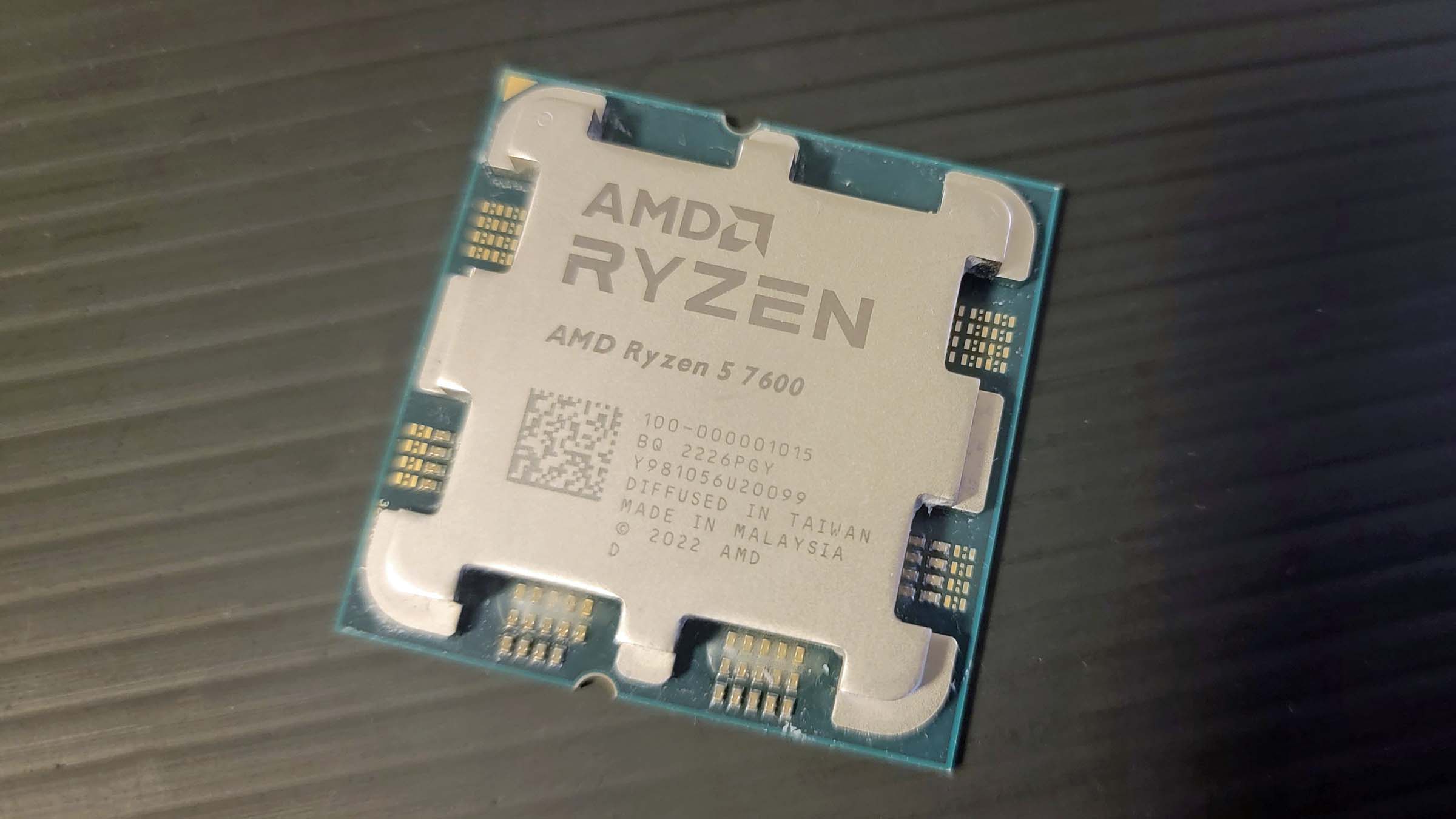
AMD's $429 twelve-core Ryzen 9 7900, $329 eight-core Ryzen 7 7700, and $229 six-core Ryzen 5 7600 come to market as the first 'Non-X' Ryzen models for the company's new AM5 platform for Zen 4 processors. As we've seen with AMD's previous-gen lower-power models, these 65W models offer the same core counts and cache as their full-fledged X-series counterparts but come with lower clock speeds and a lower price point.
After overclocking, the 65W models tend to offer nearly the same performance as the more expensive 'X' models, like the 7900X, 7700X, and 7600X, thus providing a less-expensive option for enthusiasts. AMD even throws in a bundled cooler with these chips, sweetening the deal as it looks to improve its rankings on the list of the Best CPUs for gaming and its price-to-performance ratio in our CPU benchmark hierarchy.
| Header Cell - Column 0 | Street/MSRP | Cores / Threads (P+E) | P-Core Base / Boost Clock (GHz) | Cache (L2/L3) | TDP / PBP / MTP |
|---|---|---|---|---|---|
| Ryzen 9 7900X | $474 ($549) | 12 / 24 | 4.7 / 5.6 | 76MB (12+64) | 170W / 230W |
| Ryzen 9 7900 | $429 | 12 / 24 | 3.7 / 5.4 | 76MB (12+64) | 65W / 88W |
| Ryzen 7 7700X | $349 ($399) | 8 /16 | 4.5 / 5.4 | 40MB (8+32) | 105W / 142W |
| Ryzen 7 7700 | $329 | 8 / 16 | 3.8 / 5.3 GHz | 40MB (8+32) | 65W / 88W |
| Ryzen 5 7600X | $249 ($299) | 6 / 12 | 4.7 / 5.3 | 38MB (6+32) | 105W / 142W |
| Ryzen 5 7600 | $229 | 6 / 12 | 3.8 / 5.1 GHz | 38MB (6+32) | 65W / 88W |
The 65W Ryzen 7000 models are sorely needed; AMD's AM5 ecosystem has been plagued by high motherboard pricing — particularly for the historically value-oriented B-series — and the strict requirement for DDR5 memory has been a nagging issue due to continued high pricing.
In contrast, you can use either DDR4 or DDR5 with Intel's Raptor Lake chips, with DDR4 providing less expensive memory and motherboard options for value seekers, plus Intel's downstream motherboards tend to be more affordable in general.
The 65W Ryzen 7000 chips help reduce the pricing pain for the AM5 platform, but the processor's price is just one factor when you select components for your build. Let's see how the new Ryzen chips fare.
Ryzen 5 7600, Ryzen 7 7700, Ryzen 9 7900 Specifications and Pricing
| Header Cell - Column 0 | Street/MSRP | Cores / Threads (P+E) | P-Core Base / Boost Clock (GHz) | E-Core Base / Boost Clock (GHz) | Cache (L2/L3) | TDP / PBP / MTP | Memory |
|---|---|---|---|---|---|---|---|
| Core i9-13900 / F | $549 - $529 (F) | 24 / 32 (8+16) | 2.0 / 5.6 | 1.5 / 4.2 | 68MB (32+36) | 65W / 219W | DDR4-3200 / DDR5-5600 |
| Ryzen 9 7900X | $474 ($549) | 12 / 24 | 4.7 / 5.6 | - | 76MB (12+64) | 170W / 230W | DDR5-5200 |
| Ryzen 9 7900 | $429 | 12 / 24 | 3.7 / 5.4 | 76MB (12+64) | 65W / 88W | DDR5-5200 | |
| Core i7-13700K / KF | $409 (K) - $384 (KF) | 16 / 24 (8+8) | 3.4 / 5.4 | 2.5 / 4.2 | 54MB (24+30) | 125W / 253W | DDR4-3200 / DDR5-5600 |
| Core i7-13700 / F | $384 - $359 (F) | 16 / 24 (8+8) | 2.1 / 5.2 | 1.5 / 4.1 | 54MB (24+30) | 65W / 219W | DDR4-3200 / DDR5-5600 |
| Ryzen 7 7700X | $349 ($399) | 8 /16 | 4.5 / 5.4 | - | 40MB (8+32) | 105W / 142W | DDR5-5200 |
| Ryzen 7 7700 | $329 | 8 / 16 | 3.8 / 5.3 GHz | 40MB (8+32) | 65W / 88W | DDR5-5200 | |
| Ryzen 5 7600X | $249 ($299) | 6 / 12 | 4.7 / 5.3 | - | 38MB (6+32) | 105W / 142W | DDR5-5200 |
| Ryzen 5 7600 | $229 | 6 / 12 | 3.8 / 5.1 GHz | 38MB (6+32) | 65W / 88W | DDR5-5200 | |
| Core i5-13600K / KF | $319 (K) - $294 (KF) | 14 / 20 (6+8) | 3.5 / 5.1 | 2.6 / 3.9 | 44MB (20+24) | 125W / 181W | DDR4-3200 / DDR5-5600 |
| Core i5-13400 / F | $221 - $196 (F) | 10 / 16 (6+4) | 2.5 / 4.6 | 1.8 / 3.3 | 29.5MB (9.5+20) | 65W /148W | DDR4-3200 / DDR5-4800 |
AMD defined several new TDP ranges with the Zen 4 family, and the first three Non-X models all come with a 65W base TDP and 88W power limit (PPT) under load. As such, these chips have much lower base clock speeds than their X-series counterparts, enabling them to fit into the lower TDP envelope.
AMD doesn't have a Non-X 16-core Ryzen 9 7950X model, so the 12-core 24-thread $429 Ryzen 9 7900 is the most powerful 65W chip. The Ryzen 9 7900 has a 3.7 GHz base clock, a full 1 GHz lower than the $474 Ryzen 9 7900X comparable, but it boosts to 5.3 GHz. That’s only 300 MHz lower than the 7900X, which is reasonable considering the 7900's 65W/88W power rating compared to the 7900X’s 170W/230W spec.
The rest of the 7900’s key specifications are identical to the 7900X, but AMD also throws in the capable RGB Wraith Prism cooler. AMD positions the 7900 to compete with Intel’s Core i9-13900, but at a significantly lower price point.
The Ryzen 7 7700 has eight cores and twelve threads for $329, which is a curiously small savings compared to the Ryzen 7 7700X’s $349 street price. Much of this disparity stems from the reality that AMD's recommended pricing rarely resembles what you see at retailers, making price projections nearly impossible before the chips hit the shelves. The Ryzen 7 7700 comes with a bundled cooler while the 7700X does not, but we still expect the 7700 to soon retail for much less than the suggested pricing. The 7700 has a 3.8 GHz base (-700 MHz less than the 7700X) and boosts up to 5.1 GHz (-200 MHz). The 7700 also comes with the RGB-equipped Wraith Prism cooler, and AMD positions it to compete with the Core i7-13700.
The 6-core 12-thread Ryzen 7 7600 lowers the bar for entry to the AM5 platform to just $229, a mere $20 savings over the Ryzen 7 7600X. Again, we expect this price to fall rather rapidly at retail. The 7600 has a 2.5 GHz base clock (1 GHz less than the 7600X) and a 5.1 GHz boost (-200 MHz). This chip comes with a bundled Wraith Stealth cooler and will grapple with Intel’s Core i5-13600.
Like the other Ryzen 7000 'Raphael' processors, the 65W models come armed with the new Zen 4 architecture, which increases IPC by ~13%, etched on the TSMC 5nm process for the core compute die (CCD). In addition, AMD uses the TSMC 6nm process for the I/O Die (IOD). You can learn more about this design in our Zen 4 Ryzen 7000 article.
The Ryzen 7000 chips also come with other technologies new to the Ryzen family, like a Radeon RDNA 2 iGPU for basic display output and support for AVX-512 and AI instructions. The processors drop into a new AM5 socket that supports the PCIe 5.0 and DDR5 interfaces, largely matching Intel's Raptor Lake on the connectivity front. The Socket AM5 motherboards also expose up to 24 lanes of PCIe 5.0 to the user, which is an additional eight lanes over Intel's Raptor Lake platform.
The Non-X models are fully unlocked for core, memory, and fabric overclocking. AMD has also developed its own one-click EXPO DDR5 memory profiles for overclocking, rivaling Intel’s XMP standard.
Intel just launched its own lower-cost 65W Raptor Lake models during CES 2023. Unfortunately, the new Raptor Lake chips aren't available for comparison yet, so we're subbing in the K-series models. We'll add Intel's 65W chips once they arrive. We're jumping right to the benchmarks, but you can find the test setup particulars further below.
Gaming Performance on Ryzen 5 7600, Ryzen 7 7700, Ryzen 9 7900 — The TLDR
Below we have the geometric mean of our gaming tests at 1080p and 1440p, with each resolution split into its own chart. Be aware that a different mix of game titles could yield somewhat different results (particularly with the Ryzen 7 5800X3D), but this serves as a solid overall indicator of gaming performance. We're testing with an Nvidia GeForce RTX 4090 to reduce GPU-imposed bottlenecks as much as possible, and differences between test subjects will shrink with lesser cards or higher resolutions and fidelity. You'll find further game-by-game breakdowns below.
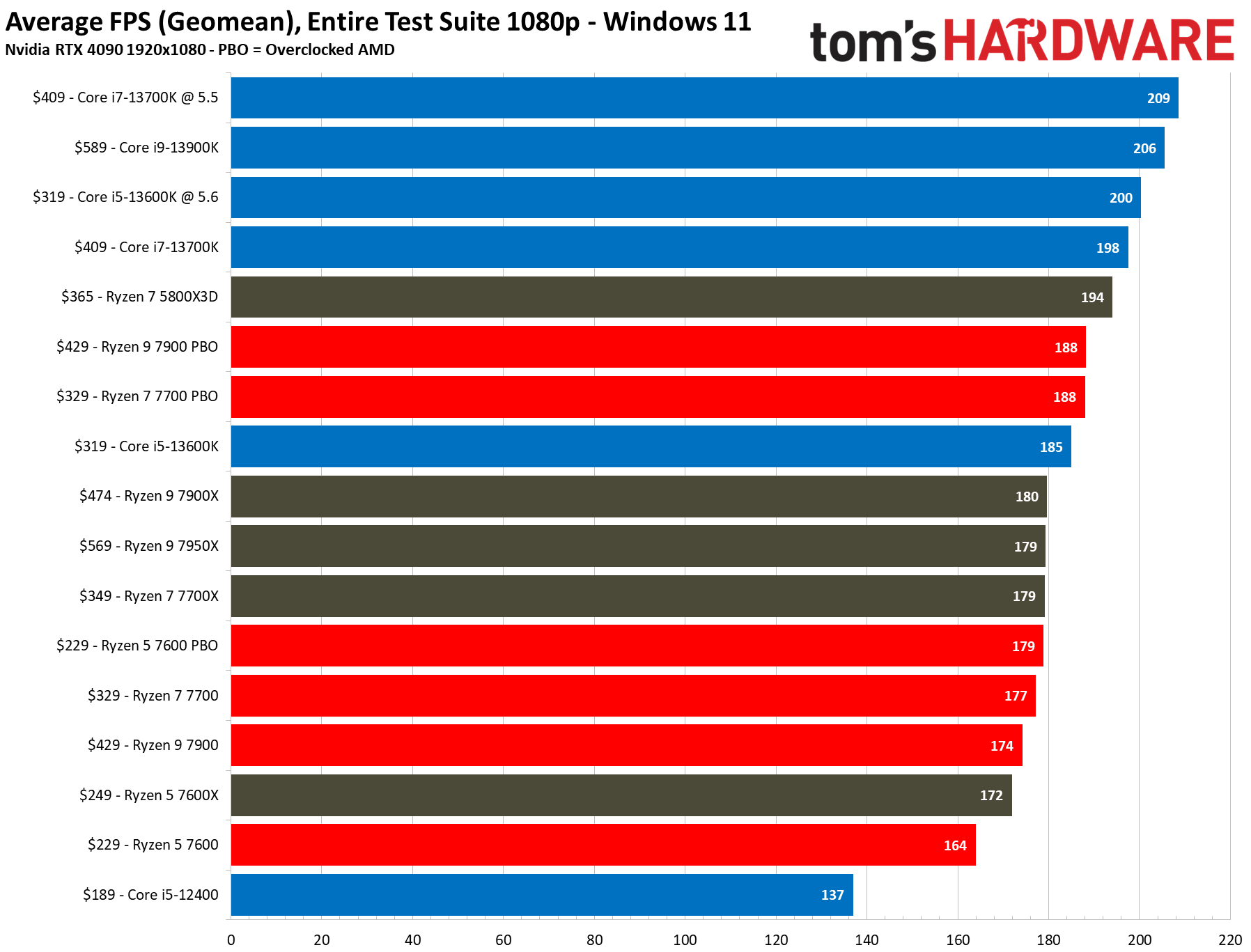
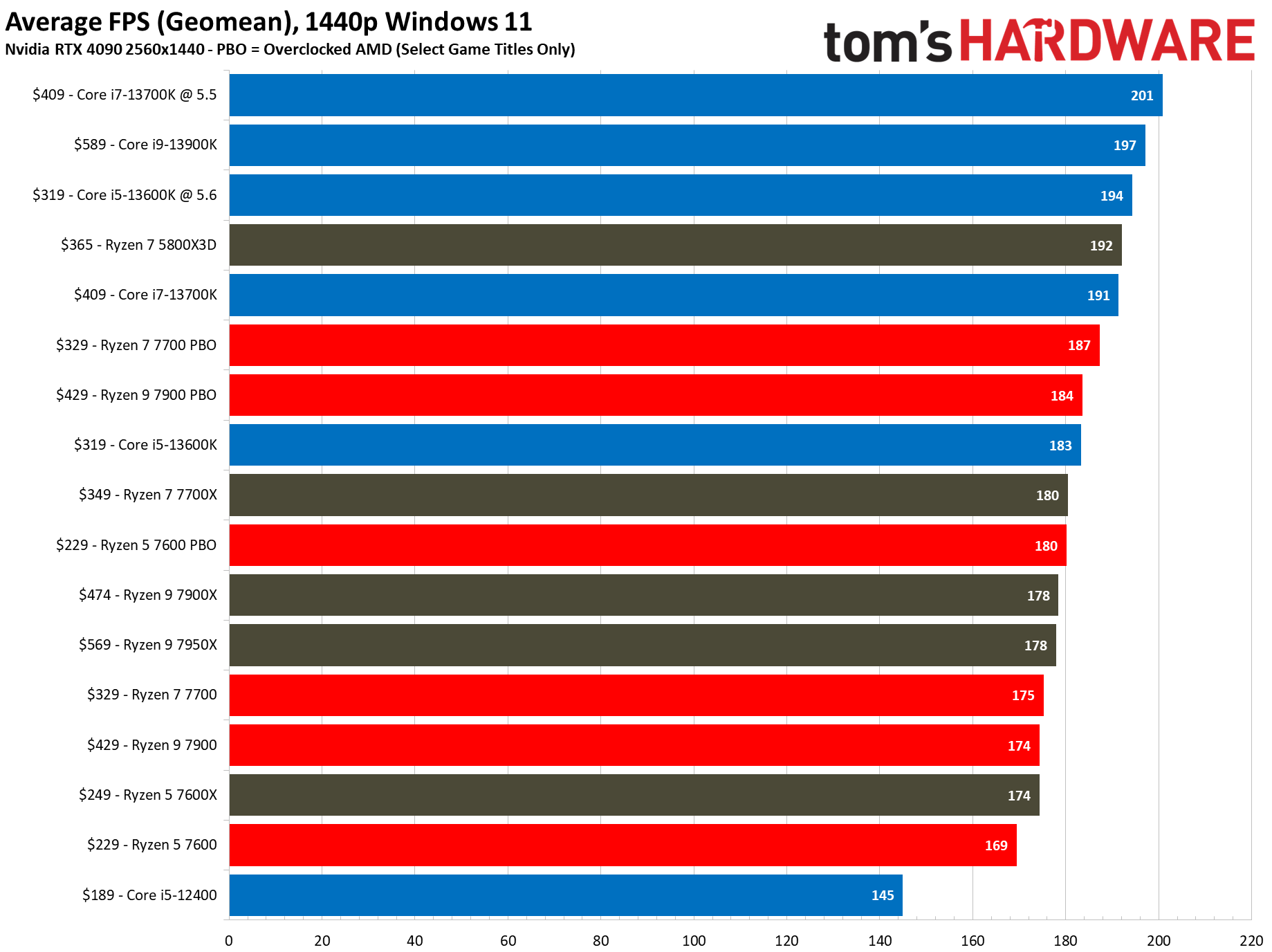
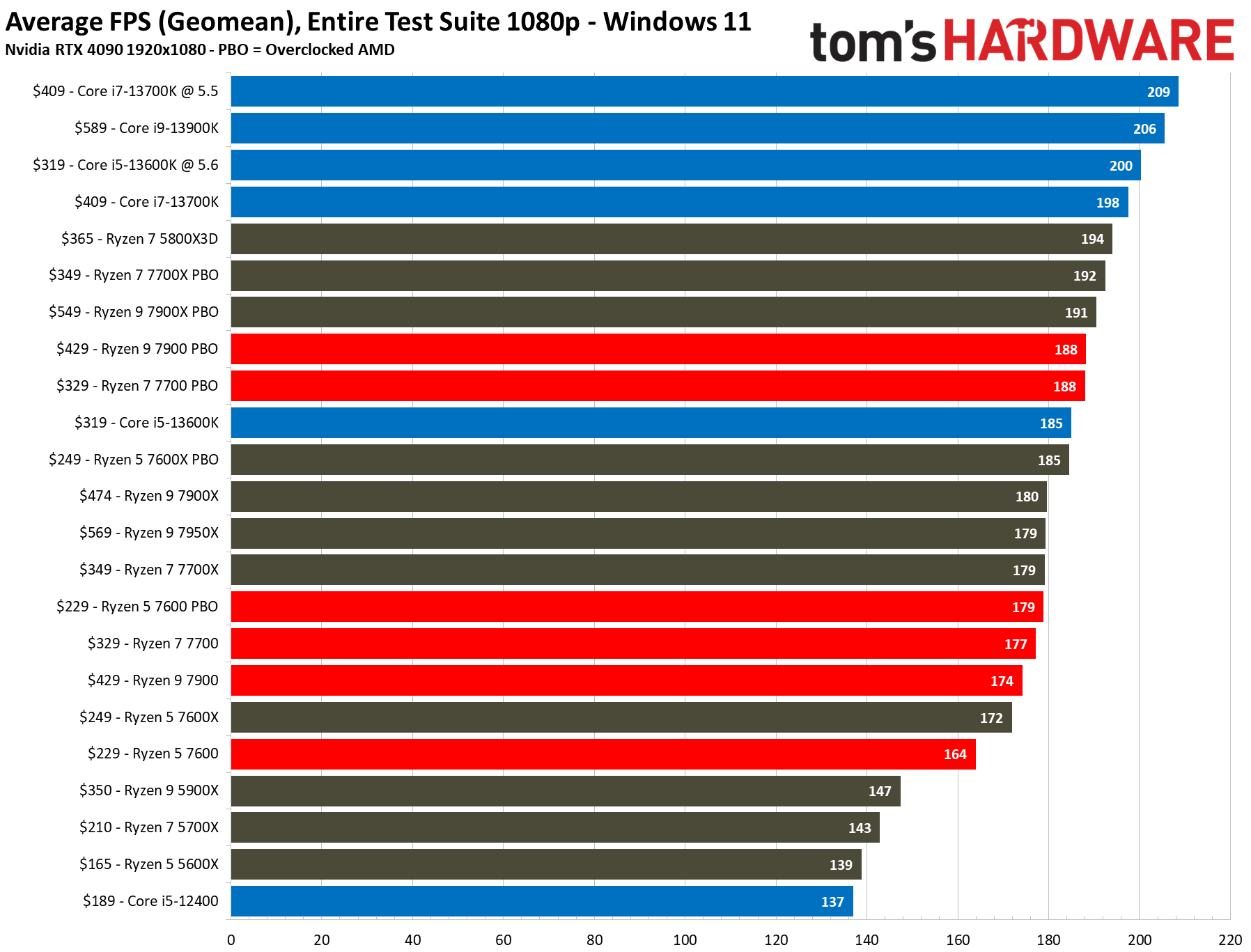
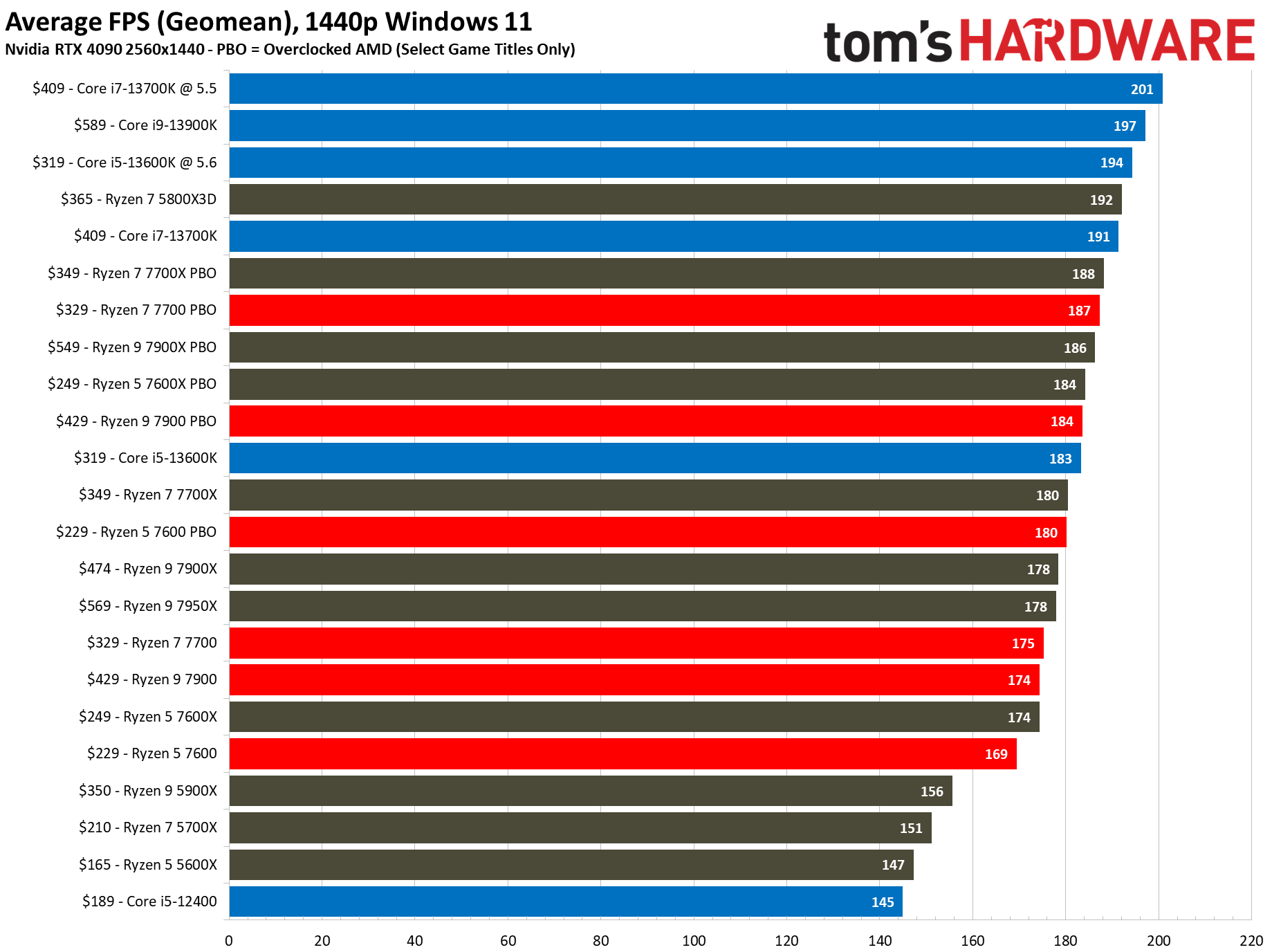
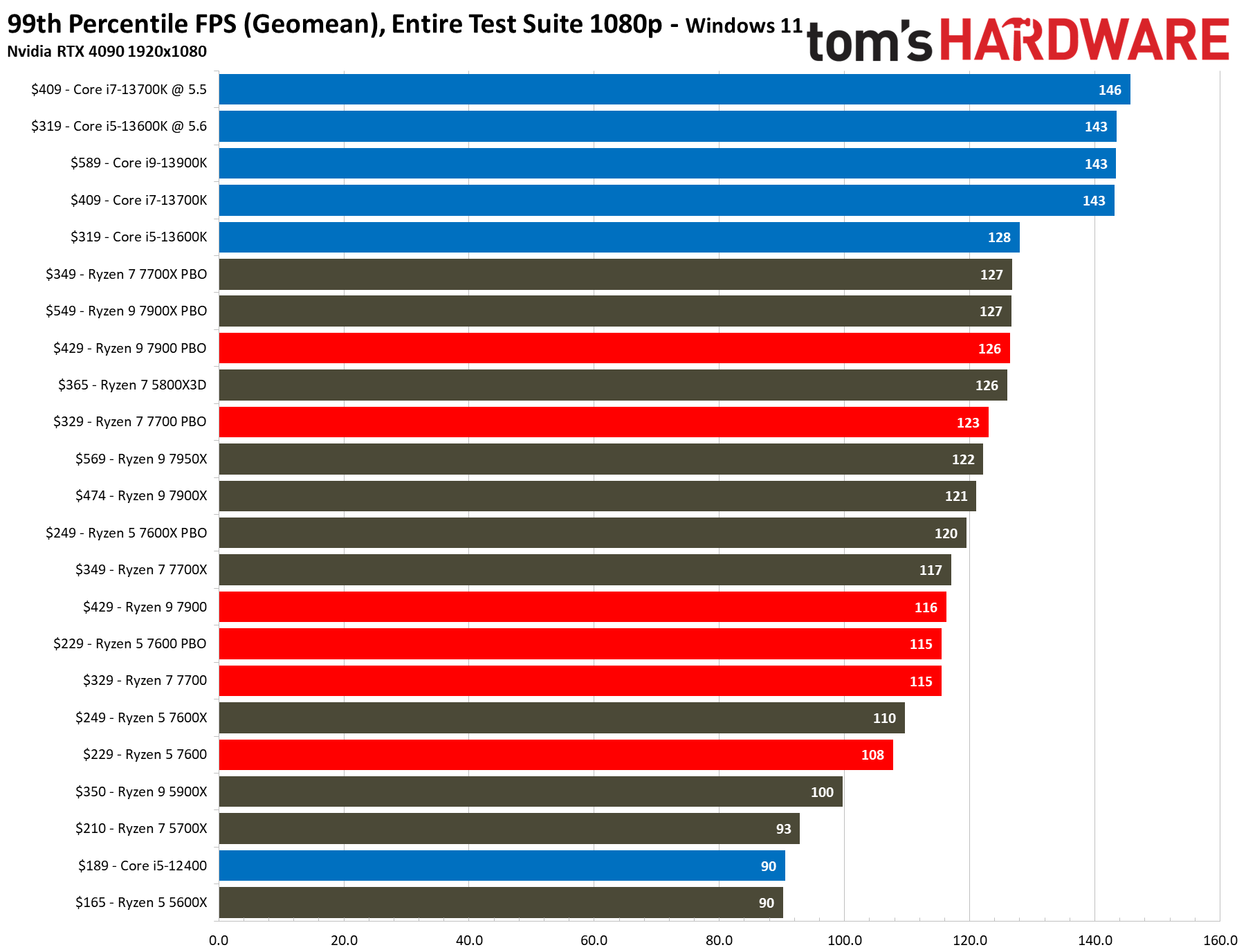
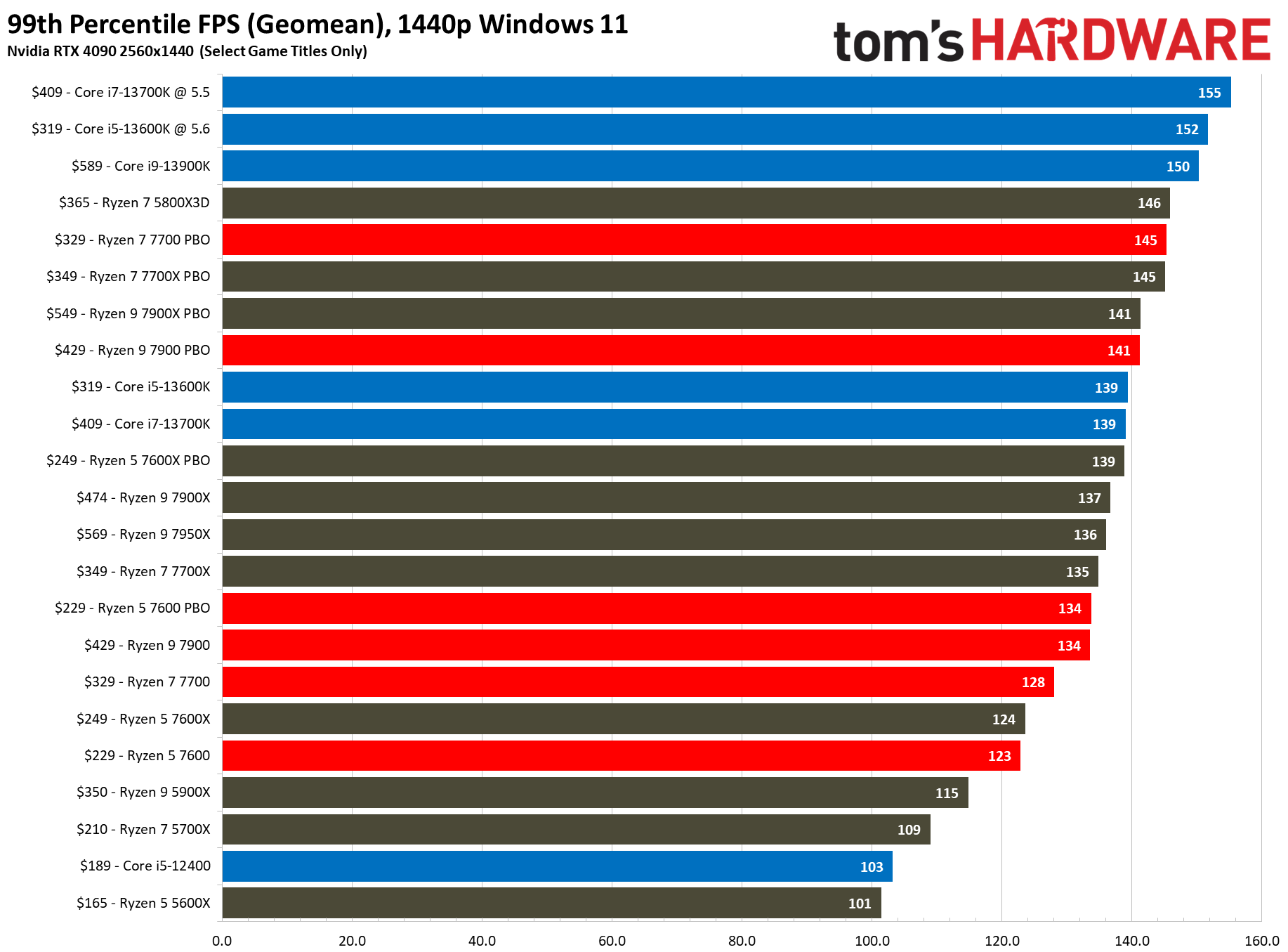
We have two series of charts above, with the first having a reduced number of models and overclocked configurations for ease of reading. We also include the full eye charts with all the tested configurations.
As expected, the new Ryzen 7000 processors easily outperform their most directly-comparable predecessors — even the lowest-end Ryzen 5 7600 beats the fastest previous-gen Ryzen, the 5900X, by 11%.
The 65W Ryzen 9 7900 and Ryzen 7 7700X don't overtake any of the price-comparable Intel processors (the Ryzen 5 7600X won't have a modern Intel price-equivalent until the Core i5-13400 arrives on our test bench). However, even though the Ryzen chips don't break any new performance ground, they help improve Ryzen 7000's price-to-performance positioning — particularly after overclocking.
For instance, the $474 Ryzen 9 7900X is 3% faster than the $429 Ryzen 9 7900, a slight difference given the $50 price delta and the fact that the 7900 has a 'free' bundled cooler. The 7900 is 5% faster than the more expensive 'X' model after overclocking — and that's a simple task, as engaging the EXPO memory profile and enabling Precision Boost Overdrive (PBO) are both one-click operations. Naturally, the 7900X maintains a small lead in its tuned configuration, but the ~1.5% difference is in the noise of the benchmarks.
Likewise, the $349 Ryzen 7 7700X is an imperceptible 1% faster than the $329 Ryzen 7 7700 at stock settings and 2% faster after we overclock both chips — it's easy to see why AMD was reluctant to lower the 7700's MSRP much. Conversely, you could argue the 7700X is still overpriced even though it retails for $70 less than the launch pricing. In either case, the market will dictate the pricing for the 7700, and we suspect it will drop rapidly.
We've become accustomed to the repeating theme of the 65W Ryzen 5 chip being the value chip for gamers in nearly every generation of Ryzen processors. The $229 Ryzen 5 7600 keeps that tradition intact as it trails the $249 Ryzen 5 7600X by 5% at stock settings and 3% after we overclock both chips. But, again, the $20 price difference between these two chips is slight, even after factoring in the 7600's bundled cooler.
The Ryzen 7 5800X3D is the fastest AMD gaming chip by far due to its 3D V-Cache, but its extra 96MB of L3 cache doesn't accelerate all games, so performance can be spotty. The Ryzen 7 5800X3D comes with other caveats, too. For instance, the standard chips offer a balanced performance profile throughout the full game suite. In contrast, the 5800X3D profits heavily from a few massive leads that amount to outliers (like Microsoft Flight Simulator 2021 and Red Dead Redemption 2).
You'll also have to accept much lower performance in just about every other type of productivity application if you opt for the Zen 3-powered Ryzen 7 5800X3D. If you're looking for an exotic 3D V-Cache gaming chip, your best option is to wait until next month when AMD launches the new Zen 4-powered Ryzen 7000X3D models. These chips look like they'll have a much more balanced performance profile.
The deltas in these charts can be slim, though, and large deltas in individual game titles, like with the 5800X3D, impact cumulative measurements. The competition between AMD and Intel chips can vary based on the title and the GPU you use. It's best to make an informed decision based on the types of titles you frequently play, so be sure to check out the individual tests below.
| Tom's Hardware | 1080p Game Benchmarks |
| $589 — Core i9-13900K | 100% |
| $409 — Core i7-13700K / OC | 96% / 101.5% |
| $365 — Ryzen 7 5800X3D | 94% |
| $319 — Core i5-13600K / OC | 90% / 97% |
| $474 — Ryzen 9 7900X | 87% |
| $429 — Ryzen 9 7900 / OC | 85% / 91% |
| $349 — Ryzen 7 7700X | 87% |
| $329 — Ryzen 7 7700 / OC | 86% / 92% |
| $249 — Ryzen 5 7600X | 83.50% |
| $229 — Ryzen 5 7600 / OC | 80% / 87% |
Cyberpunk 2077 on Ryzen 5 7600, Ryzen 7 7700, Ryzen 9 7900
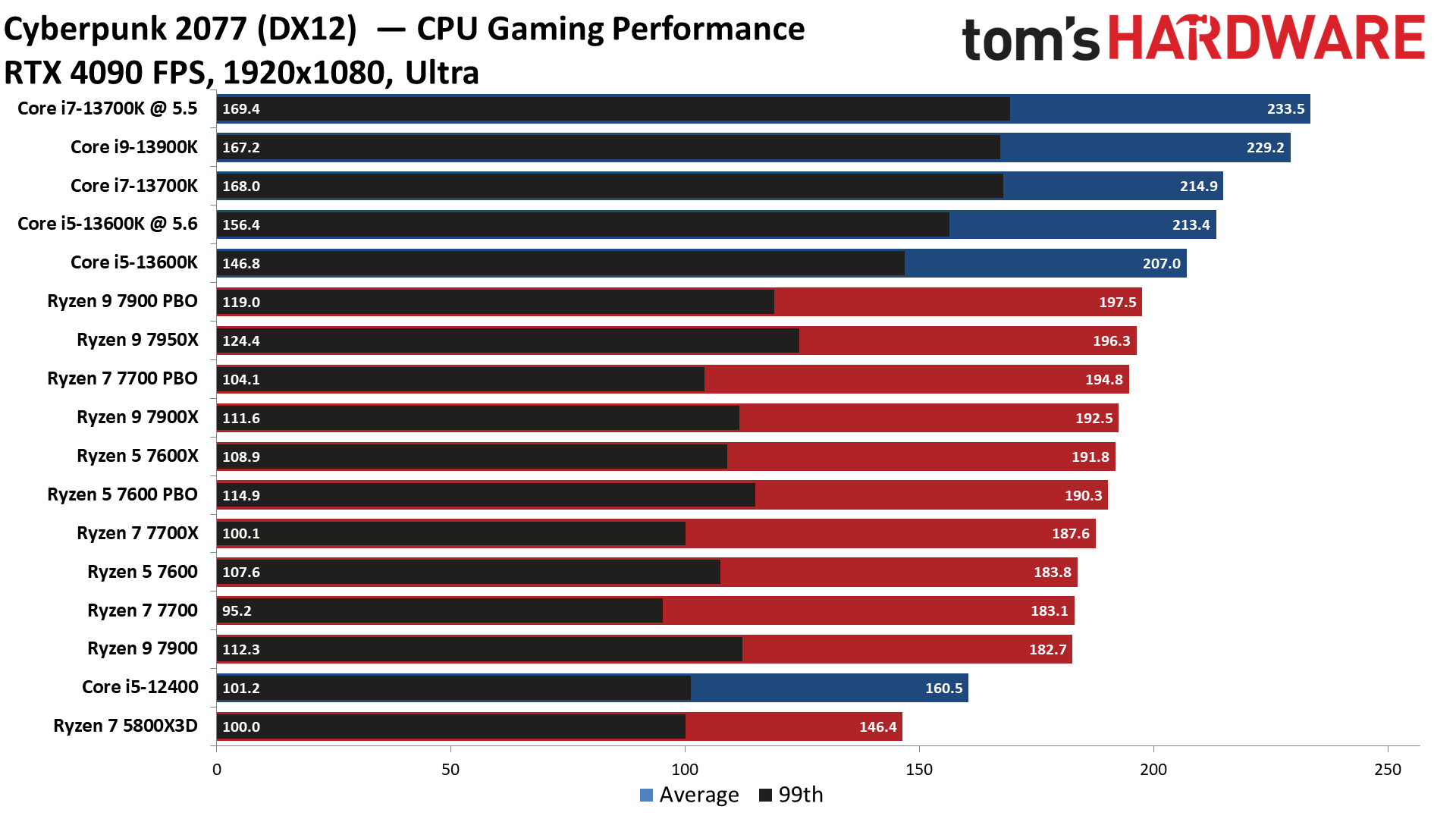
We only include the overclocked Intel and non-X Ryzen processors in these slides, as adding the full roster of chips makes for a hard-to-read chart. Be sure to check our CPU Benchmark hierarchy for more detailed statistics.
Cyberpunk 2077 finds the Intel processors taking the lead over the Ryzen 7000 models by substantial margins. The 7900, 7700 and 7600 all offer similar performance at stock settings, trailing the 13600K by ~13%, but overclocking (PBO) exposes a bit more differentiation between the processors. For example, the Ryzen 9 7900's PBO configuration shrinks the gap to 5% with the 13600K. However, the Raptor Lake chips still maintain a healthy lead.
Far Cry 6 on Ryzen 5 7600, Ryzen 7 7700, Ryzen 9 7900
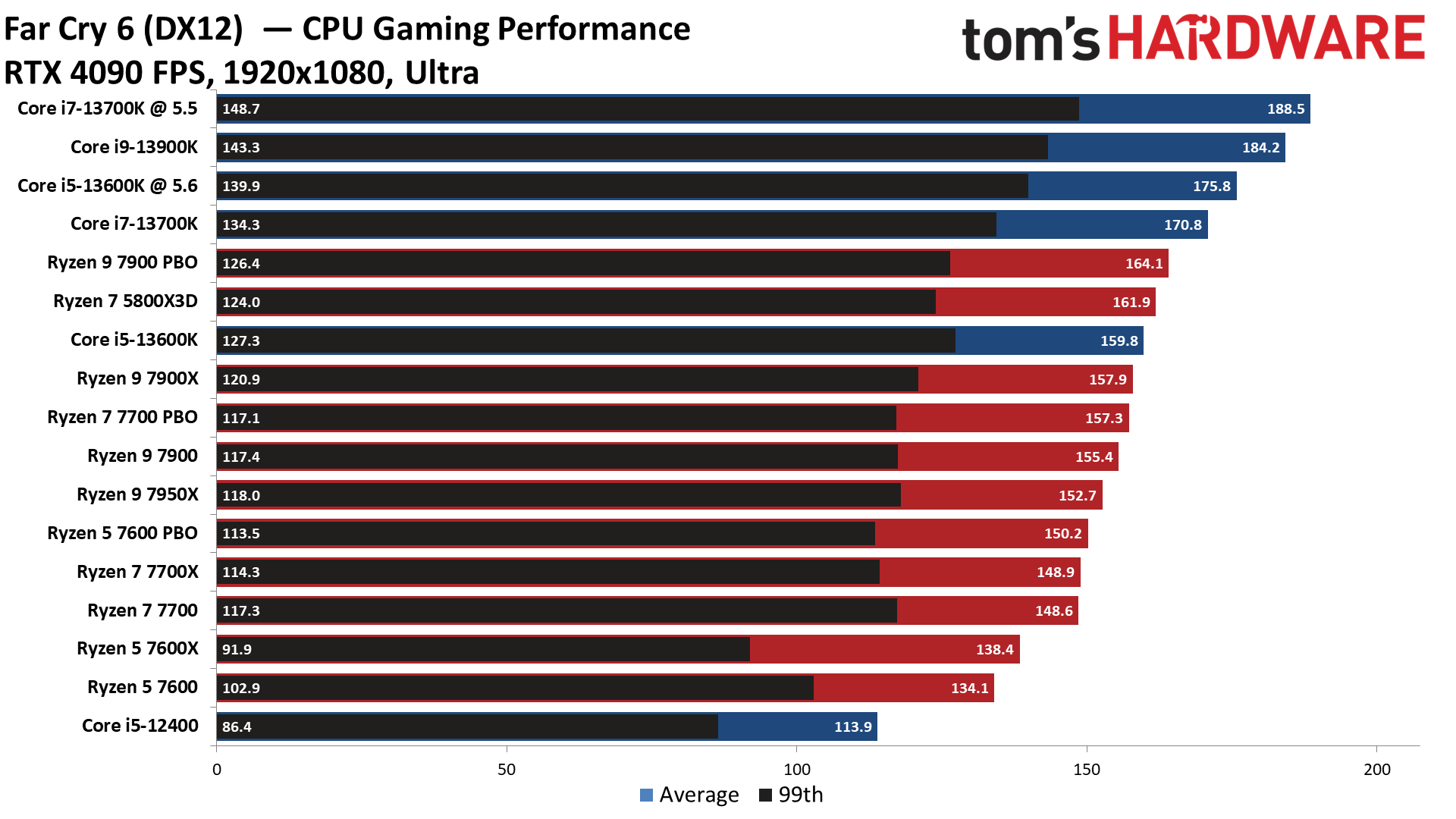
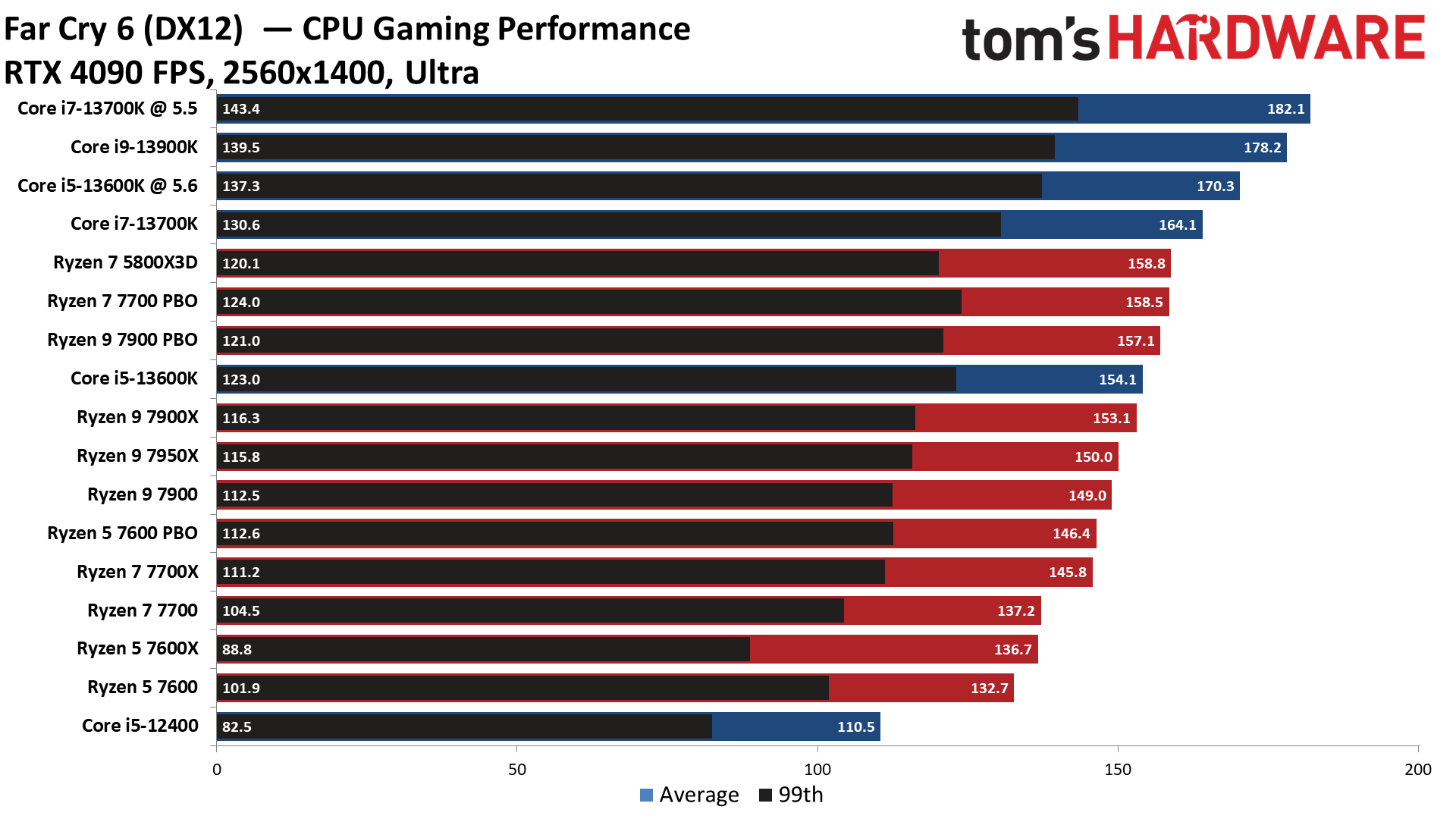
Overclocking the 7900, 7700, and 7600 gives them the lead over their X-series counterparts in Far Cry 6, but bear in mind that we didn't include the PBO configuration for the X-series models due to the sheer number of entries in the charts. Generally, you can expect the overclocked Non-X chips to slightly trail their X-series equivalents, but the difference between the chips is slight.
Get Tom's Hardware's best news and in-depth reviews, straight to your inbox.
F1 2021 on Ryzen 5 7600, Ryzen 7 7700, Ryzen 9 7900
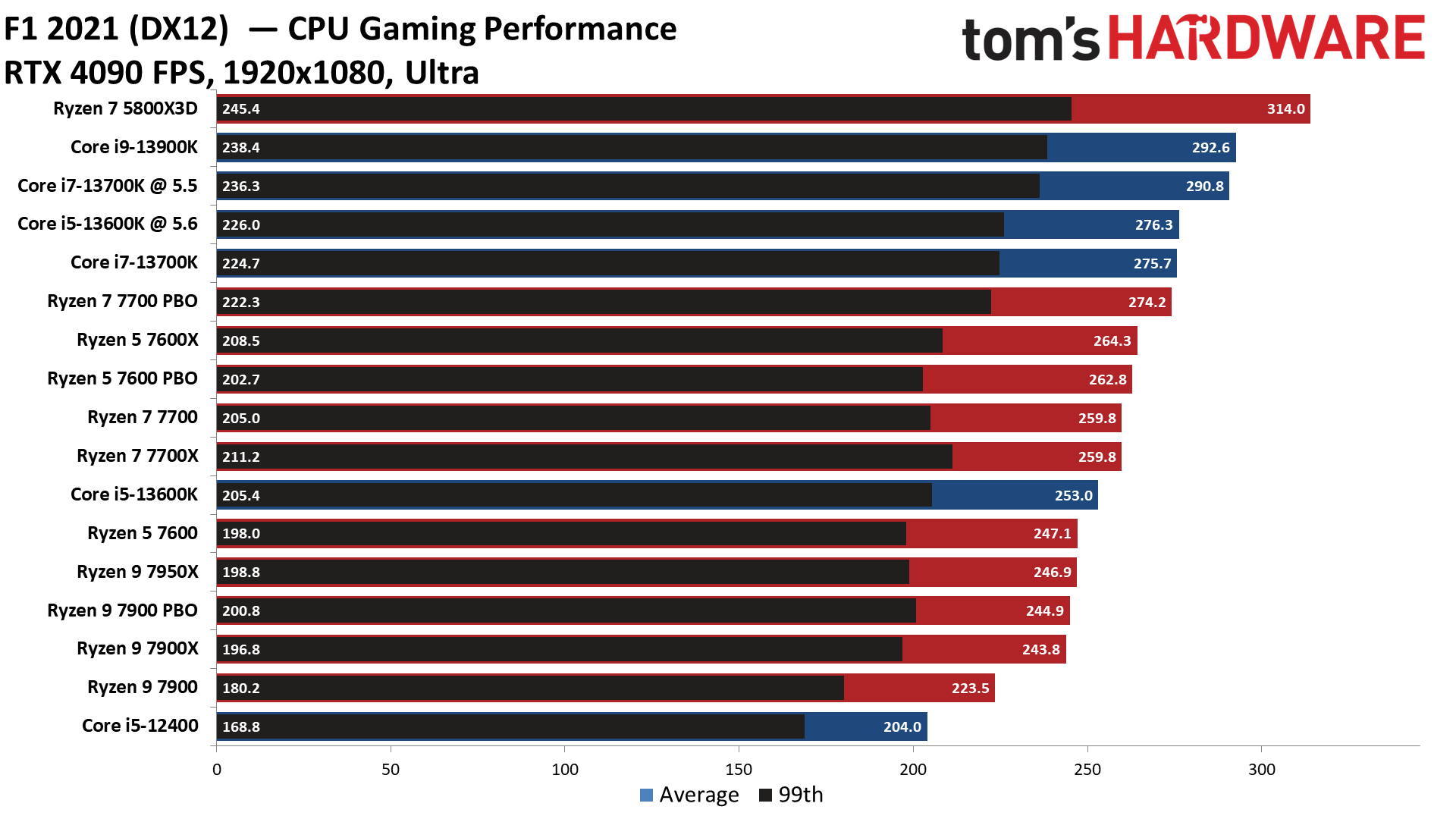

F1 2021 tends to scale by core count, but the dual-CCD Ryzen chips don't benefit, so future game optimizations could yield big gains for AMD's core-heavy chips.
Meanwhile, the Ryzen 7 5800X3D reminds us of the power of its incredible 96MB of L3 cache: Despite its much lower 4.5 GHz clock rate, it is still 7% faster than the $589 Core i9-13900K here.
Hitman 3 on Ryzen 5 7600, Ryzen 7 7700, Ryzen 9 7900
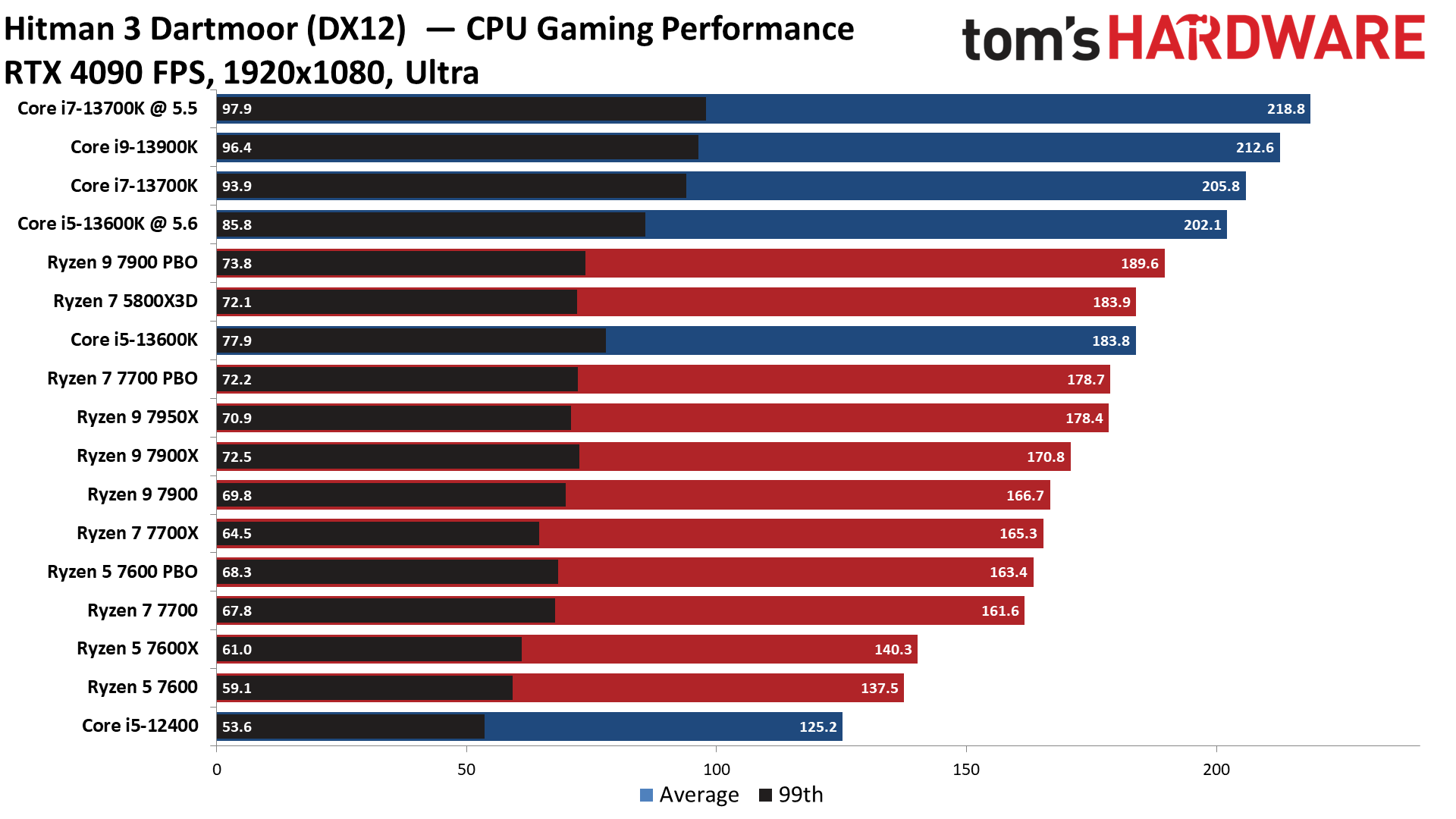
The Ryzen 7000 processors scale predictably based on the core count in Hitman 3, but the Raptor Lake lineup continues to dominate at its respective price points.
Microsoft Flight Simulator 2021 on Ryzen 5 7600, Ryzen 7 7700, Ryzen 9 7900
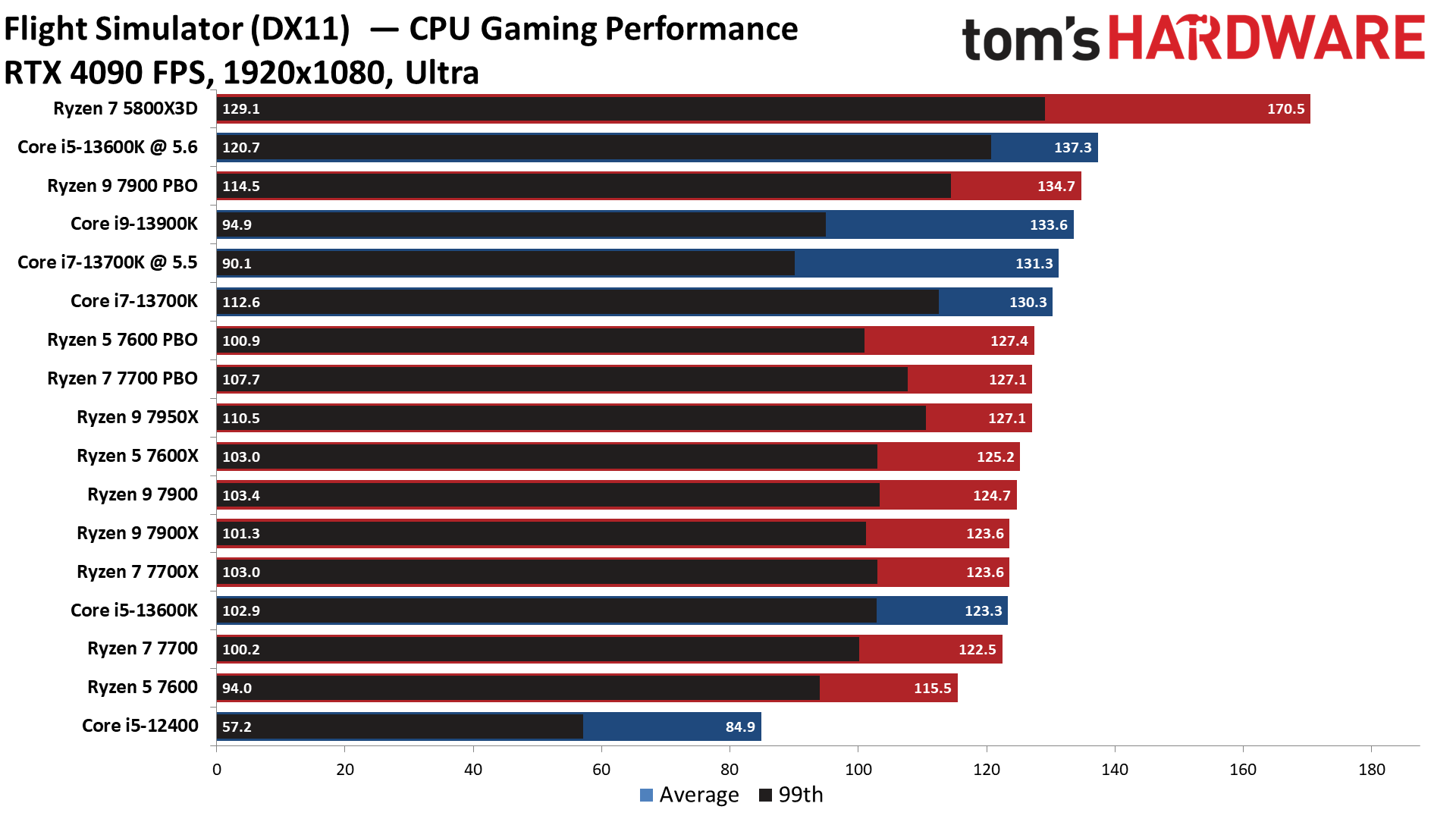
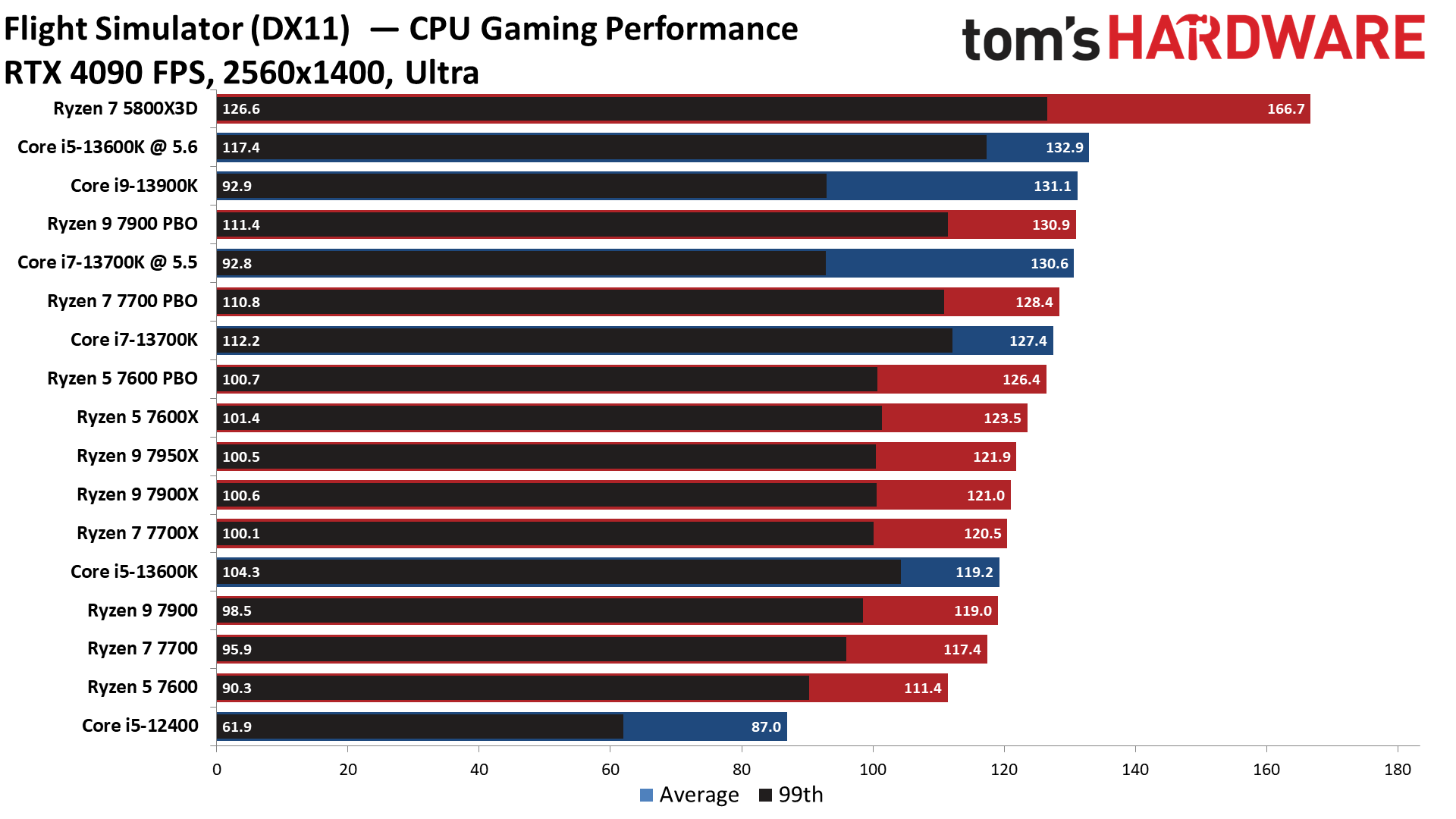
Microsoft Flight Simulator 2021 obviously benefits tremendously from L3 cache — the Ryzen 7 5800X3D is a whopping 28% faster than the Core i9-13900K flagship on this test. This large advantage is amazing but doesn't represent the 5800X3D's performance in most titles. It also illustrates how outliers can make the 5800X3D seem more impressive in cumulative measurements.
In either case, this does bode well for the Zen 4 Ryzen 7000X3D models, which should bring all the goodness of the capacious L3 cache with fewer tradeoffs in standard applications.
Red Dead Redemption 2 on Ryzen 5 7600, Ryzen 7 7700, Ryzen 9 7900
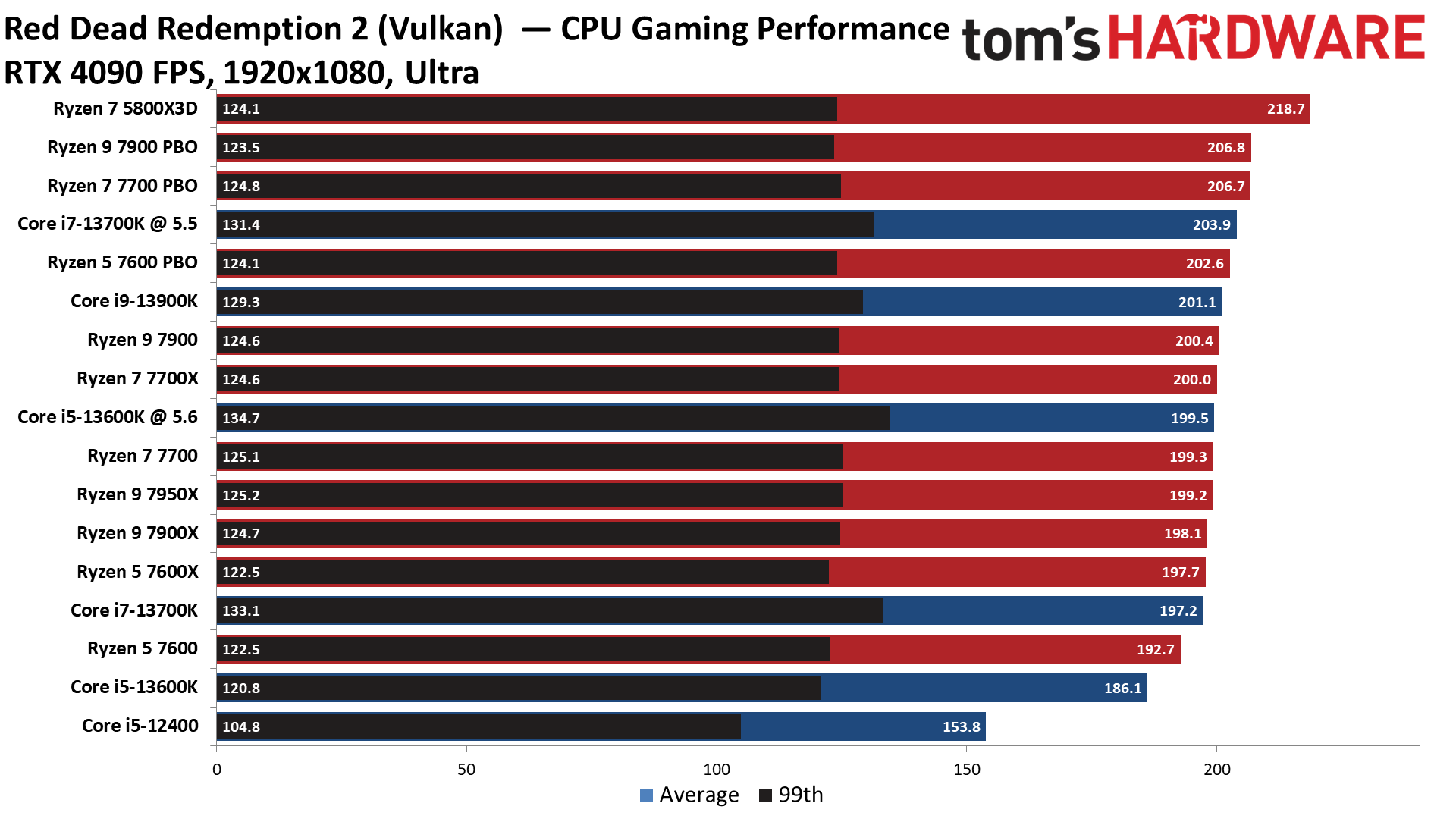
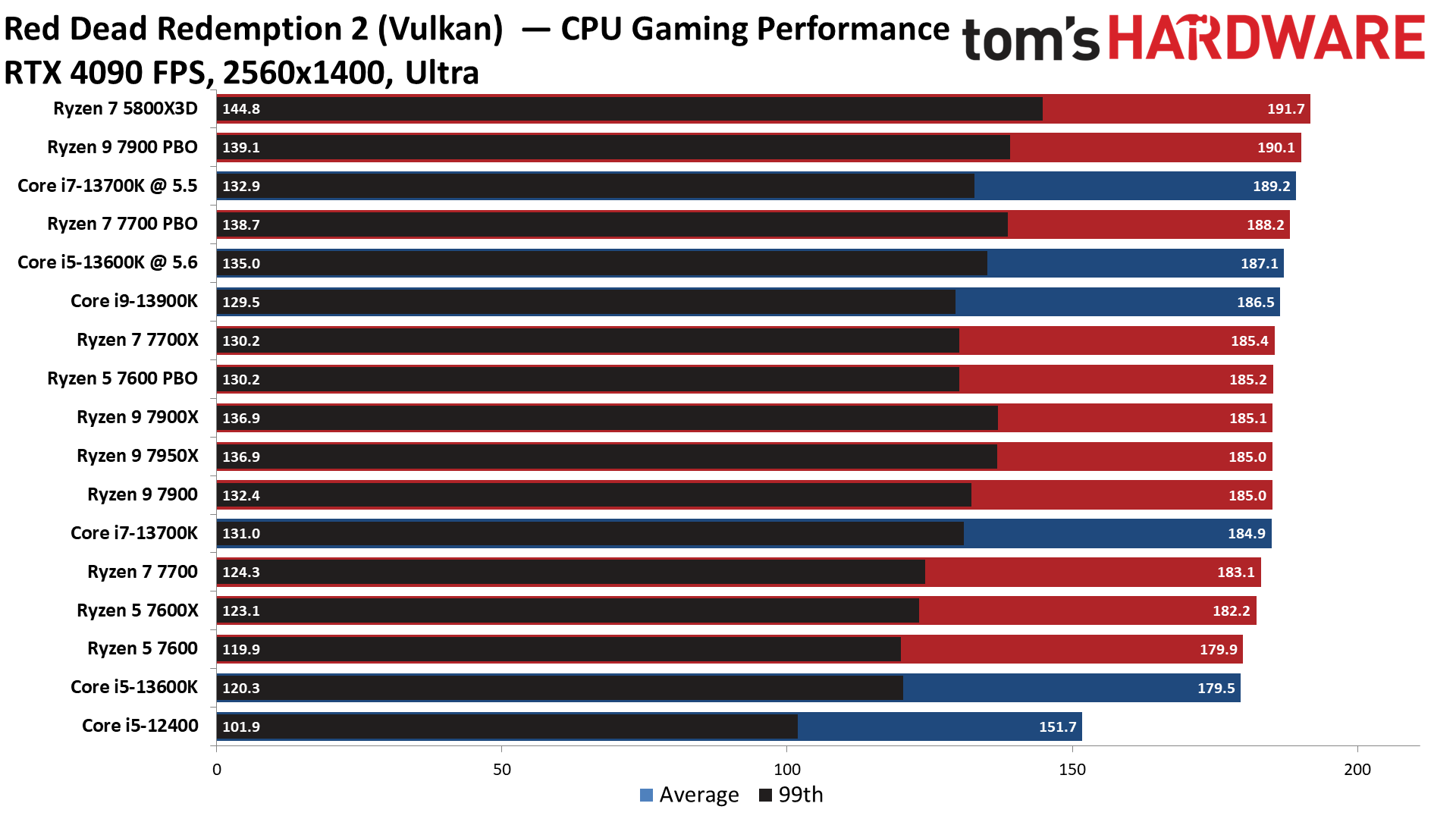
Unlike our first outing, the Zen 4 chips gain a meaningful amount of performance in this title from overclocking. We retested with the latest BIOS and chipset drivers, so it's clear that the new AM5 platform is progressing rapidly, much as we saw with AM4.
Warhammer 3 on Ryzen 5 7600, Ryzen 7 7700, Ryzen 9 7900
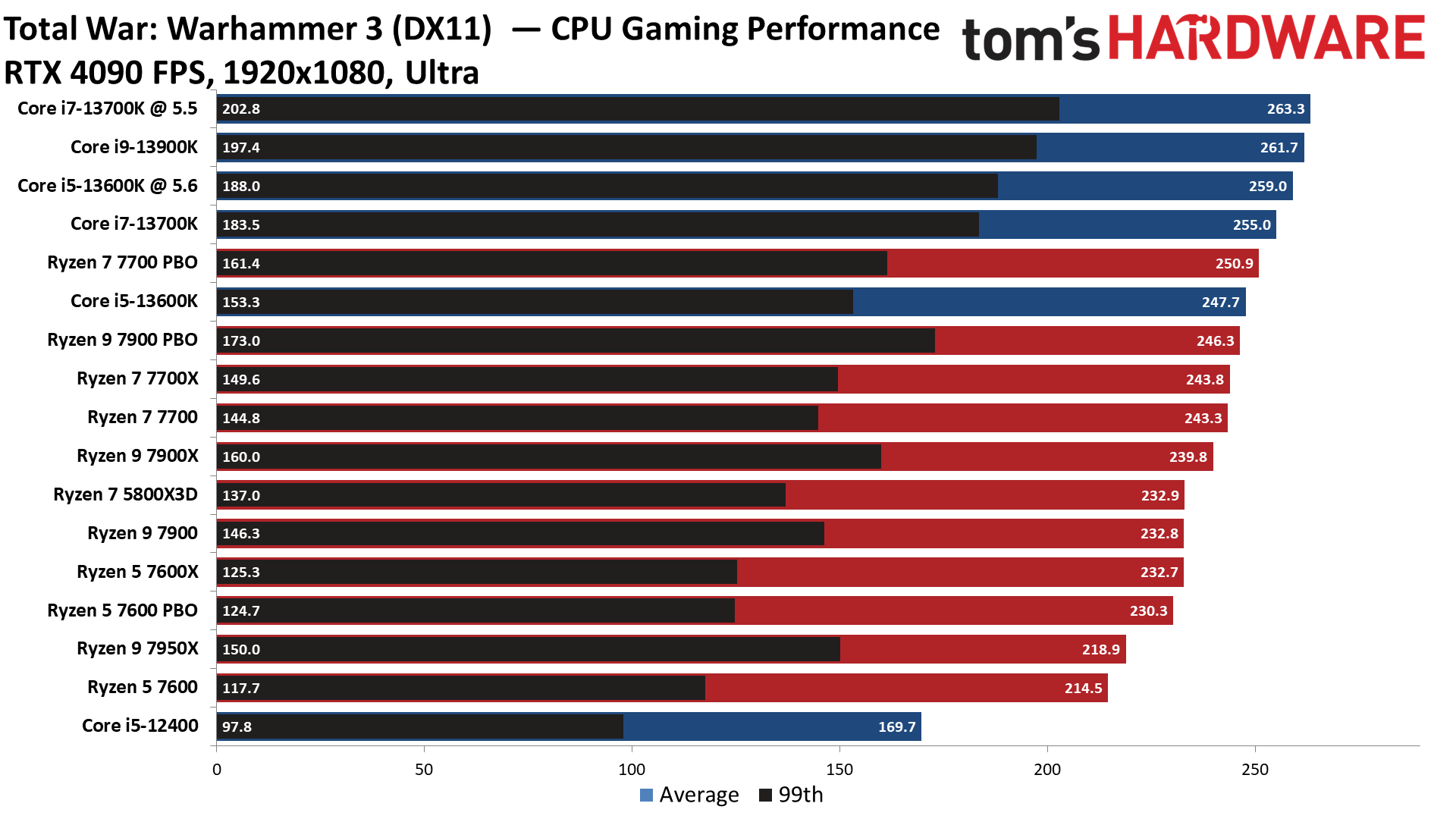
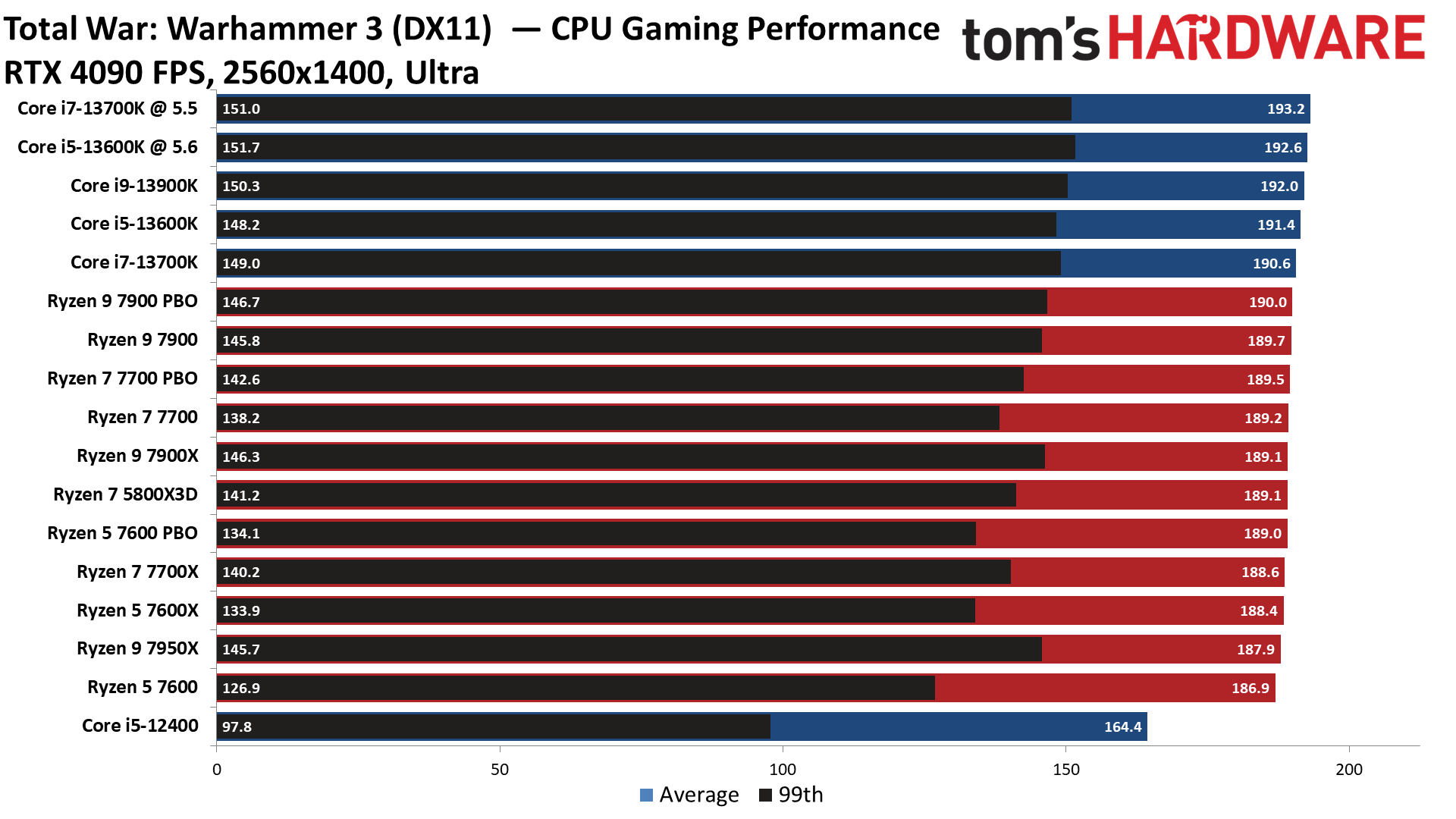
Flipping over to the 1440p charts shows us that higher resolutions are often the great equalizer that levels the playing field for chips with similar accommodations.
Watch Dogs Legion on Ryzen 5 7600, Ryzen 7 7700, Ryzen 9 7900
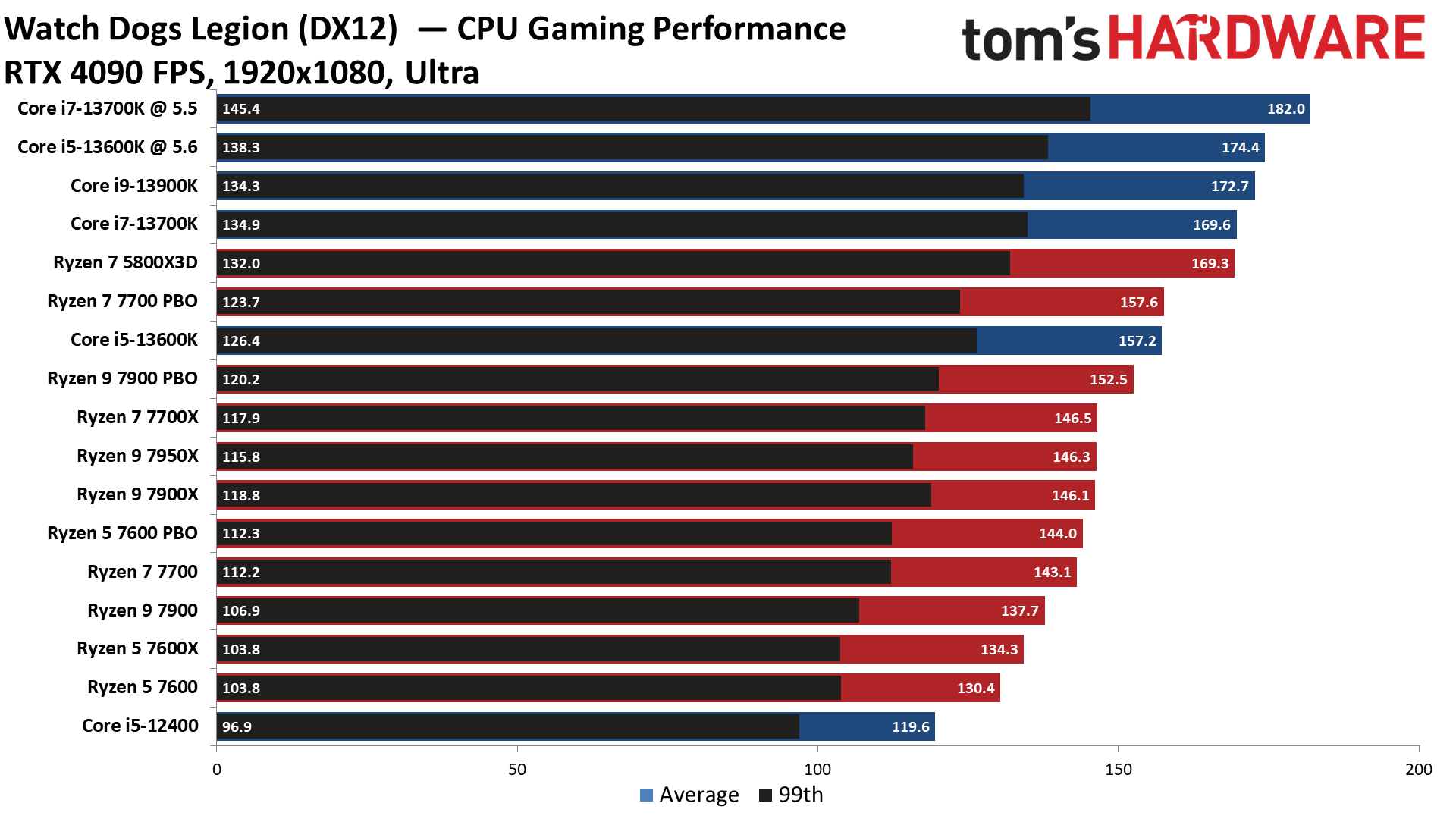
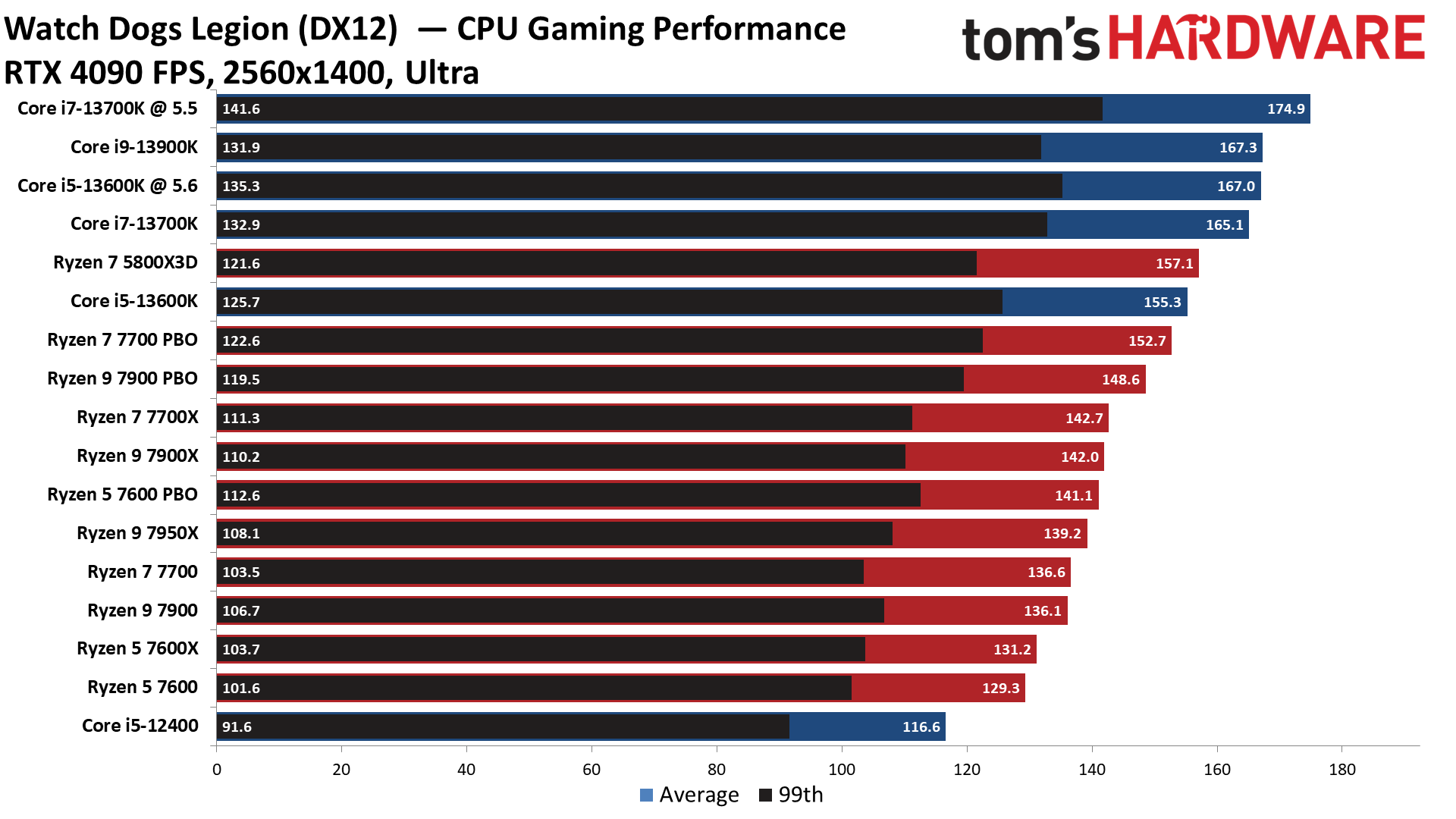
The Non-X Ryzen 7000 chips end this round of game testing with yet another solid showing of generally matching the performance of their more expensive equivalents after overclocking.
Desktop PC Application Benchmarks on Ryzen 5 7600, Ryzen 7 7700, Ryzen 9 7900 — The TLDR:
We generate these cumulative measurements from the geometric mean of the most important application benchmarks in our selection of tests below. These results give a good indication of performance and the trends you can expect overall. We include both a focused test pool and an expanded chart for this section, but to simplify our charts, we use the narrower selection in the individual tests further below.
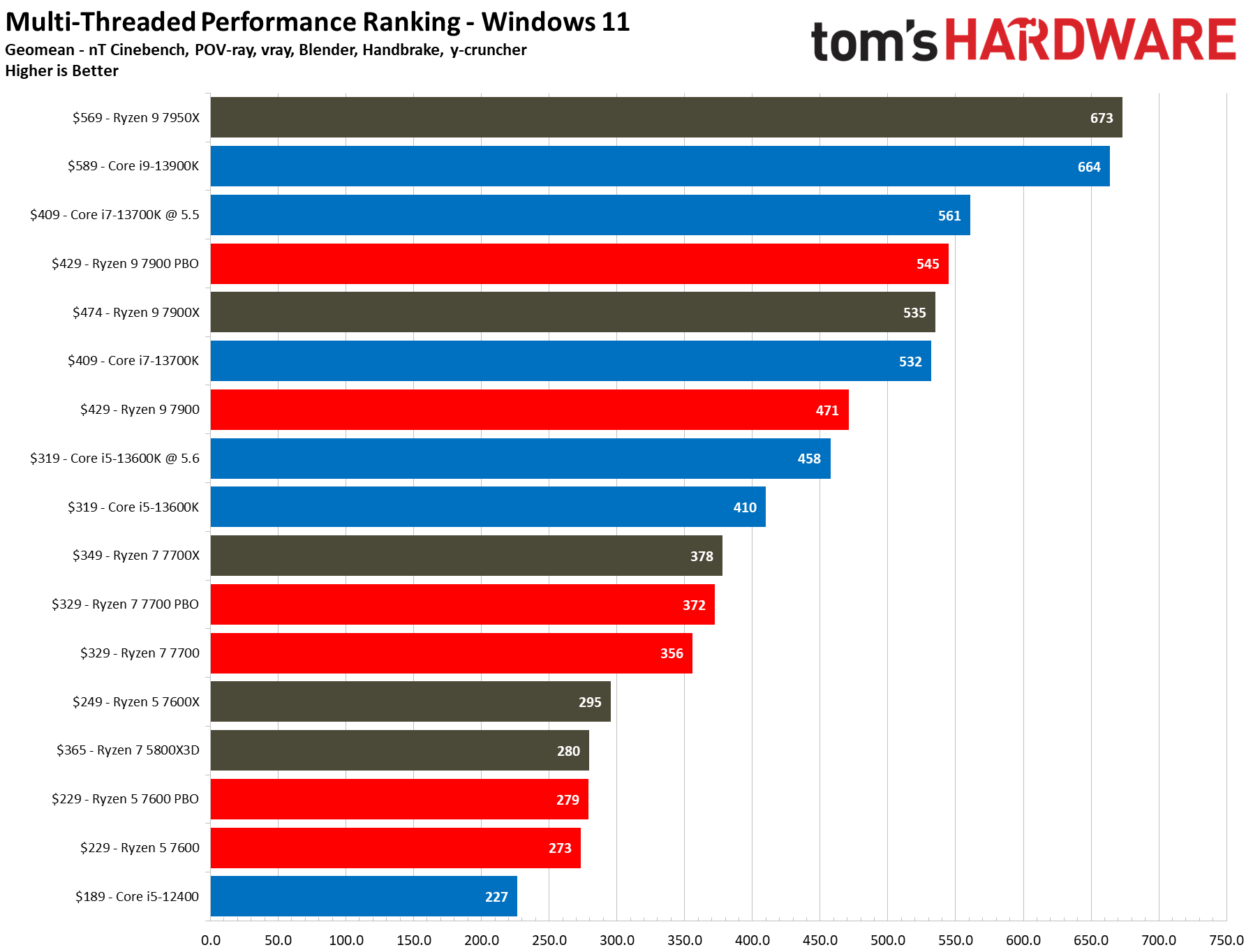
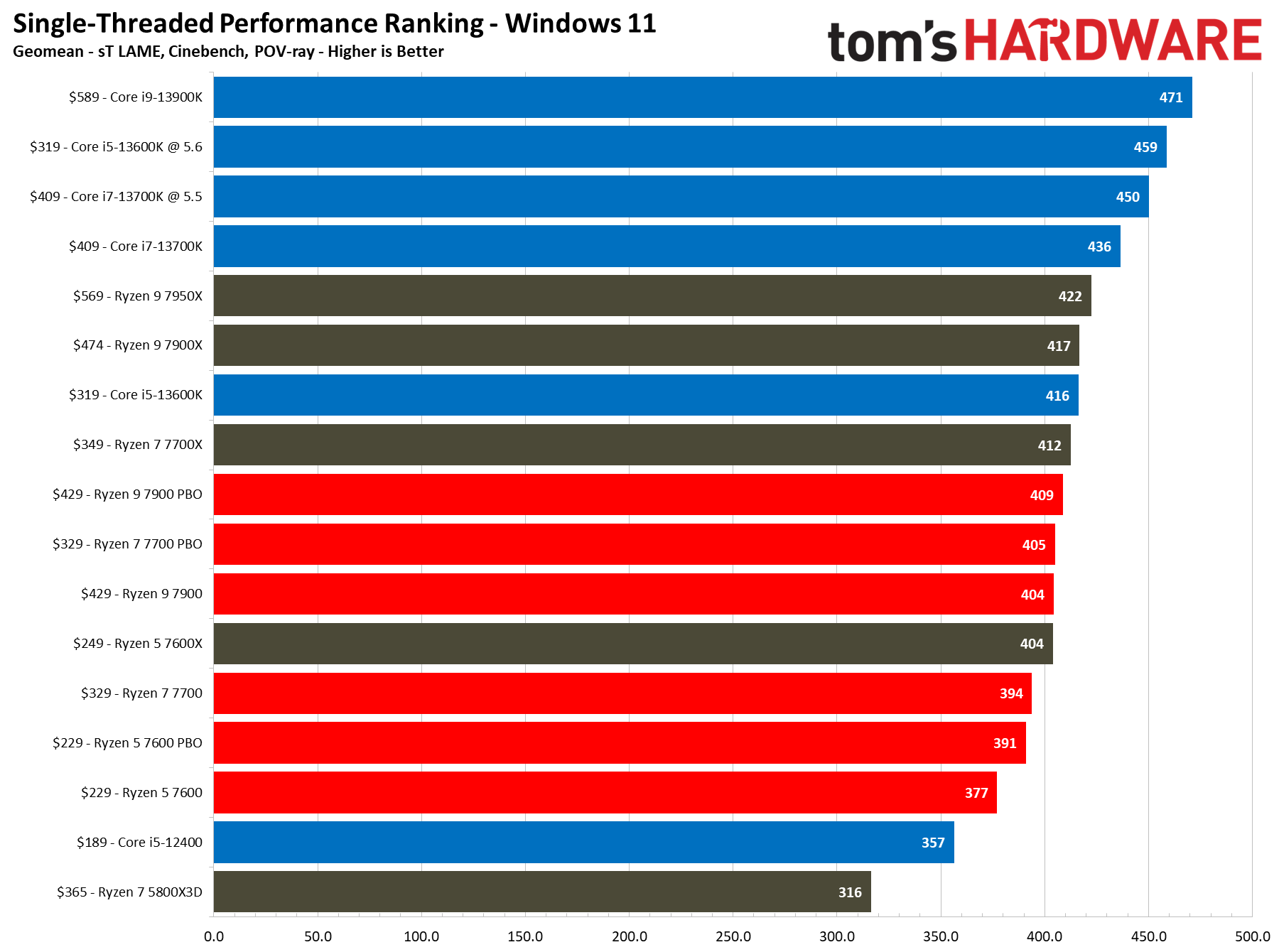
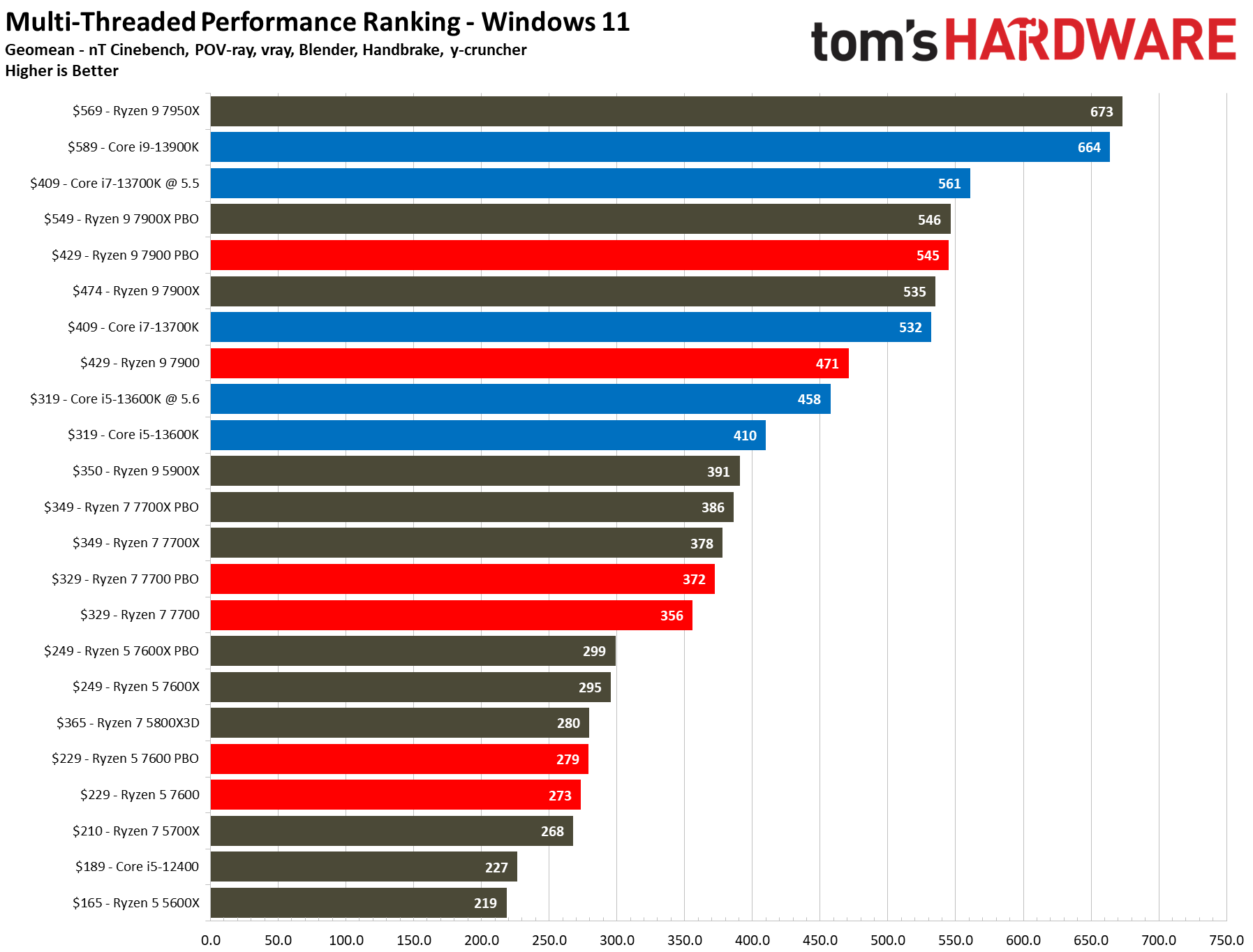
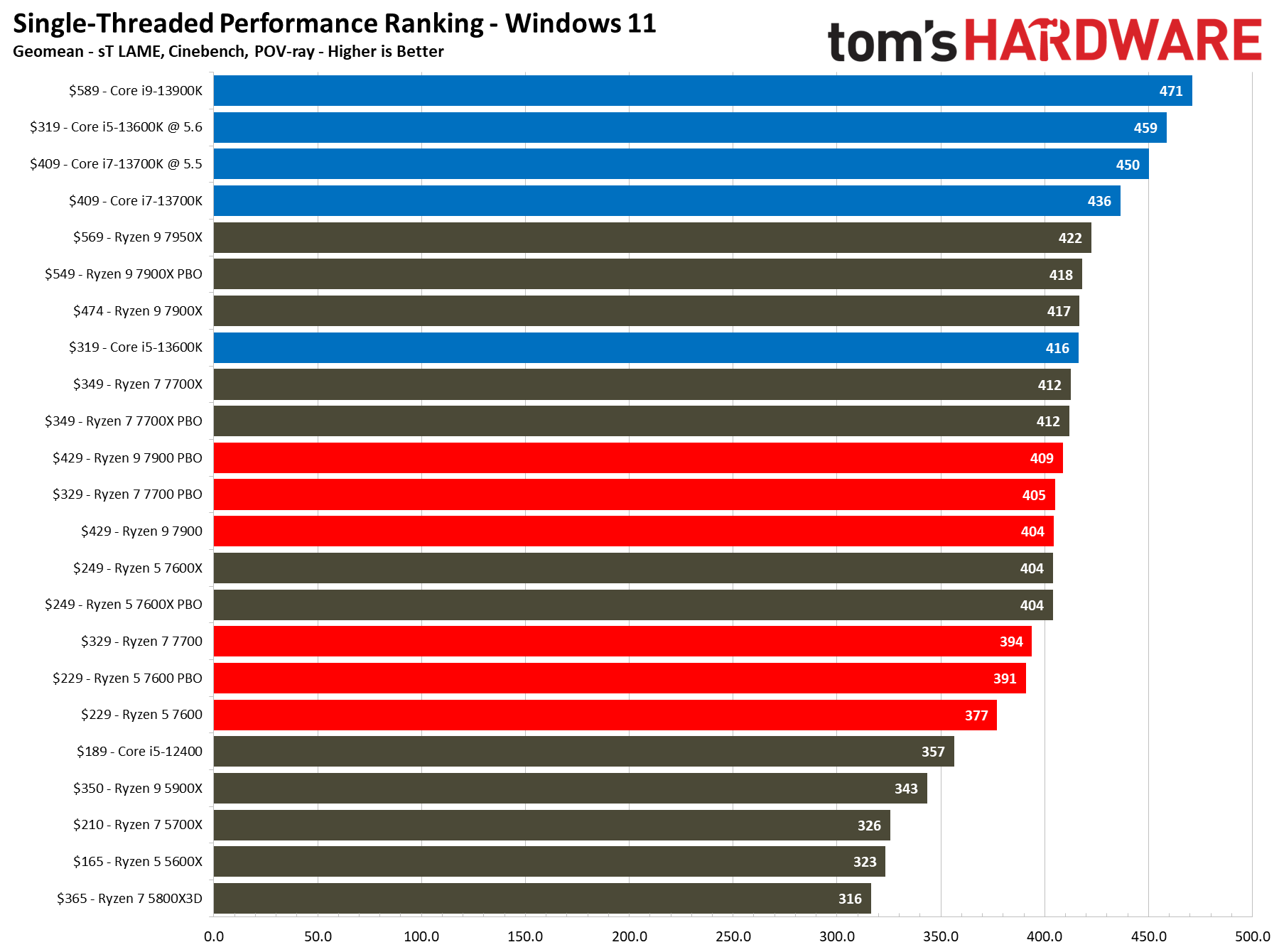
Overall the same general trends that we saw in our gaming benchmarks appear in our application testing — the Non-X Ryzen 7000 processors outperform the previous-gen Ryzen equivalents, nearly match the more expensive X-series models after overclocking, and don't change the overall performance rankings relative to Intel's Raptor Lake.
The $229 Ryzen 5 7600 doesn't deliver quite as much uplift in threaded work as the other Ryzen models. The 7600 is quite a bit slower than the $295 Ryzen 5 7600X in our multi-threaded tests, and as we saw with the 7600X, it doesn't benefit much from overclocking — it notched just a 2% improvement from overclocking.
The $329 Ryzen 7 7700 provides more uplift in threaded workloads from overclocking, nearly matching the stock $349 Ryzen 7 7700X in threaded applications after overclocking granted an additional 5% more performance.
The $429 Ryzen 9 7900 benefits the most from overclocking, as flipping the PBO and EXPO toggles yields a 17% speedup that ties the overclocked $474 Ryzen 9 7900X.
We also see a rarity in our single-threaded tests — the Non-X chips experience a few percentage points of uplift from PBO. Typically there are no meaningful gains in single-threaded work from overclocking the X-series models, so the extra 2 to 3% is a nice surprise.
You'll have to accept severe performance tradeoffs if you opt for AMD's fastest gaming chip, the Ryzen 7 5800X3D. The 5800X3D is significantly slower than the newer chips because it comes with the previous-gen Zen 3 architecture, and the extra dollop of L3 cache doesn't impart any meaningful speedups in most standard desktop PC applications. If you're looking for an X3D chip, wait for the 7000X3D chips that launch next month.
| Tom's Hardware | Multi-Thread | Single-Thread |
| $589 — Core i9-13900K | 99% | 100% |
| $569 — Ryzen 9 7950X | 100% | 90% |
| $409 — Core i7-13700K / OC | 79% / 83% | 93% / 96% |
| $319 — Core i5-13600K / OC | 61% / 68% | 88% / 97% |
| $474 — Ryzen 9 7900X | 79% | 89% |
| $429 — Ryzen 9 7900 / OC | 70% / 81% | 86% / 87% |
| $349 — Ryzen 7 7700X | 56% | 87% |
| $329 — Ryzen 7 7700 / OC | 53% / 55% | 84% / 86% |
| $249 — Ryzen 5 7600X | 44% | 86% |
| $229 — Ryzen 5 7600 / OC | 41% / 41% | 80% / 83% |
| $365 — Ryzen 7 5800X3D | 42% | 67% |
Rendering Benchmarks on Ryzen 5 7600, Ryzen 7 7700, Ryzen 9 7900

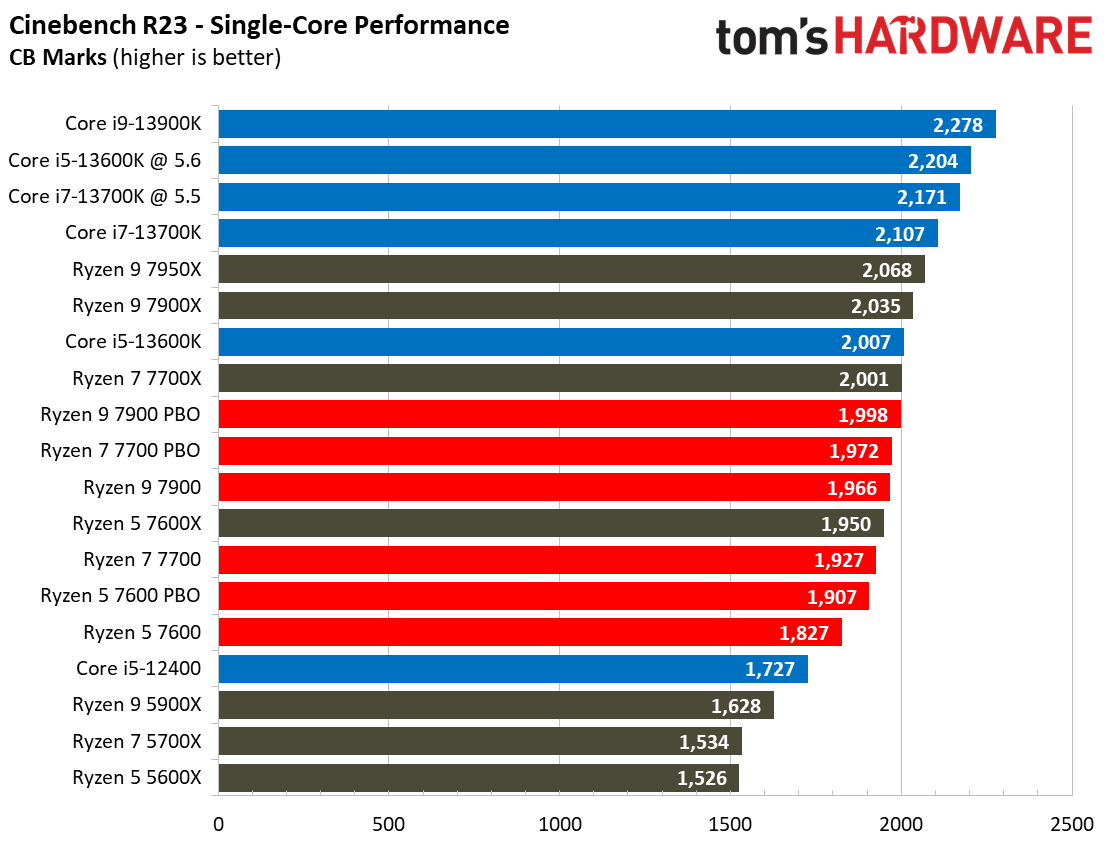
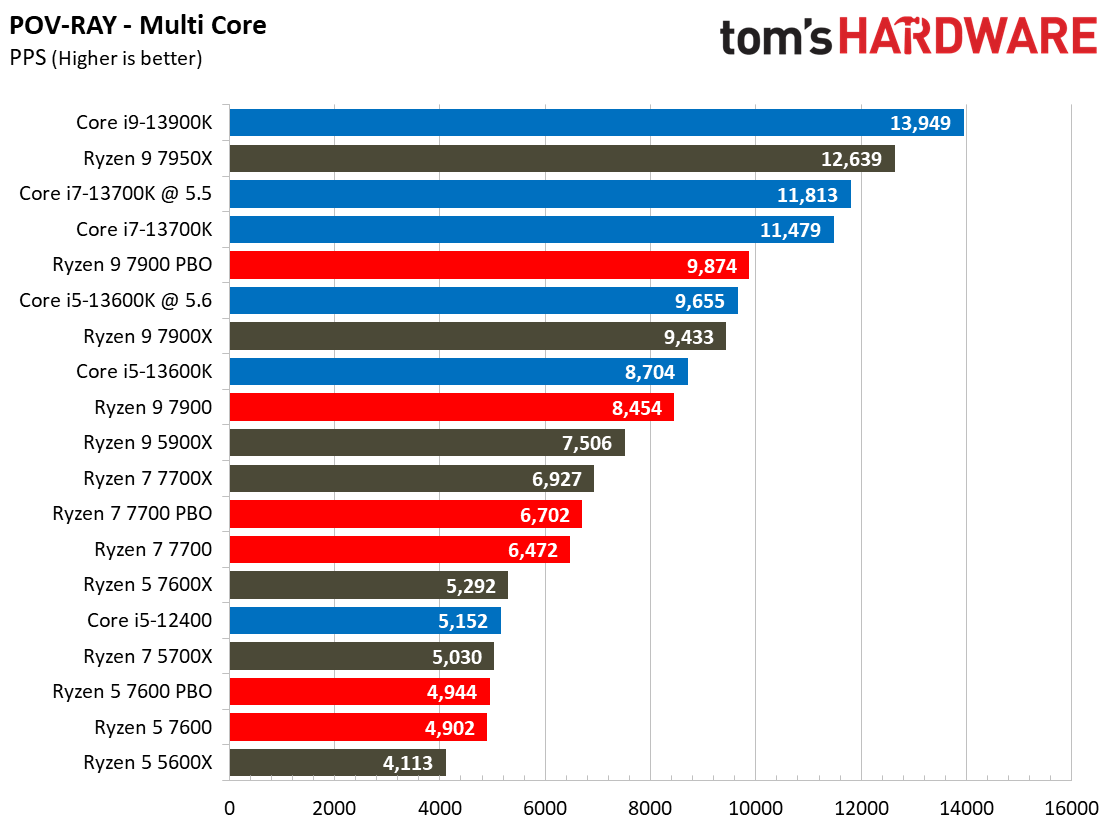
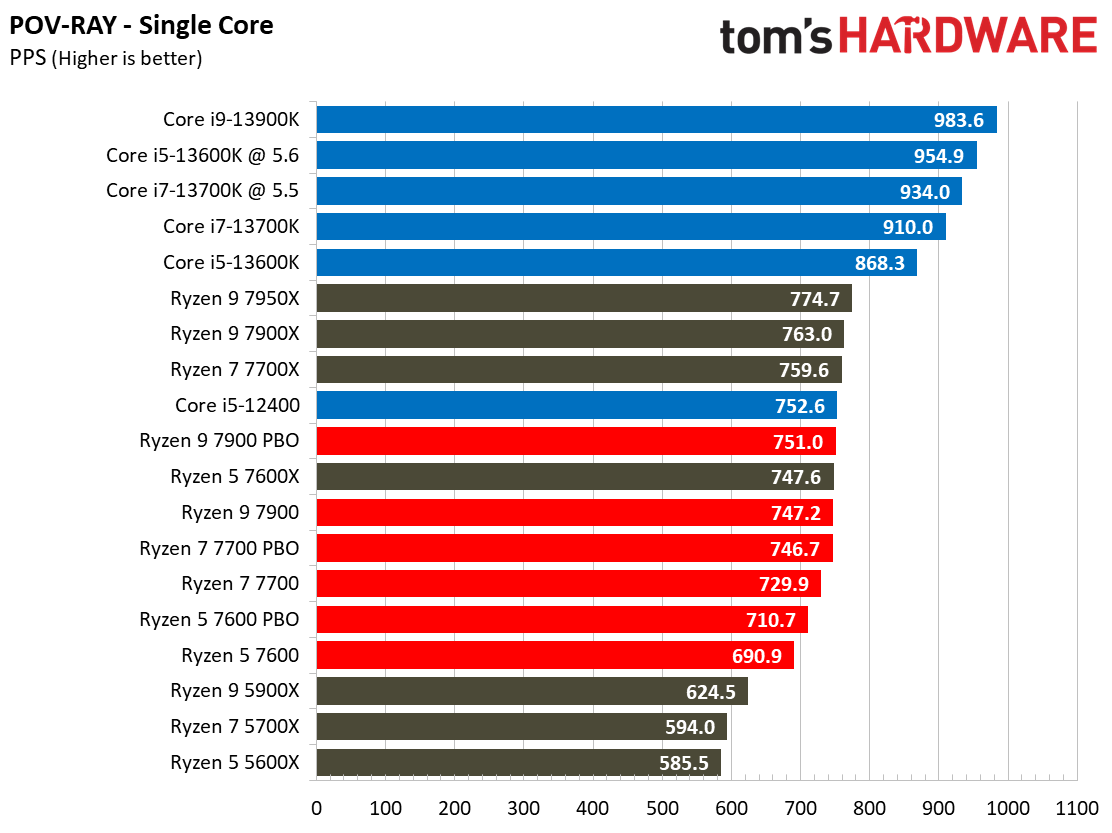
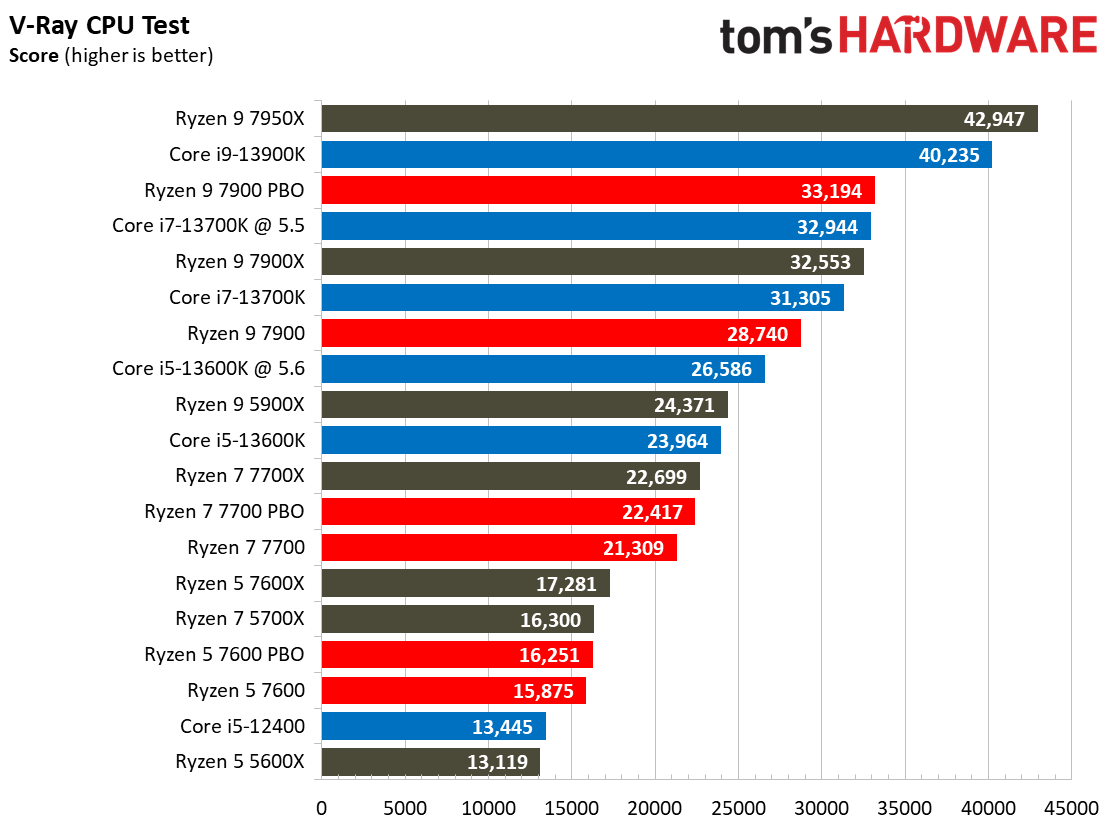
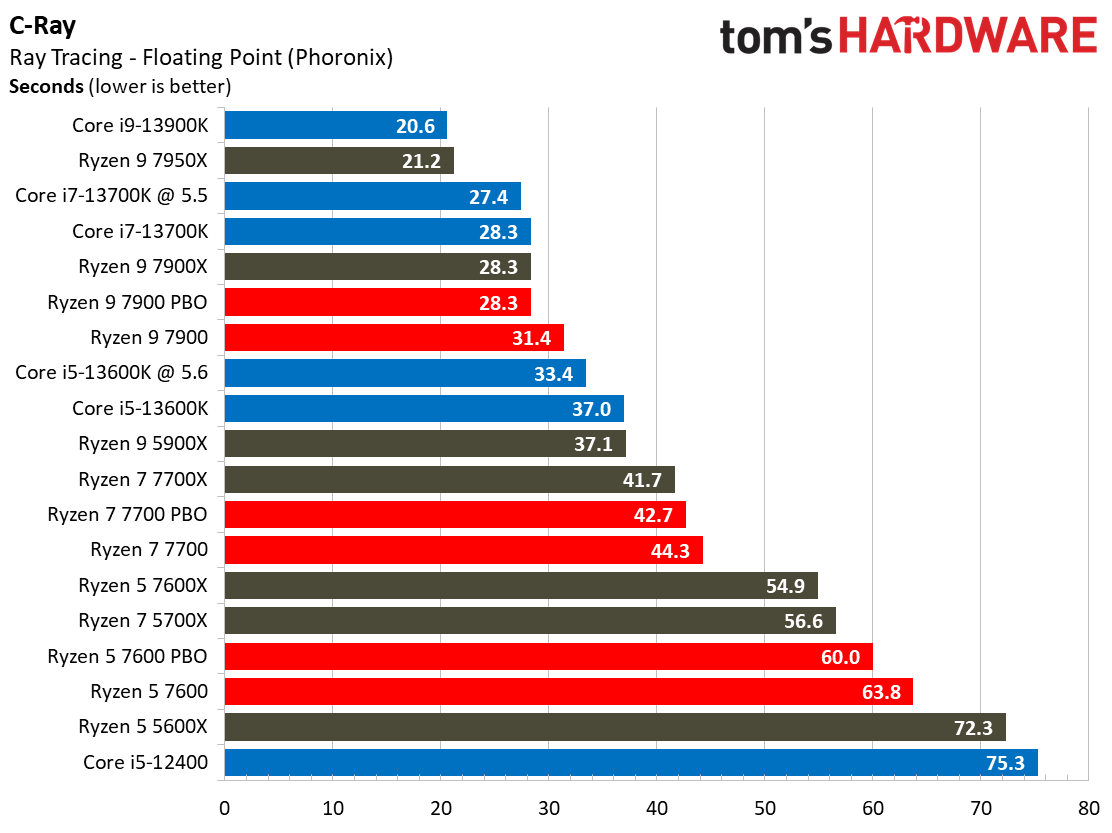
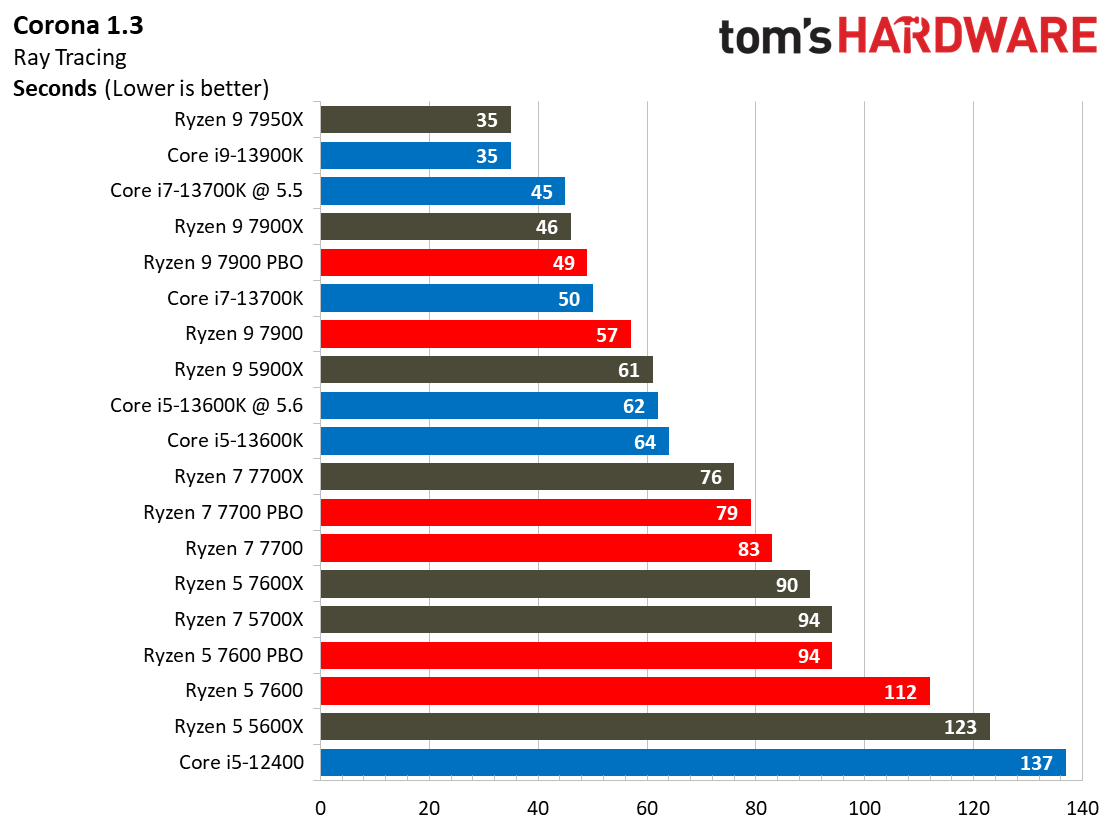
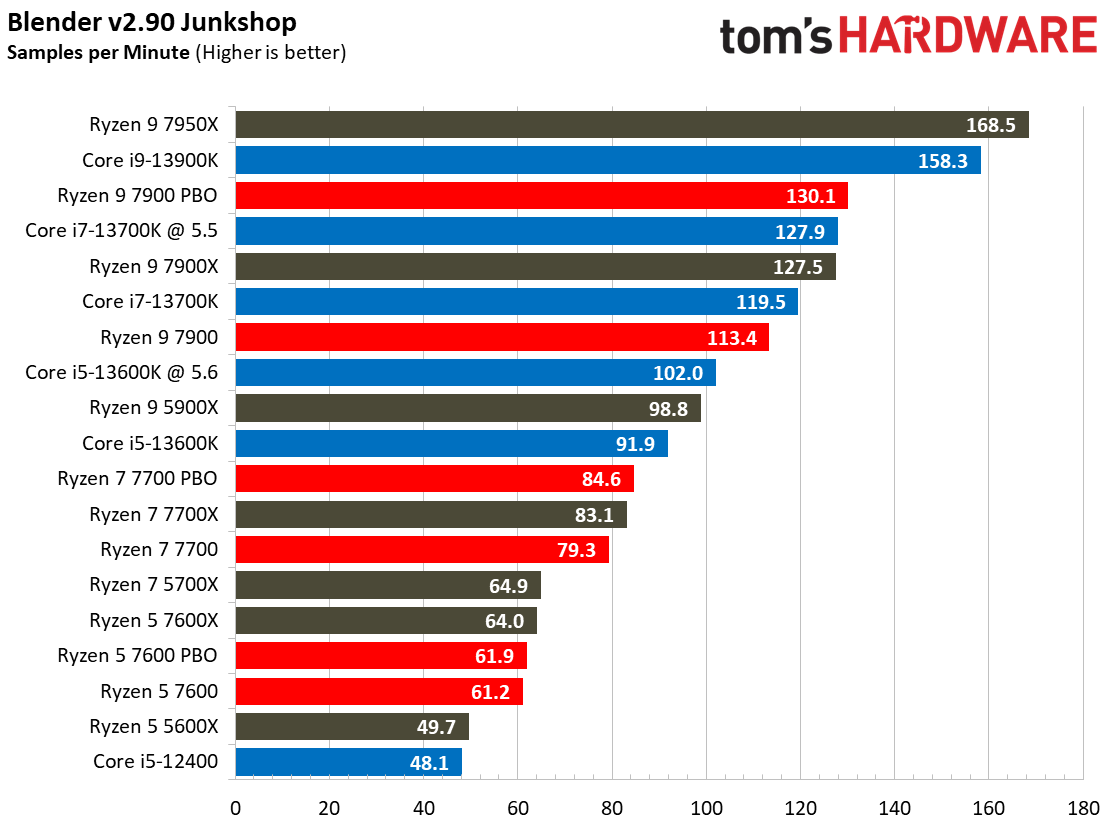

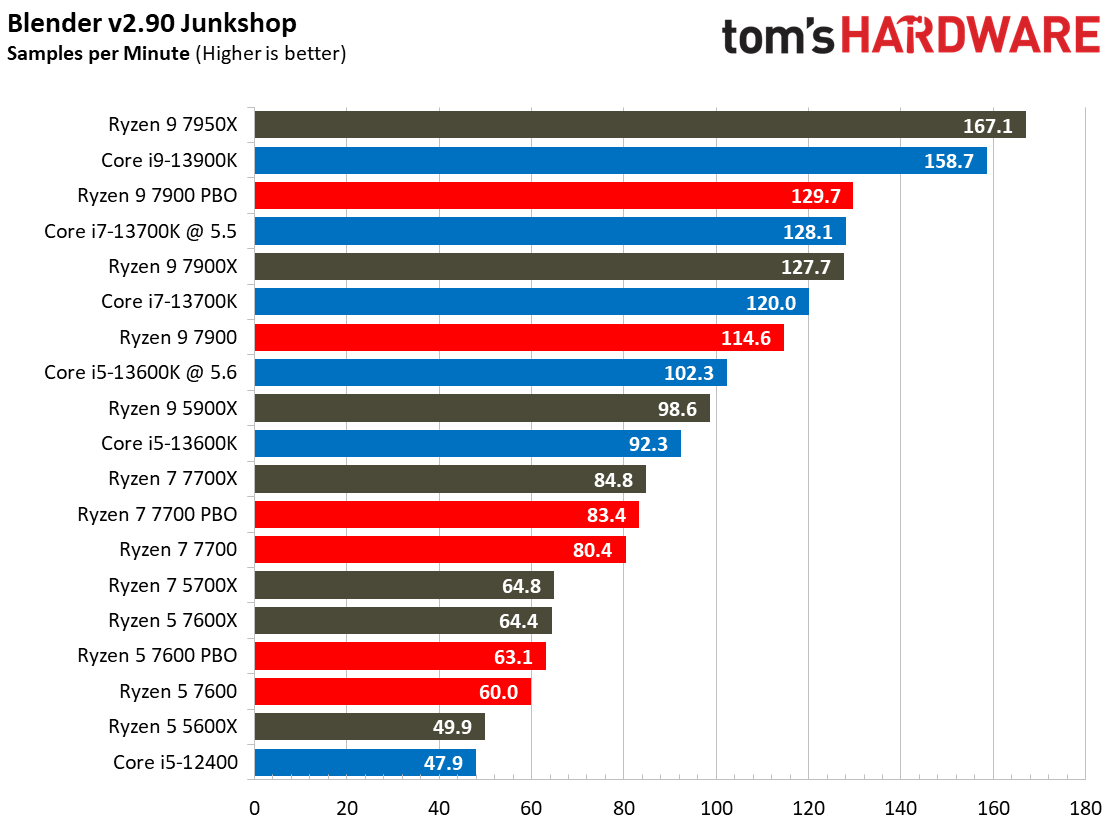
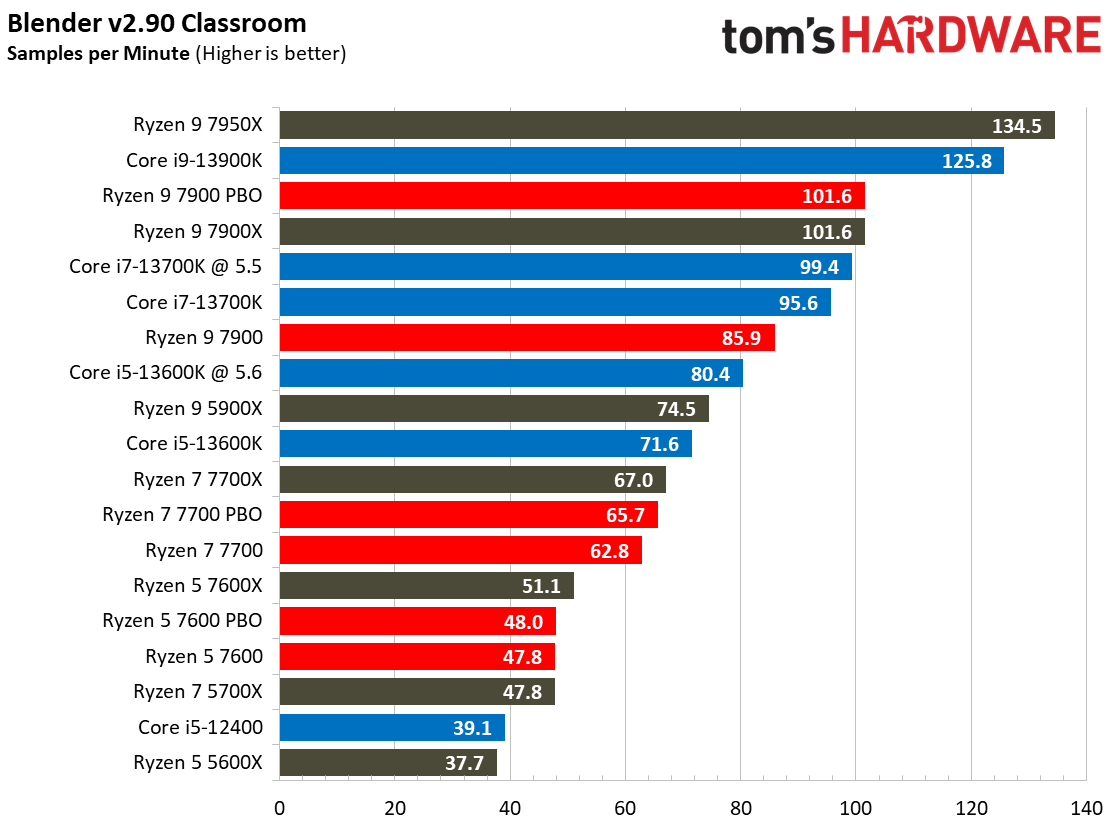
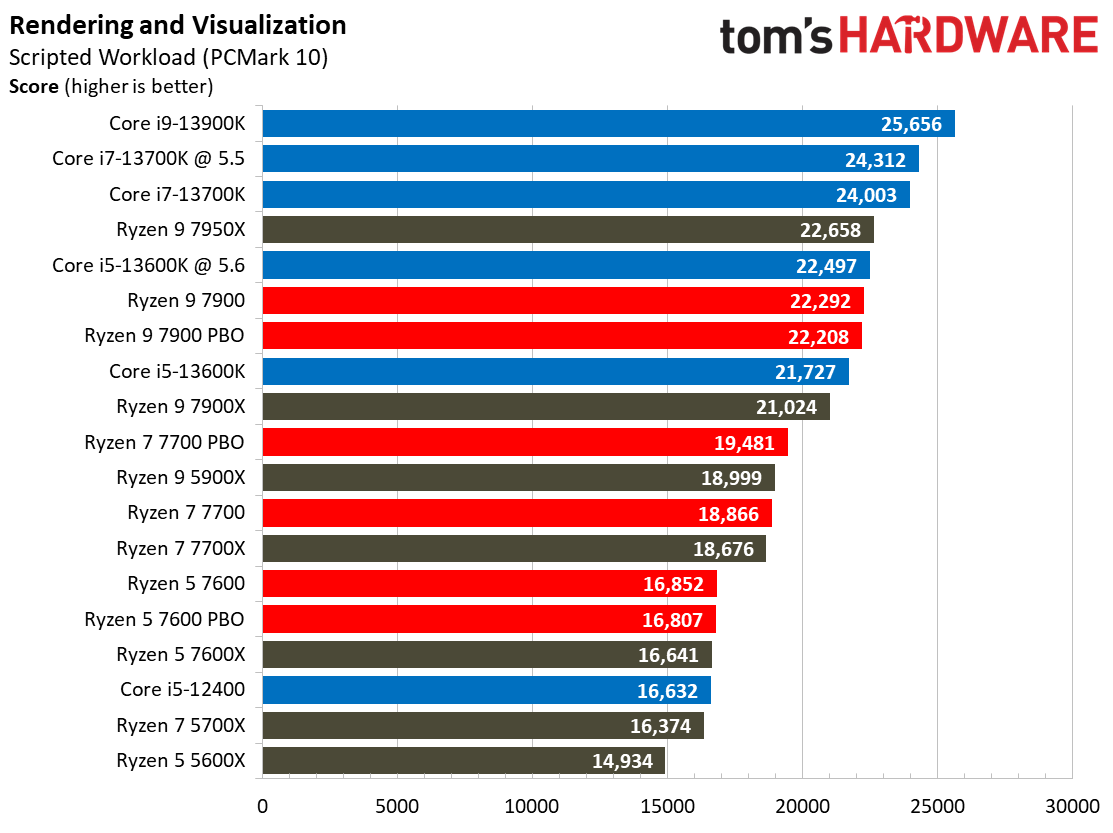
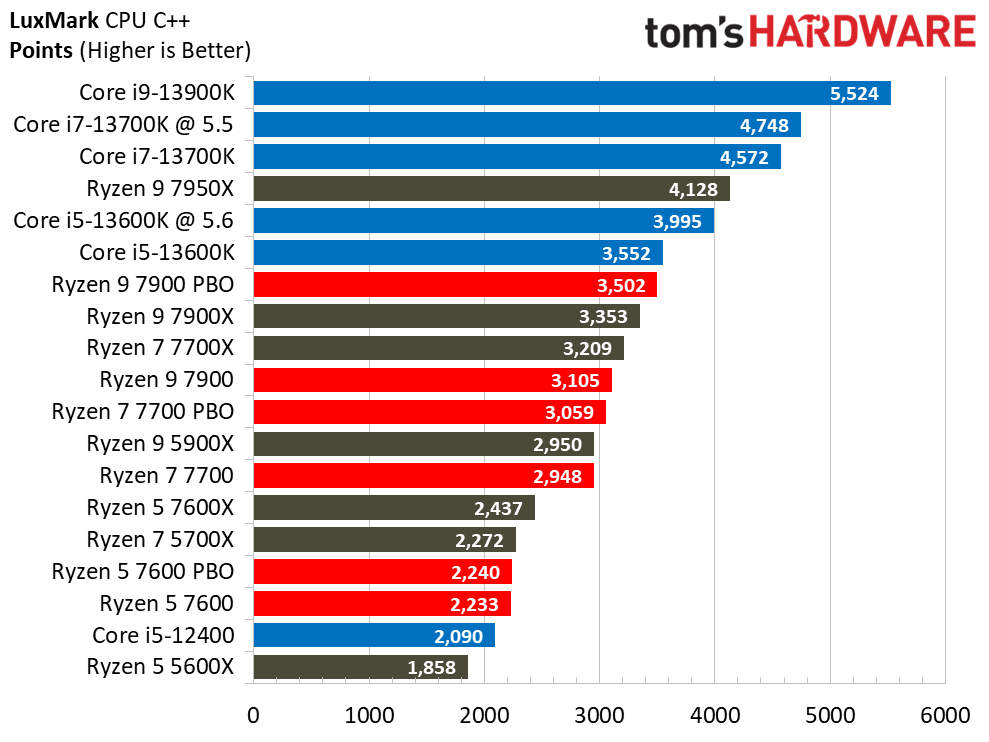
Intel's Raptor Lake rivals or beats AMD's finest in multi-threaded productivity applications at every price point. These results, like many of the results throughout our other application tests below, mirror the established trends of the X-series models. As such, we'll have limited commentary for the application benchmarks.
Encoding Benchmarks on Ryzen 5 7600, Ryzen 7 7700, Ryzen 9 7900
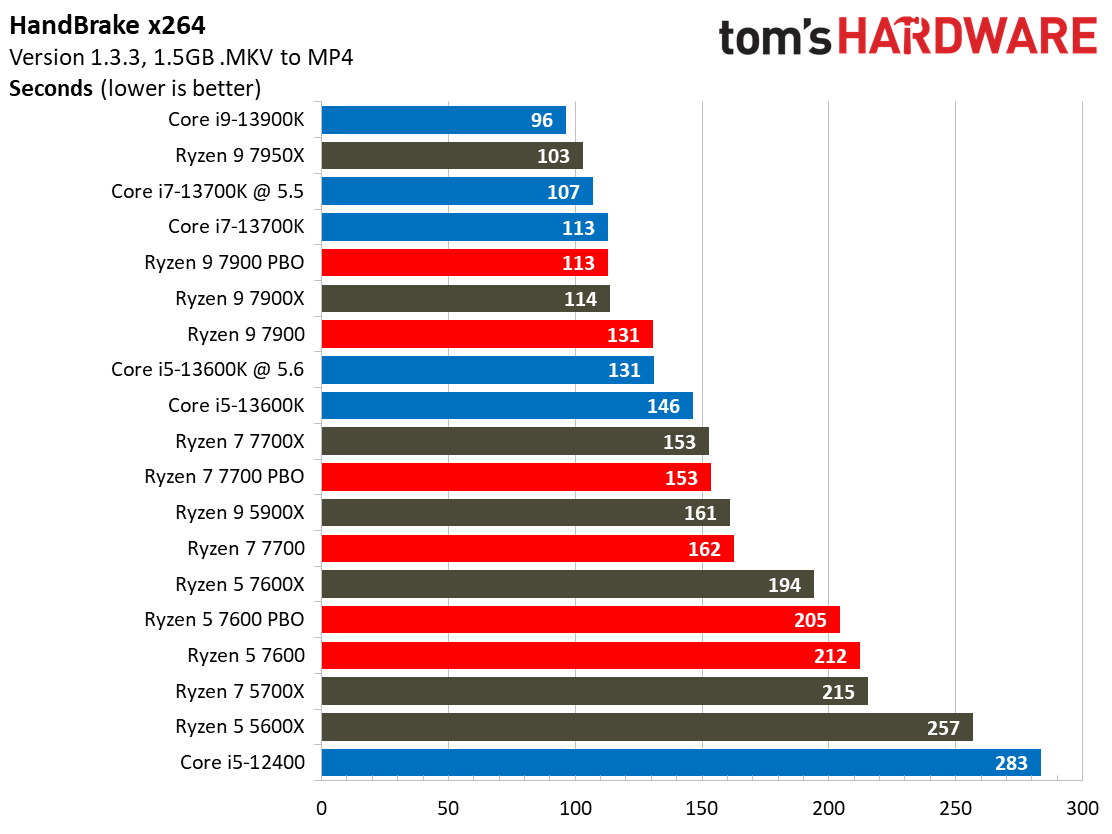
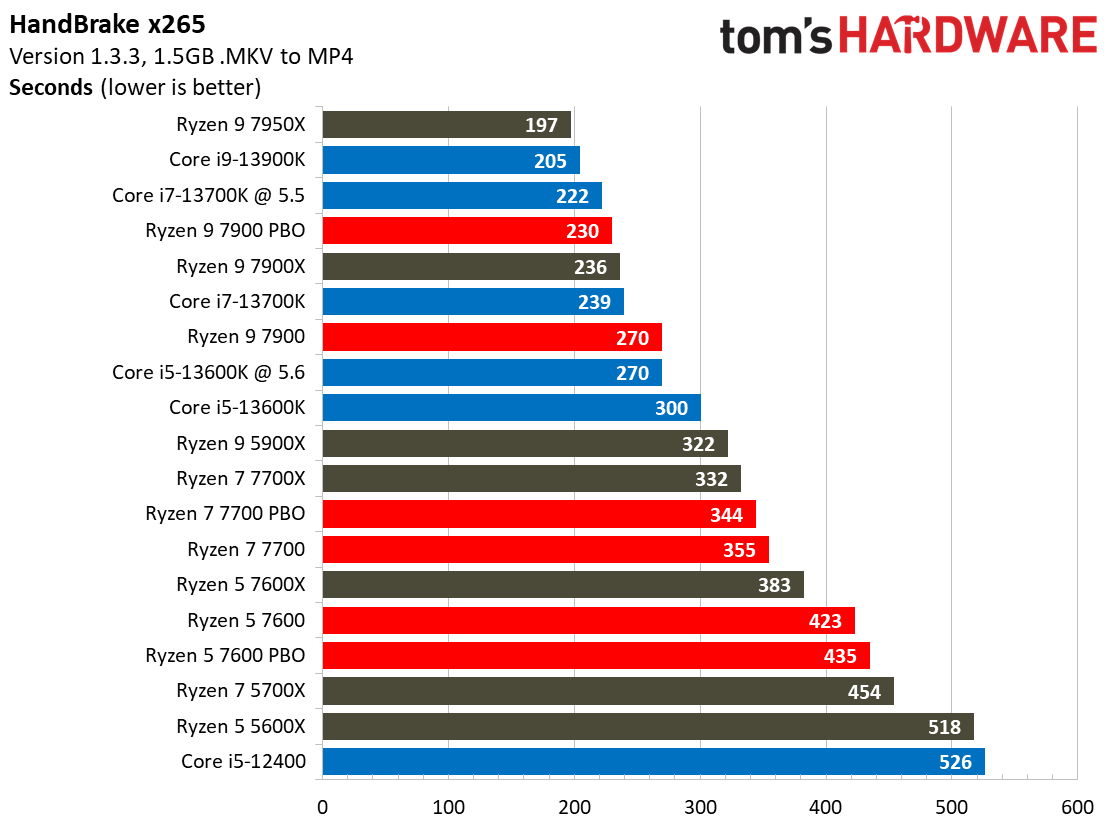
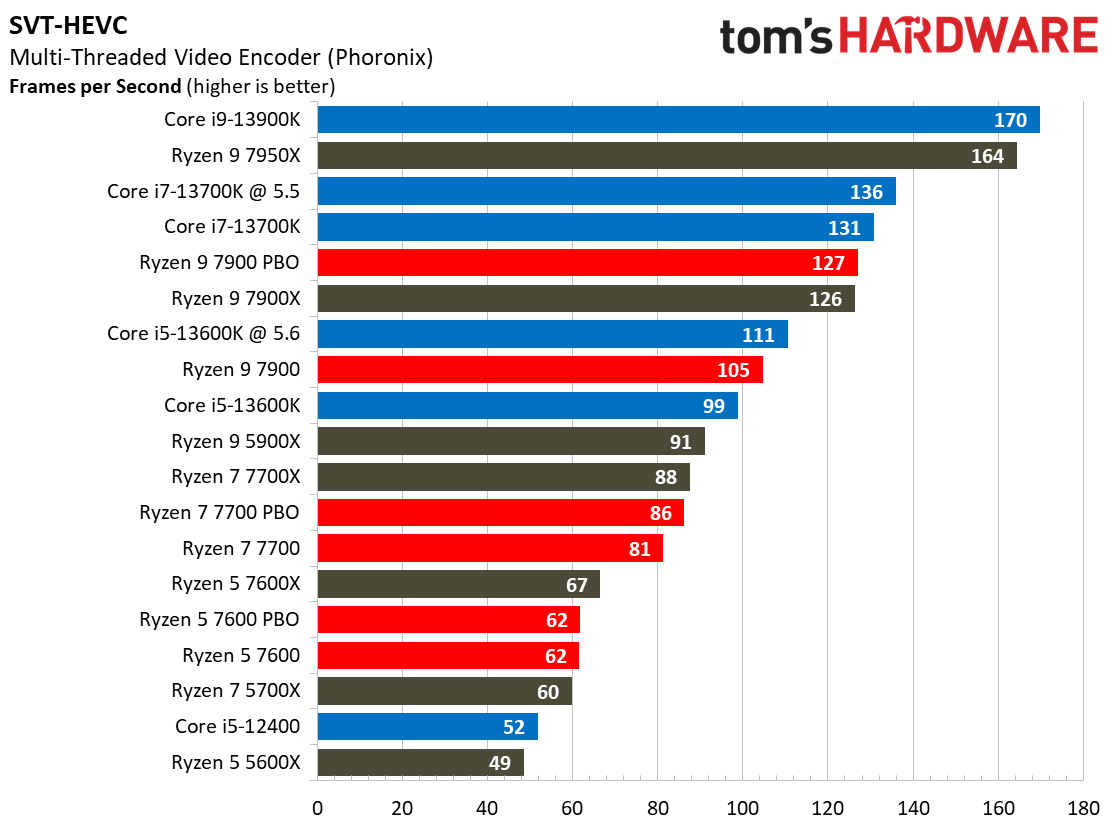
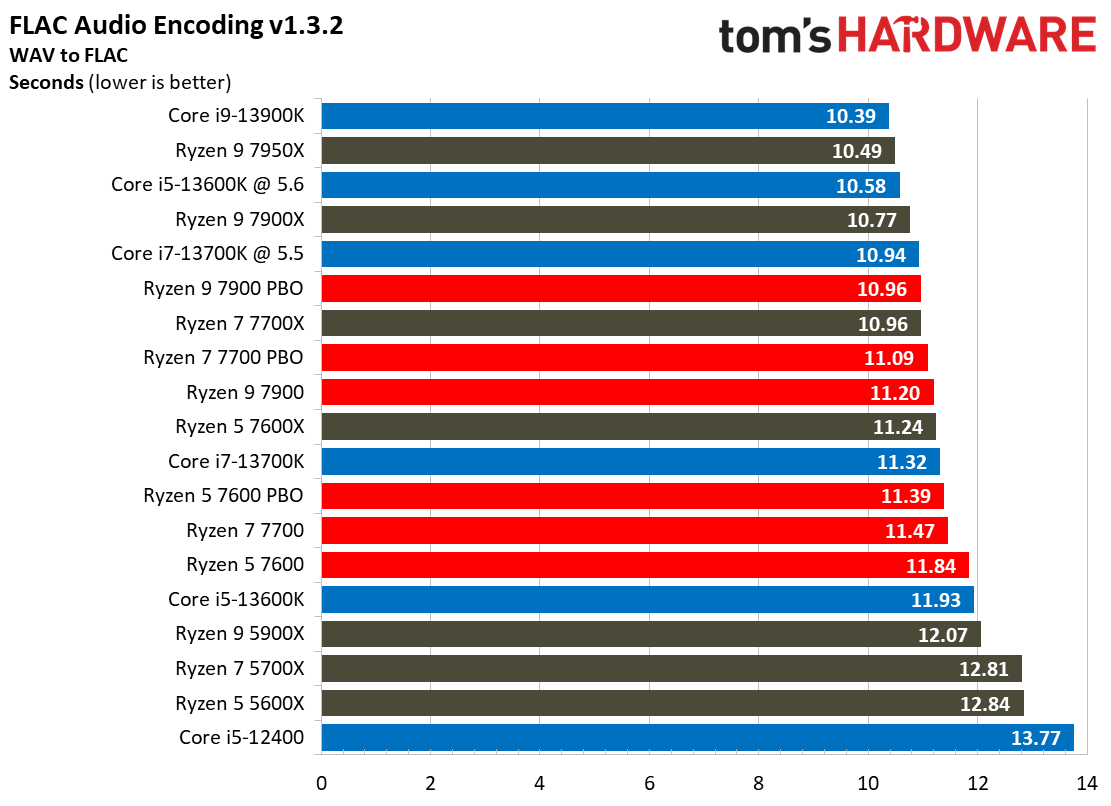
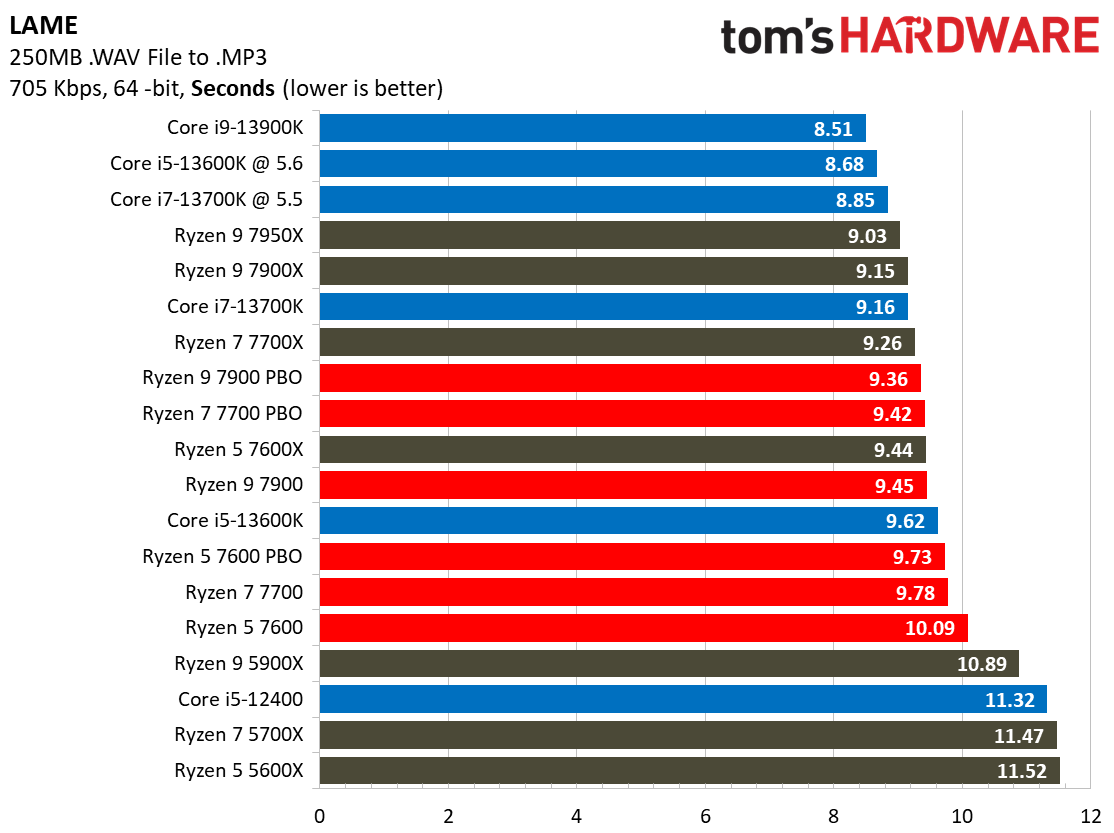
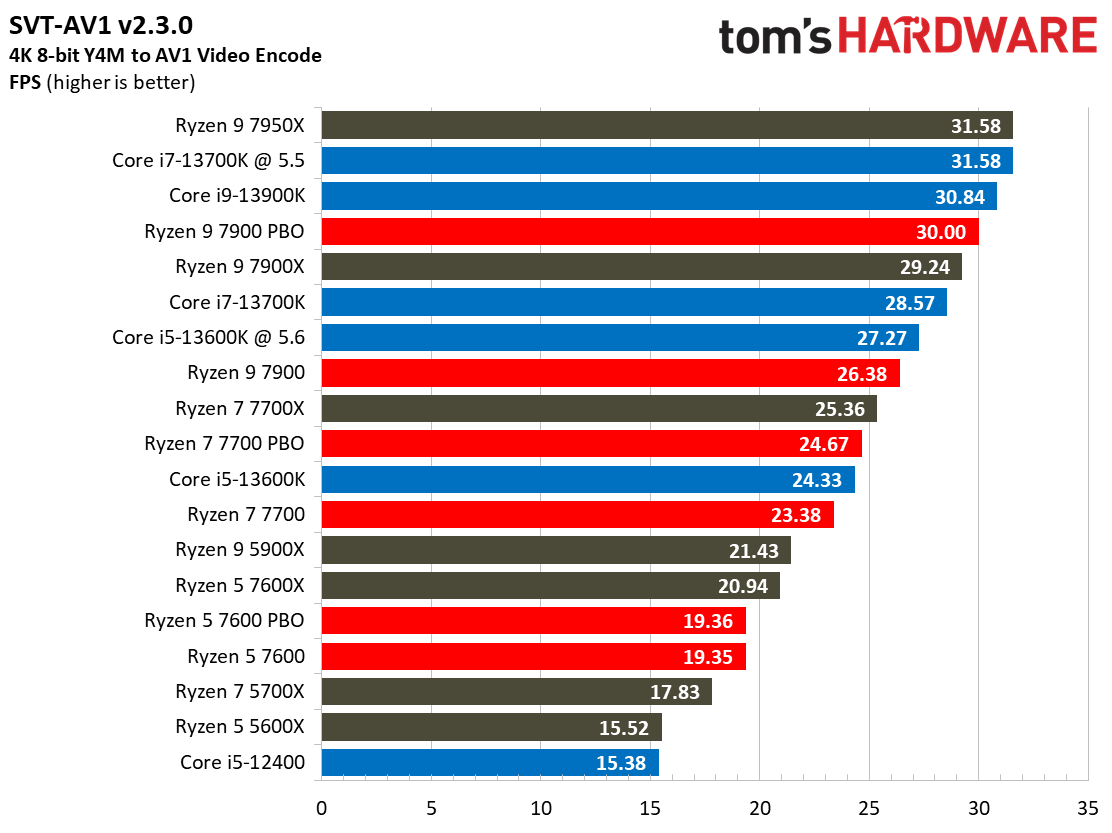
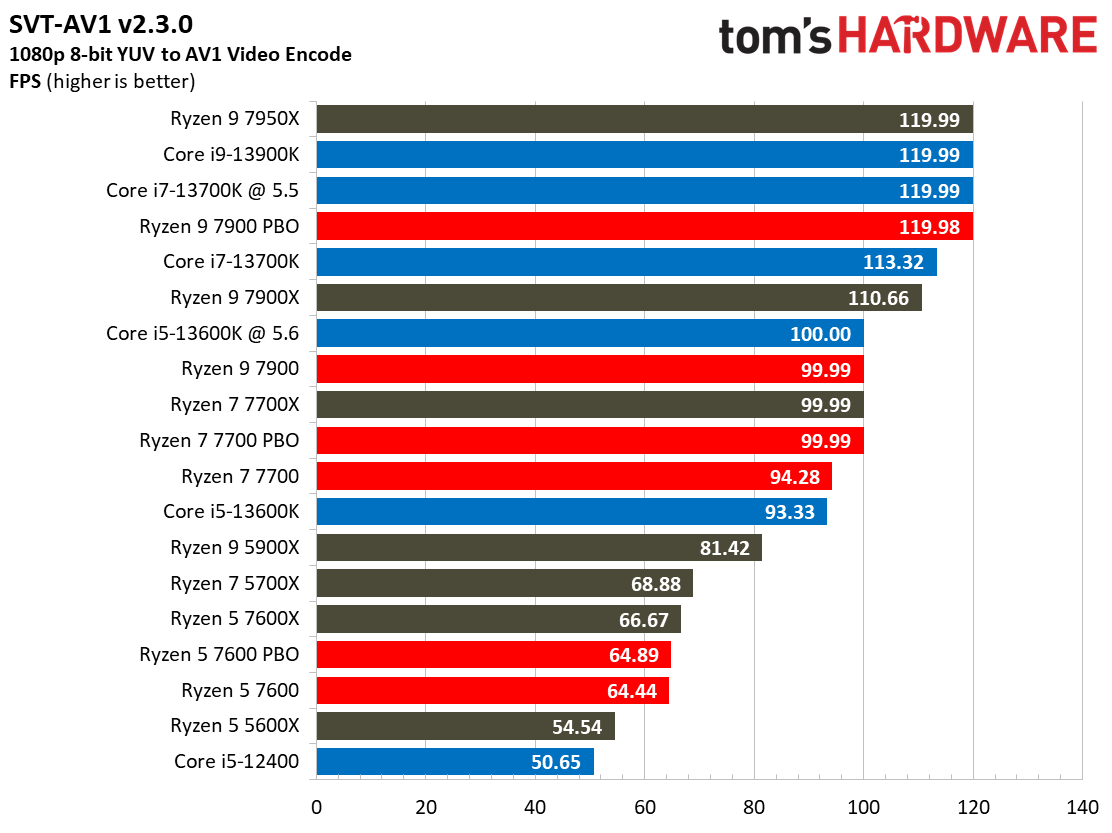
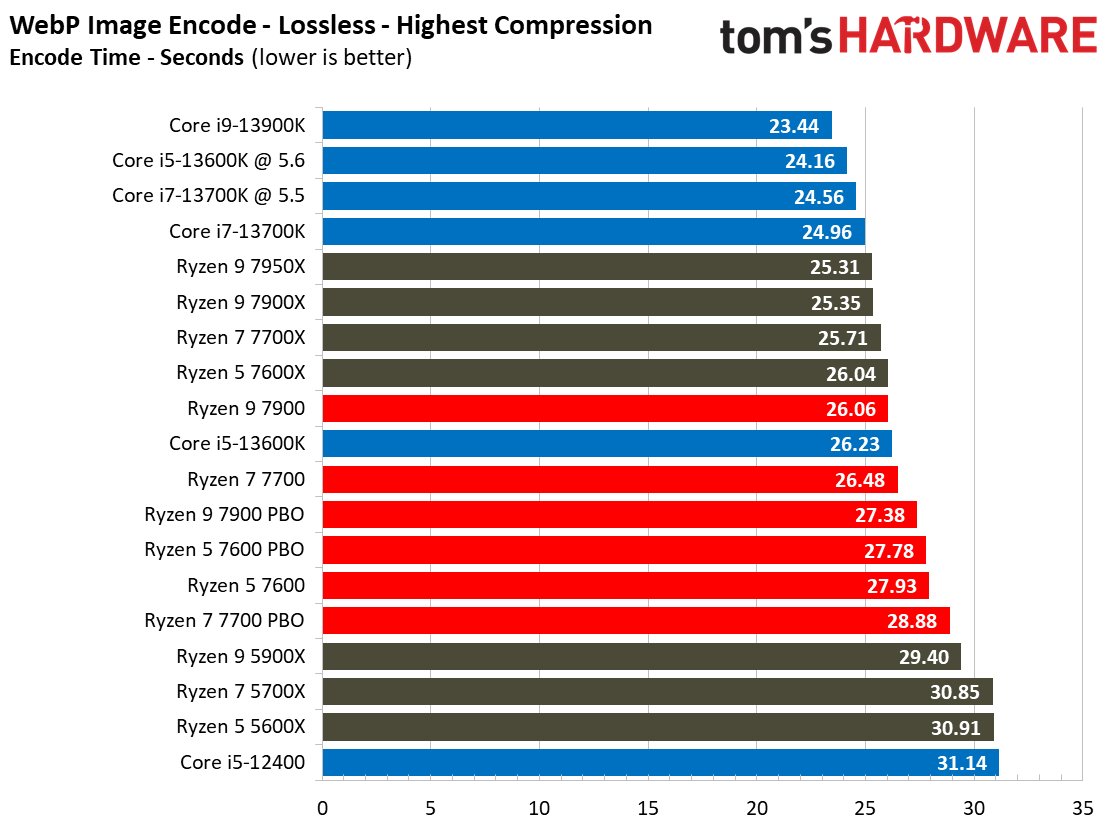
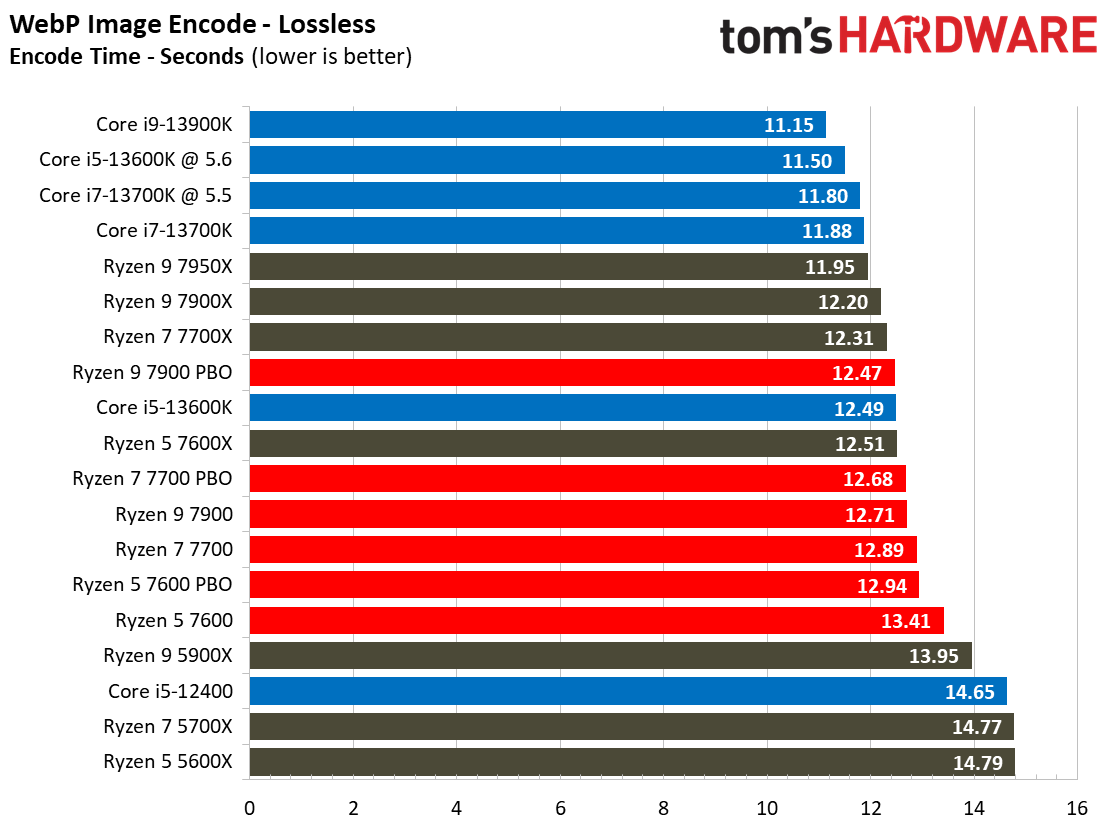
Most encoders tend to be either heavily threaded or almost exclusively single-threaded — it takes an agile chip to master both disciplines. As an interesting aside, the speed of these modern chips has broken our AV1 1080p benchmark; the Core i9 and Ryzen 9 models are fast enough that they plateau at the top speed in the chart (especially the overclocked configurations). We'll update with a suitable replacement in the future.
Web Browsing, Office and Productivity on Ryzen 5 7600, Ryzen 7 7700, Ryzen 9 7900
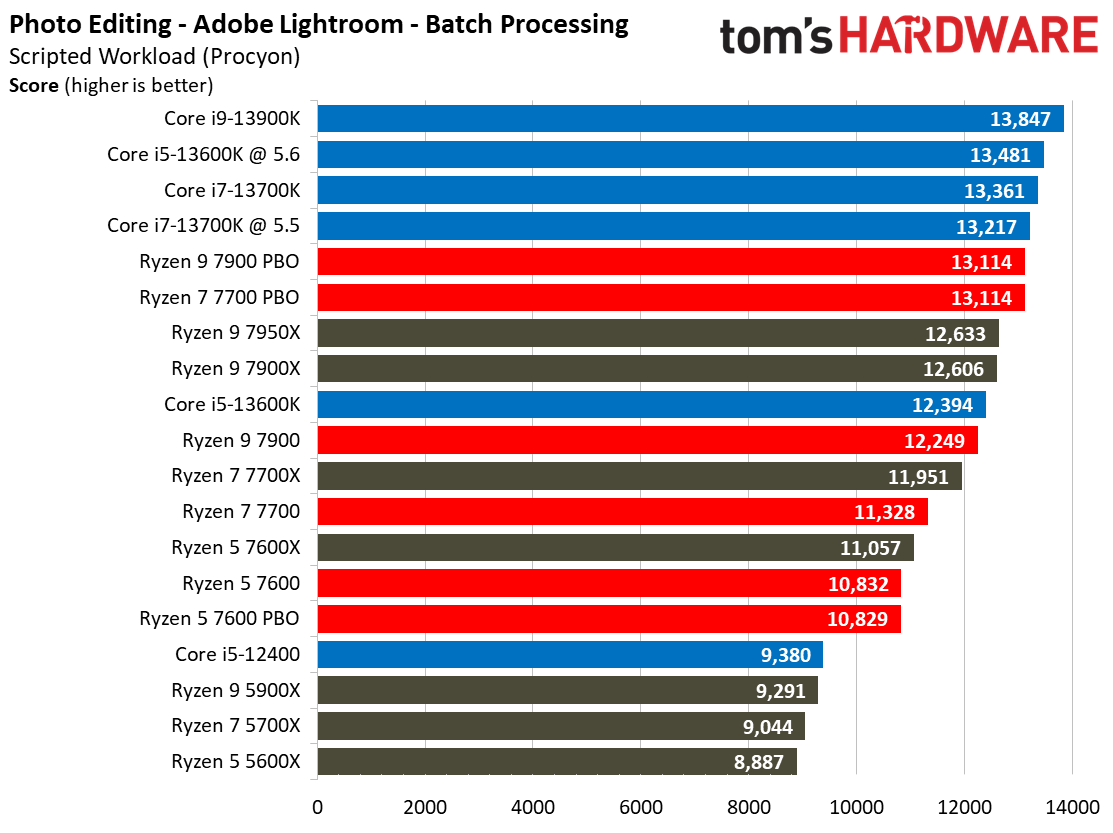
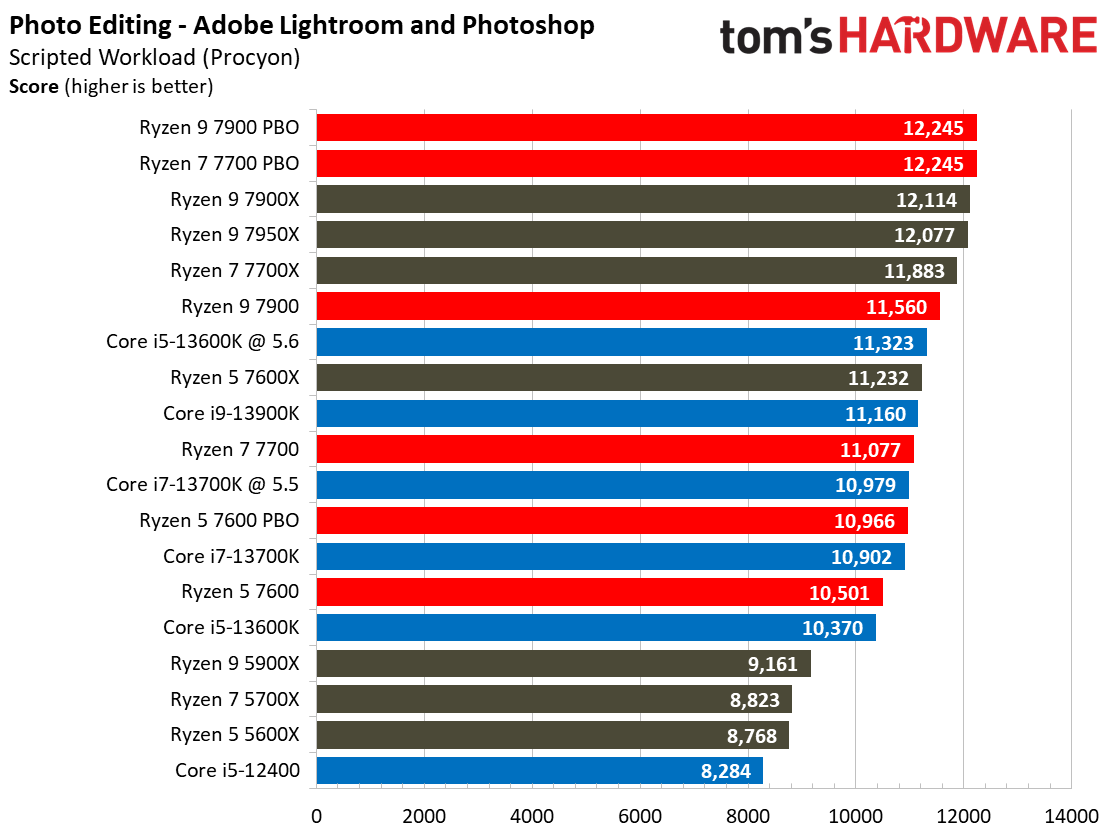
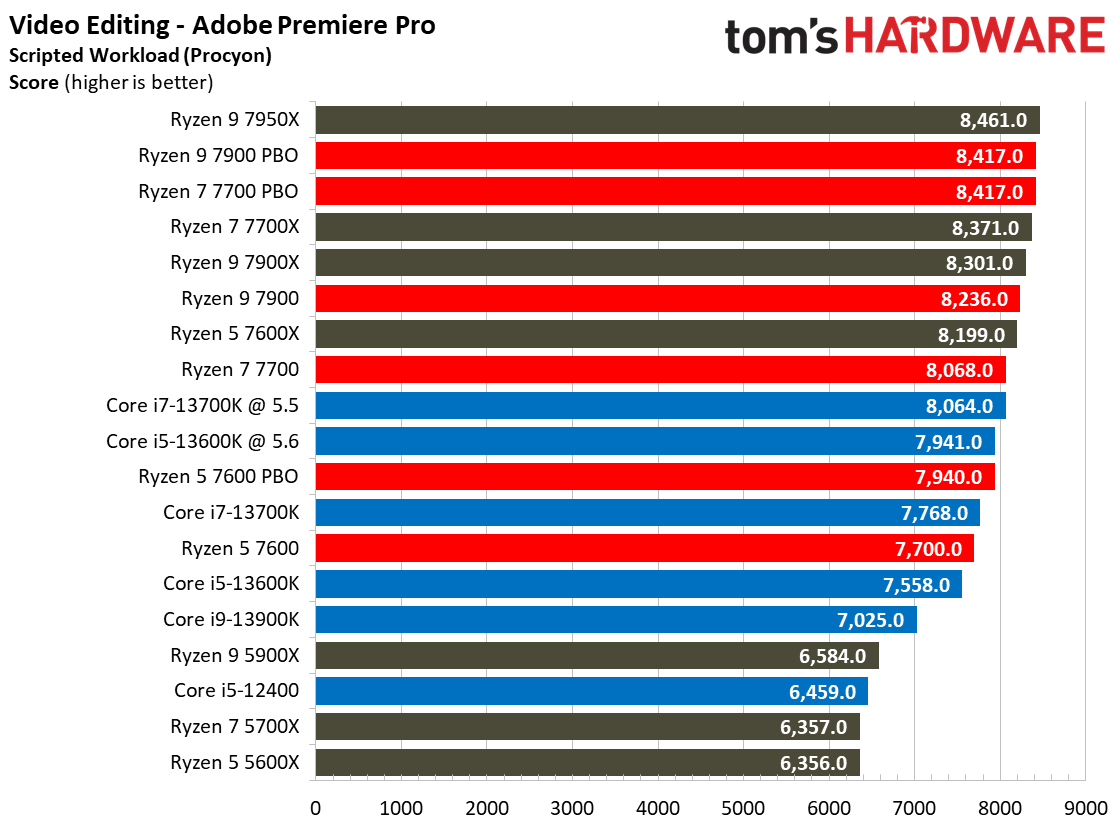
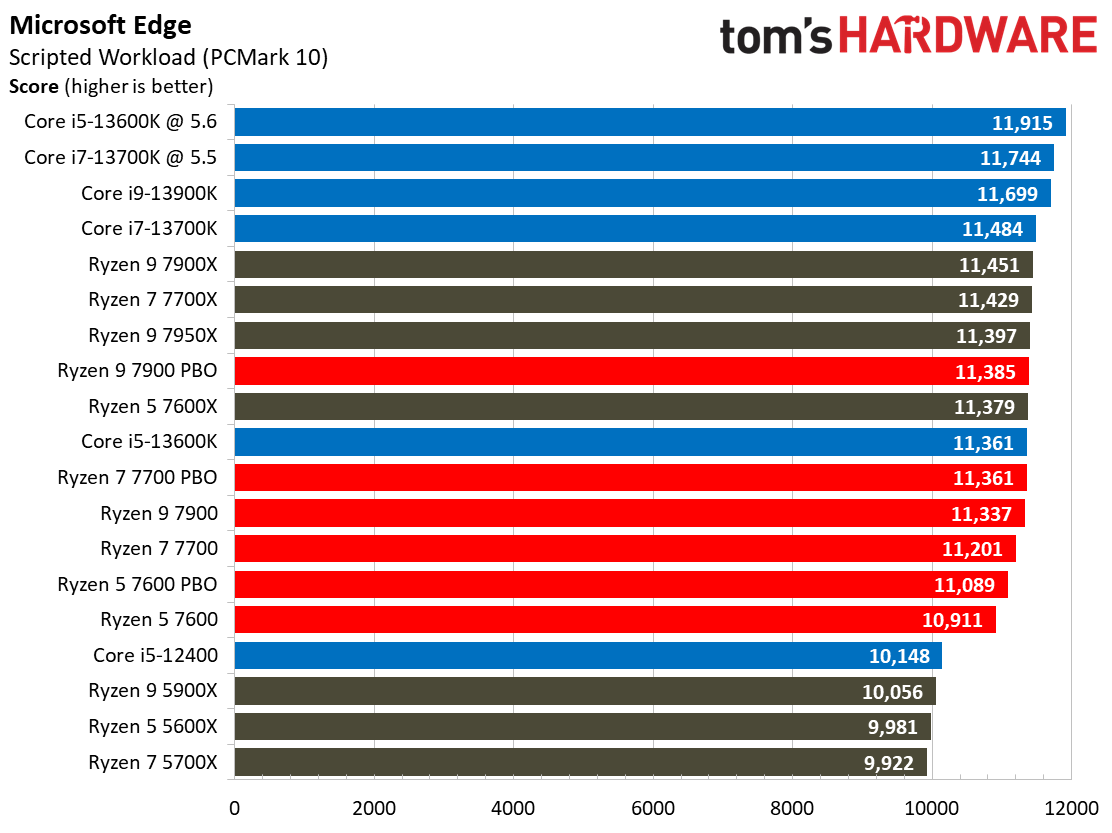
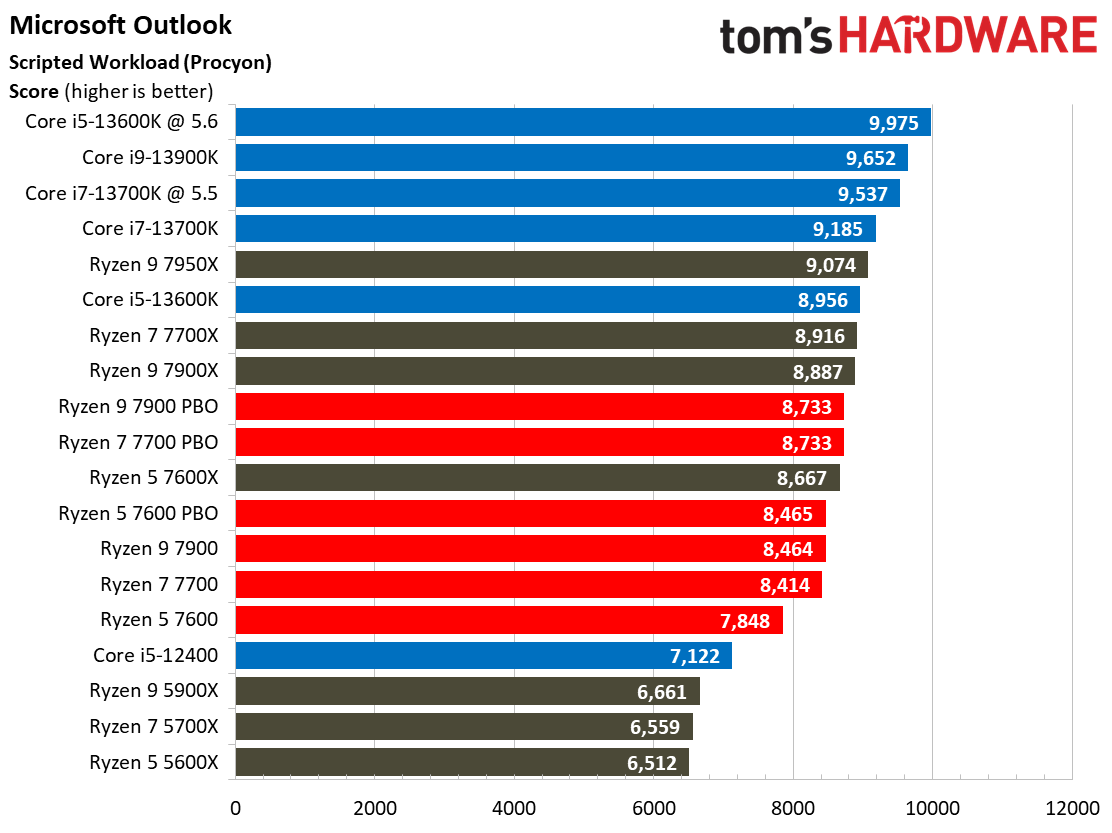
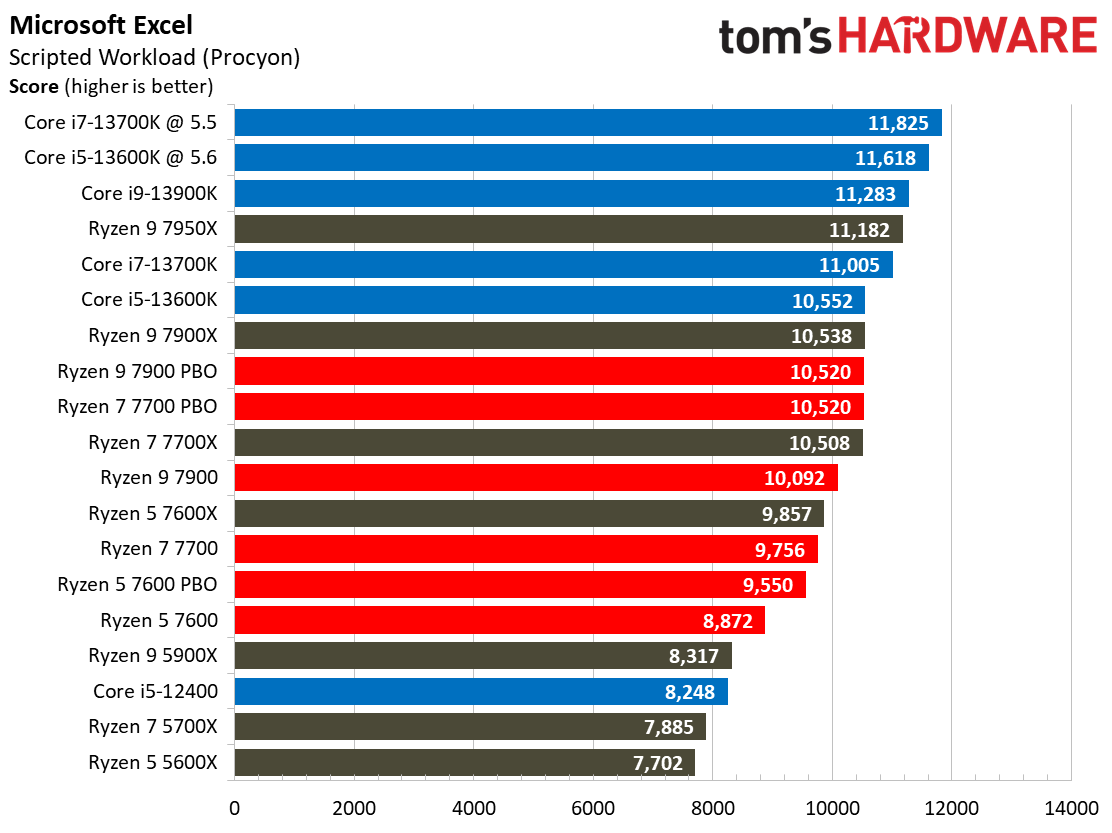
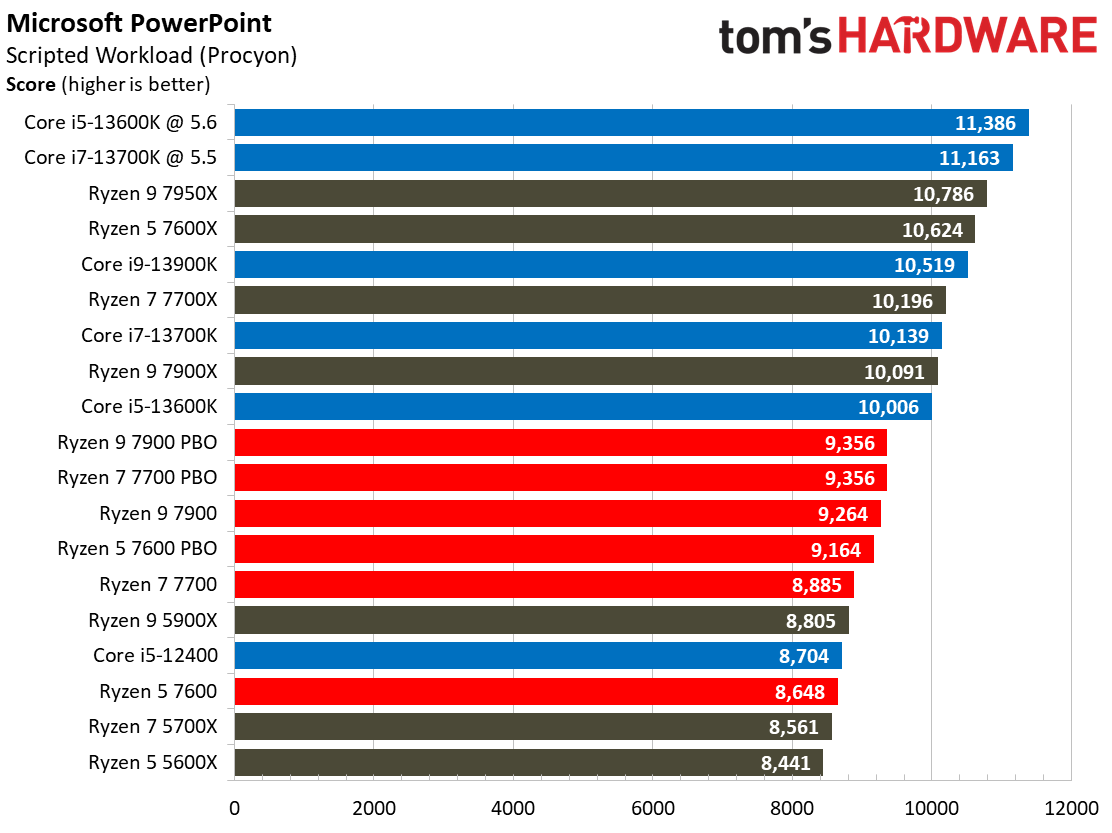
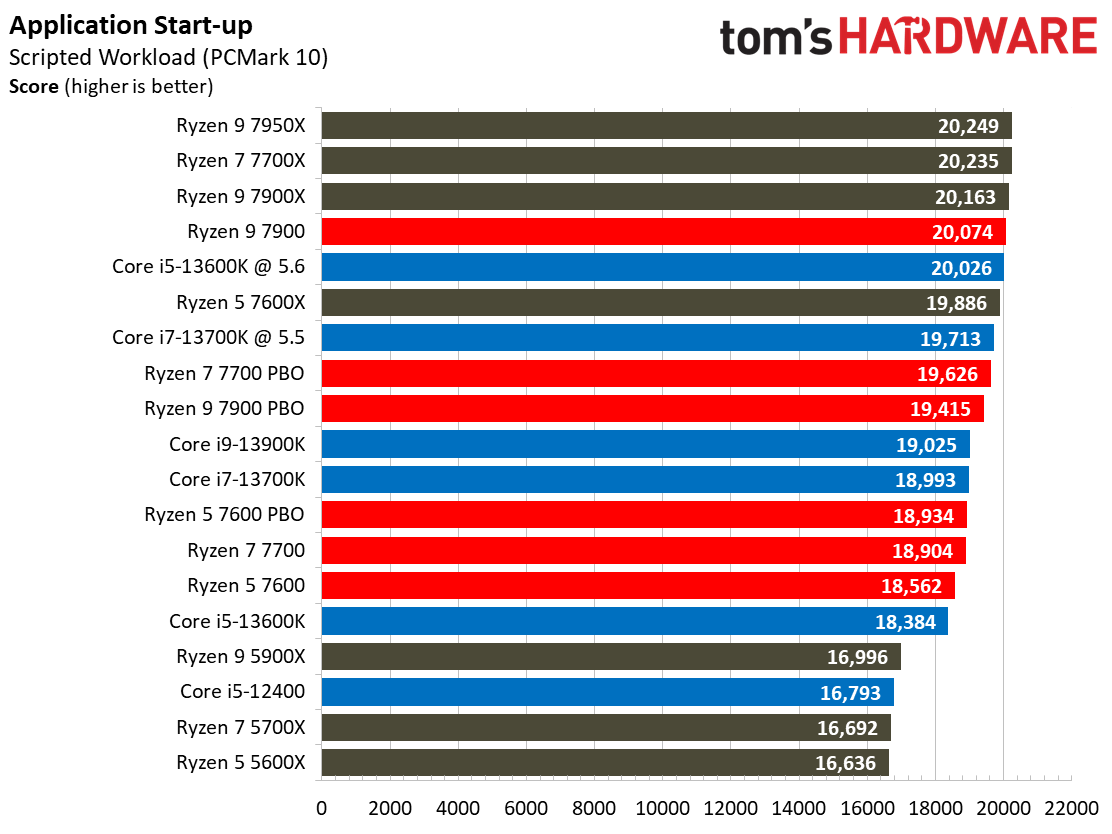
The ubiquitous web browser is one of the most frequently used applications. These latency-sensitive tests tend to be lightly threaded, so a fast response time is critical.
Compilation, Compression, AVX-512 Performance on Ryzen 5 7600, Ryzen 7 7700, Ryzen 9 7900
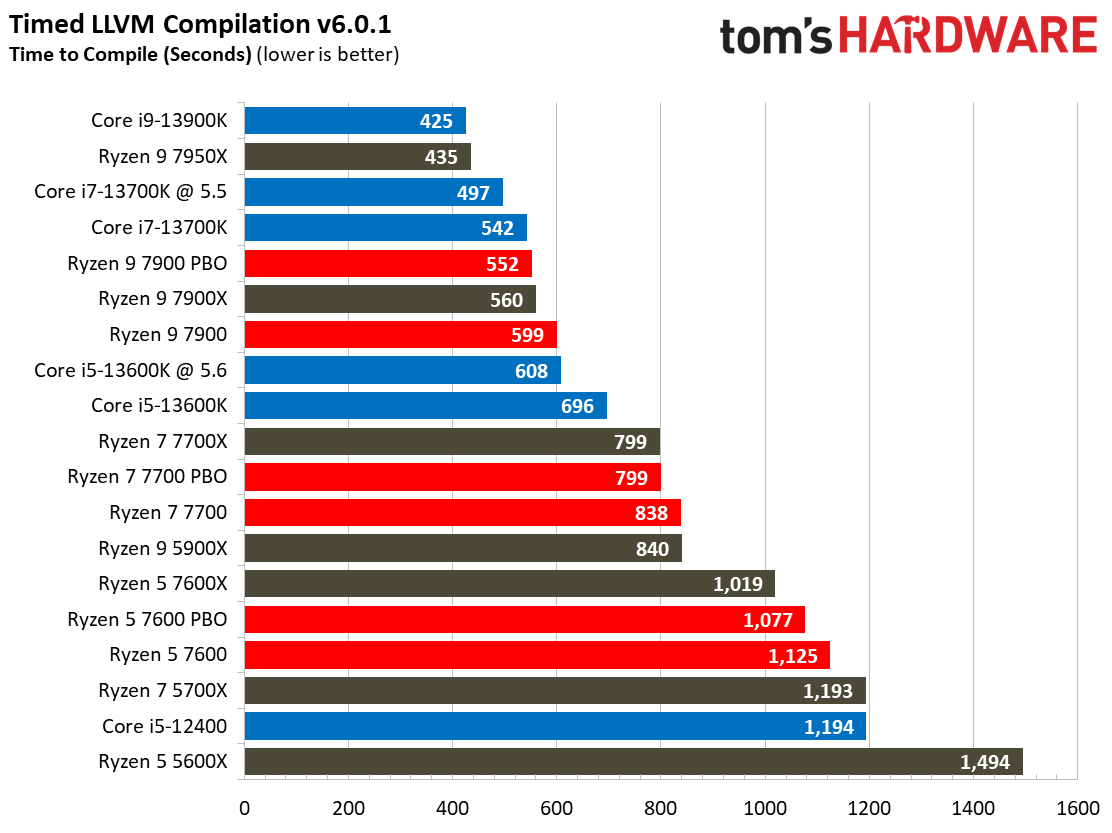
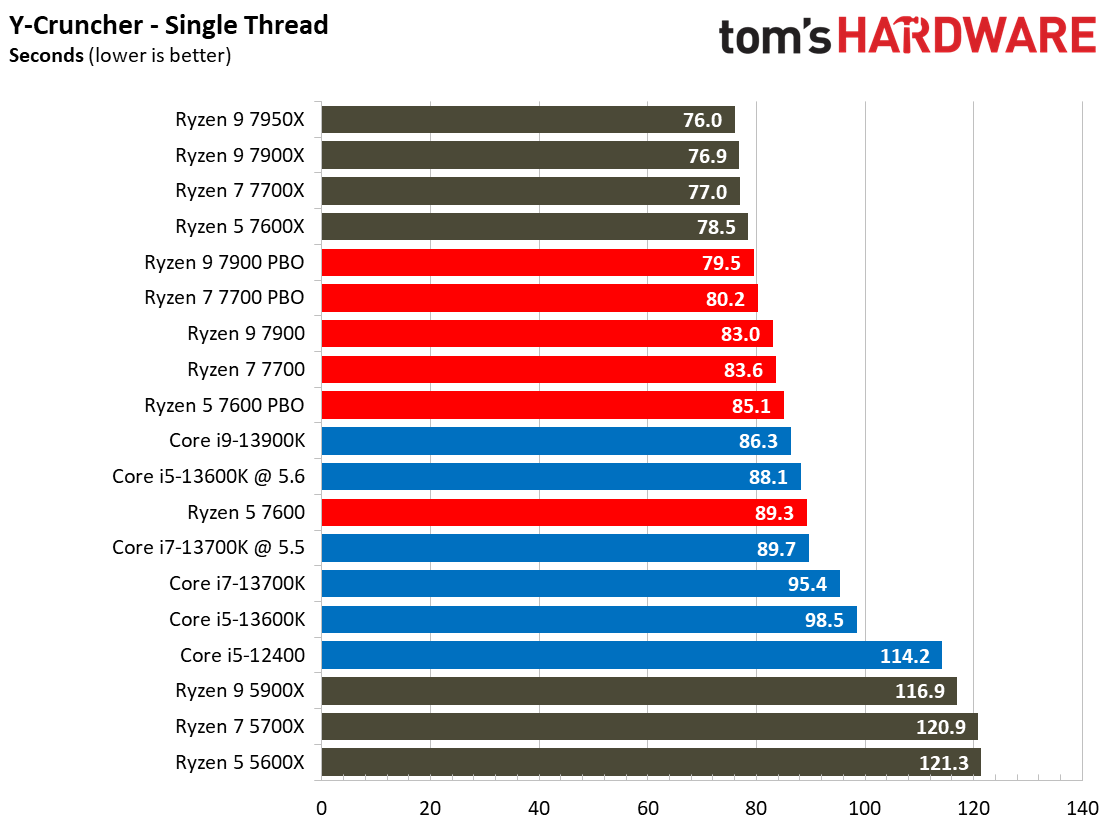
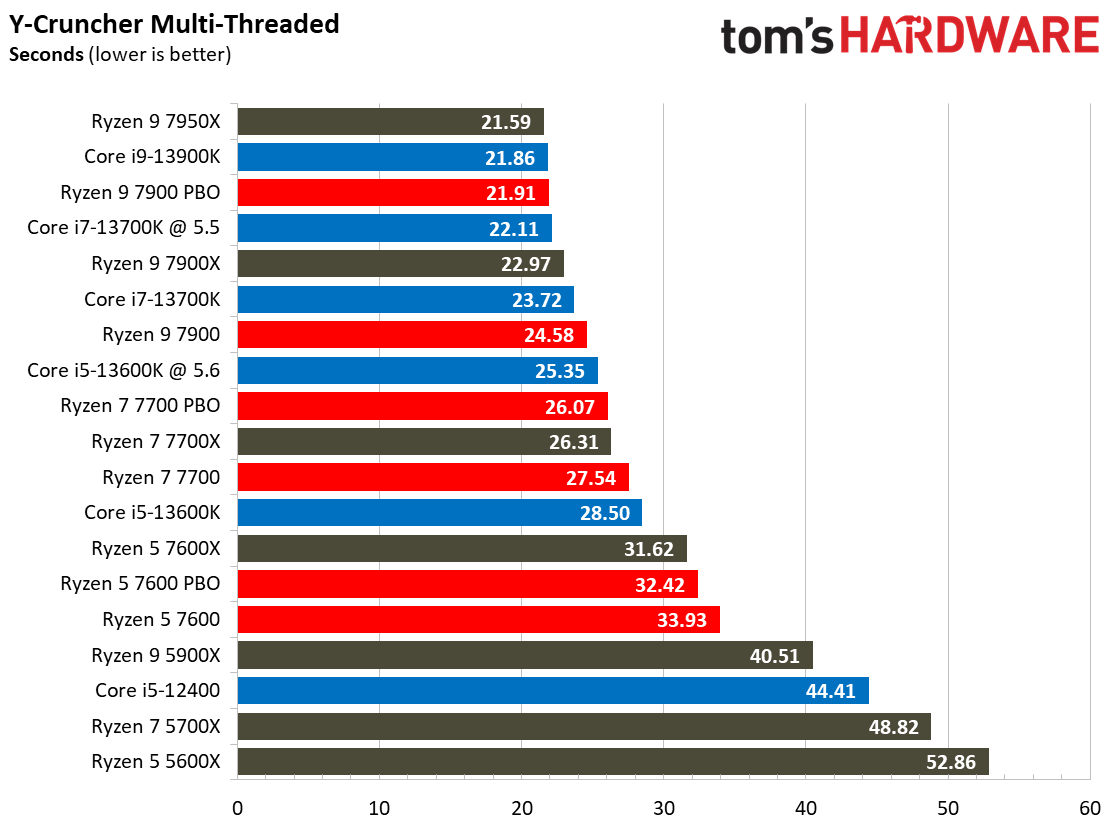
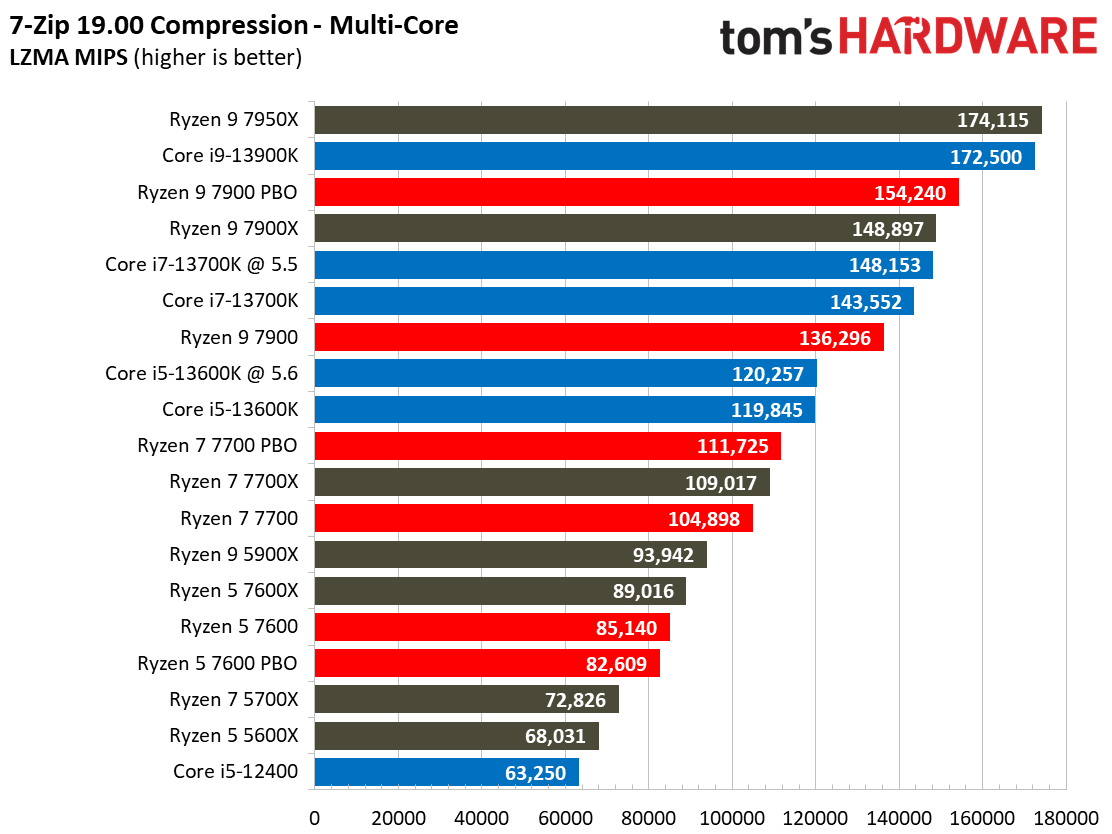
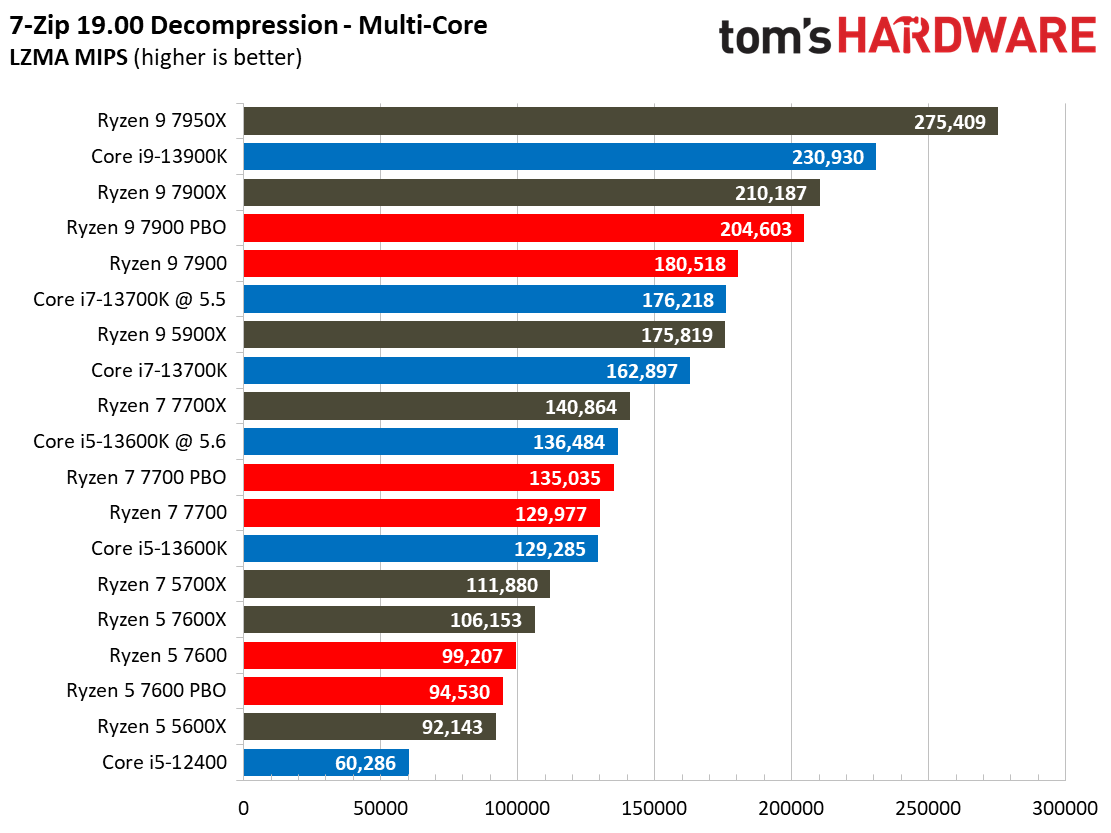
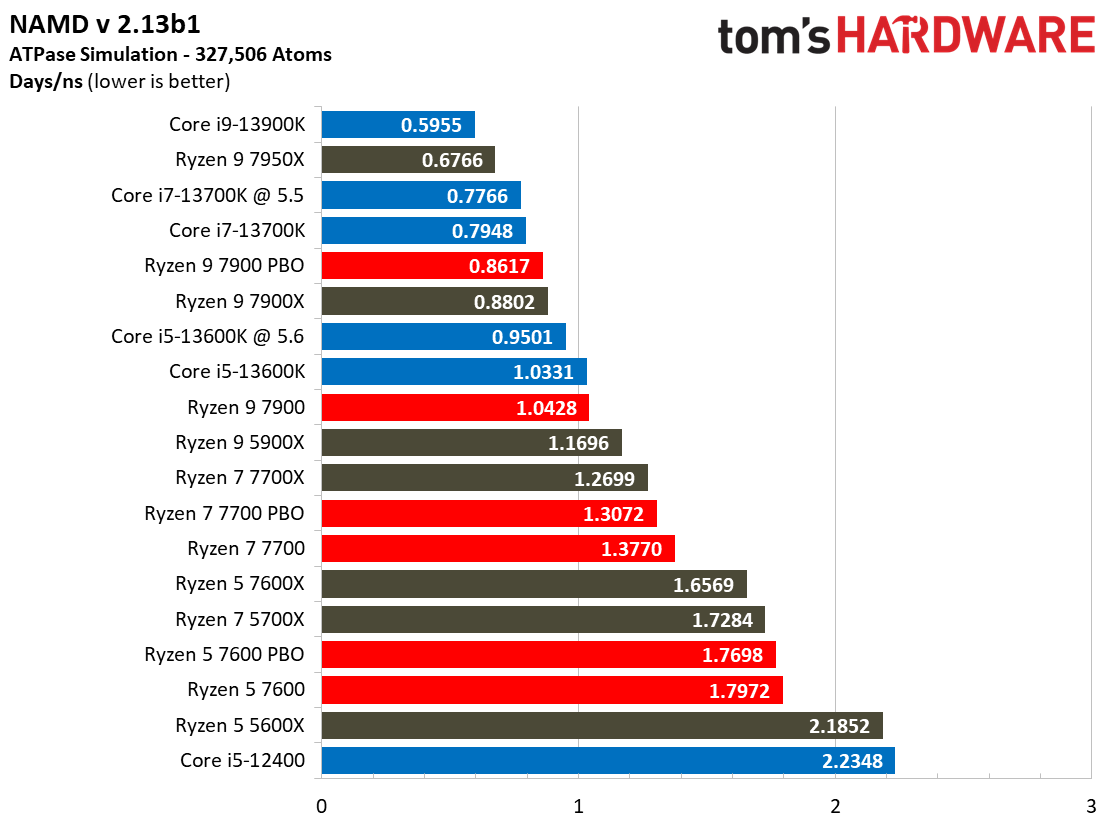
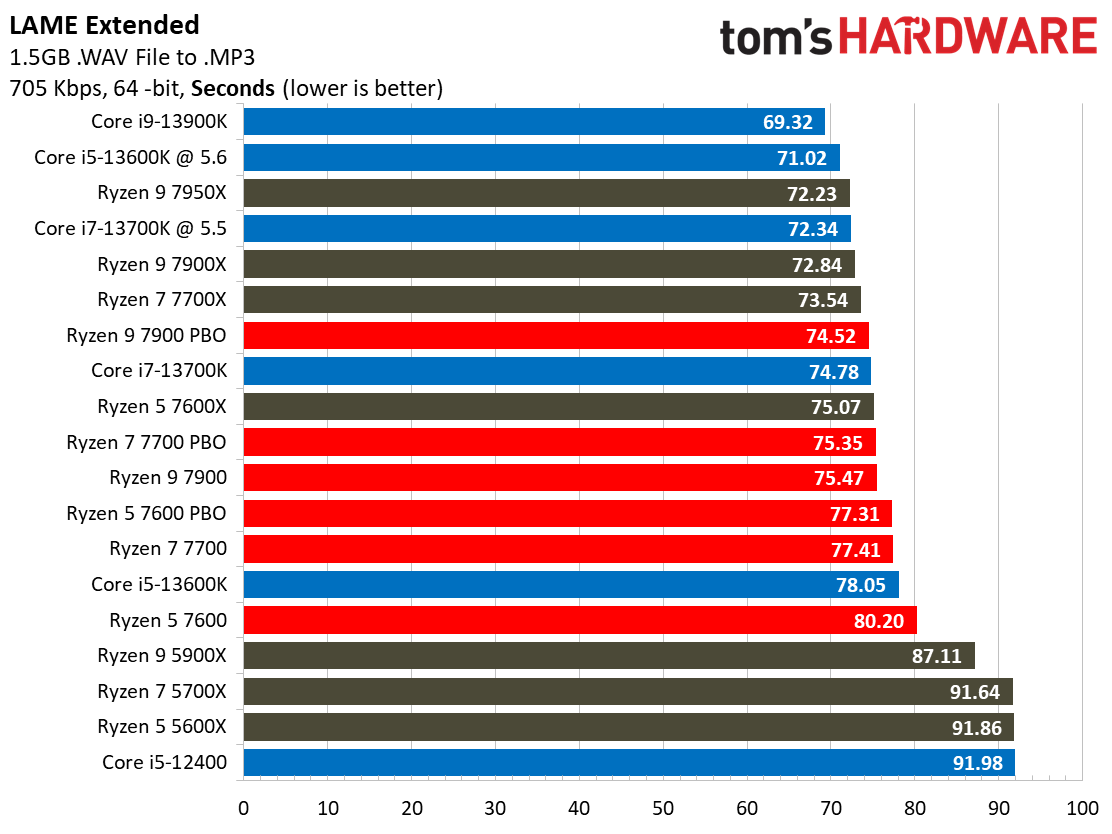
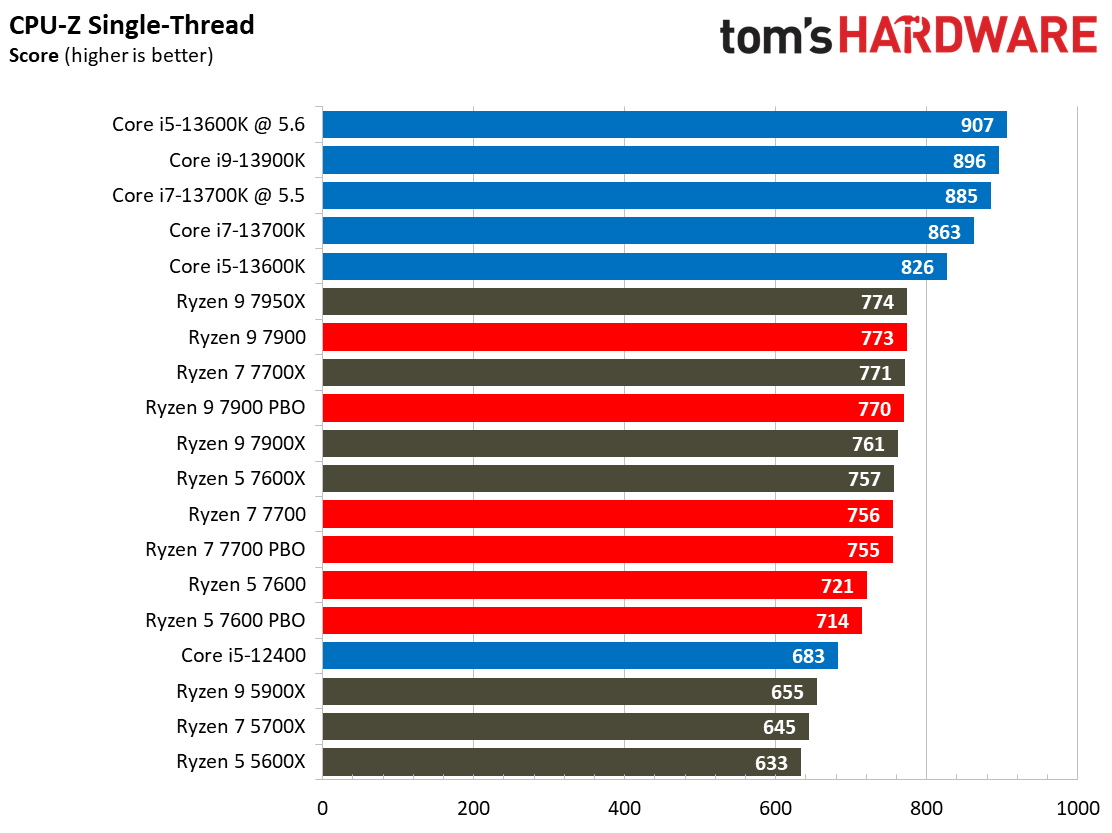
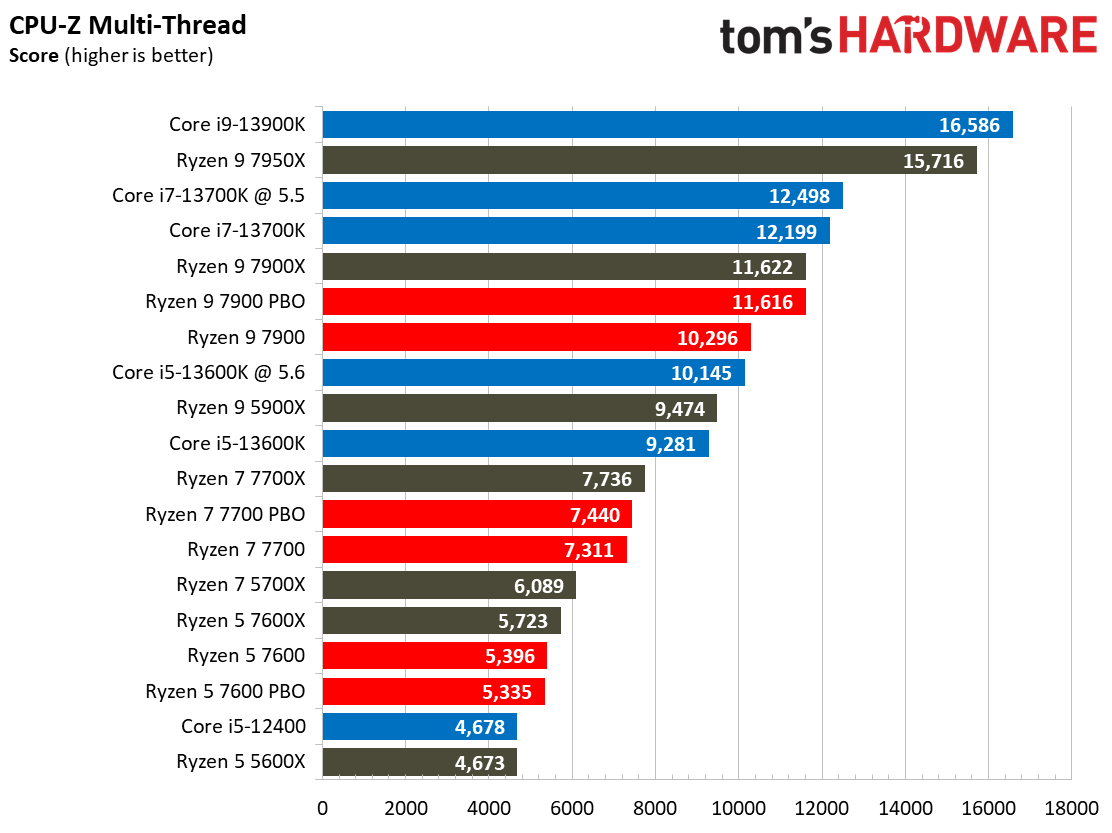

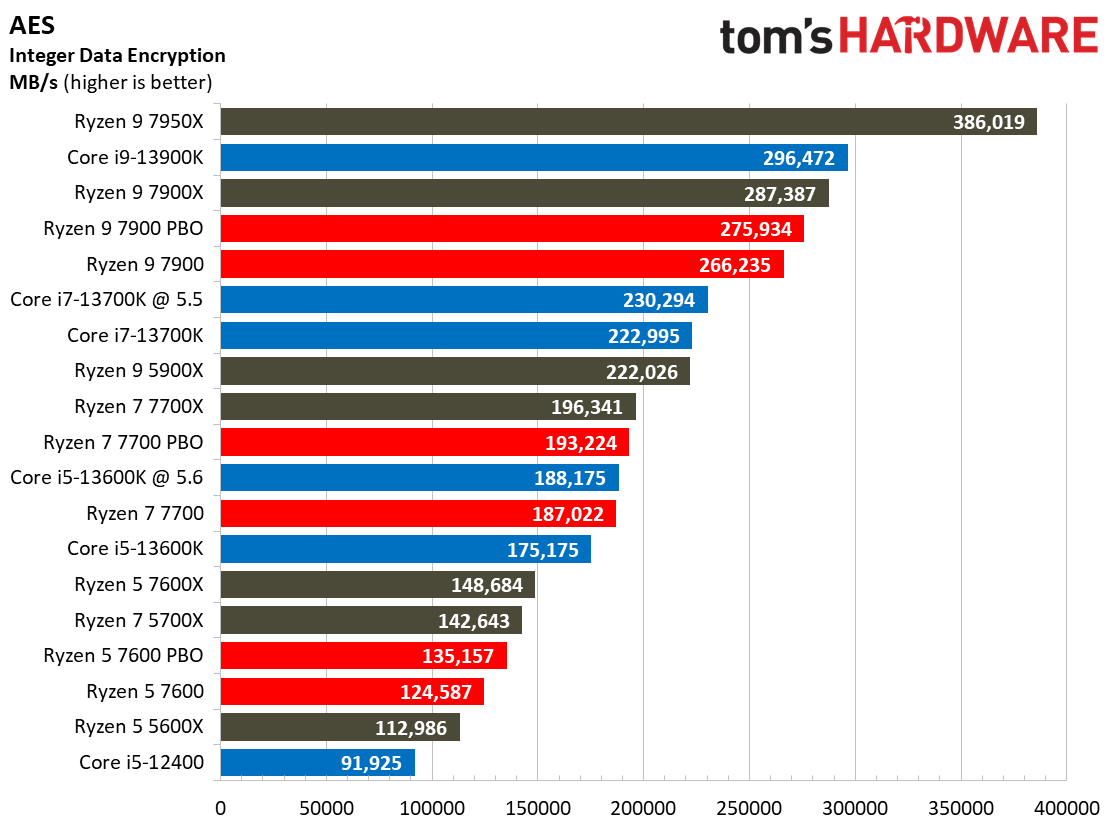
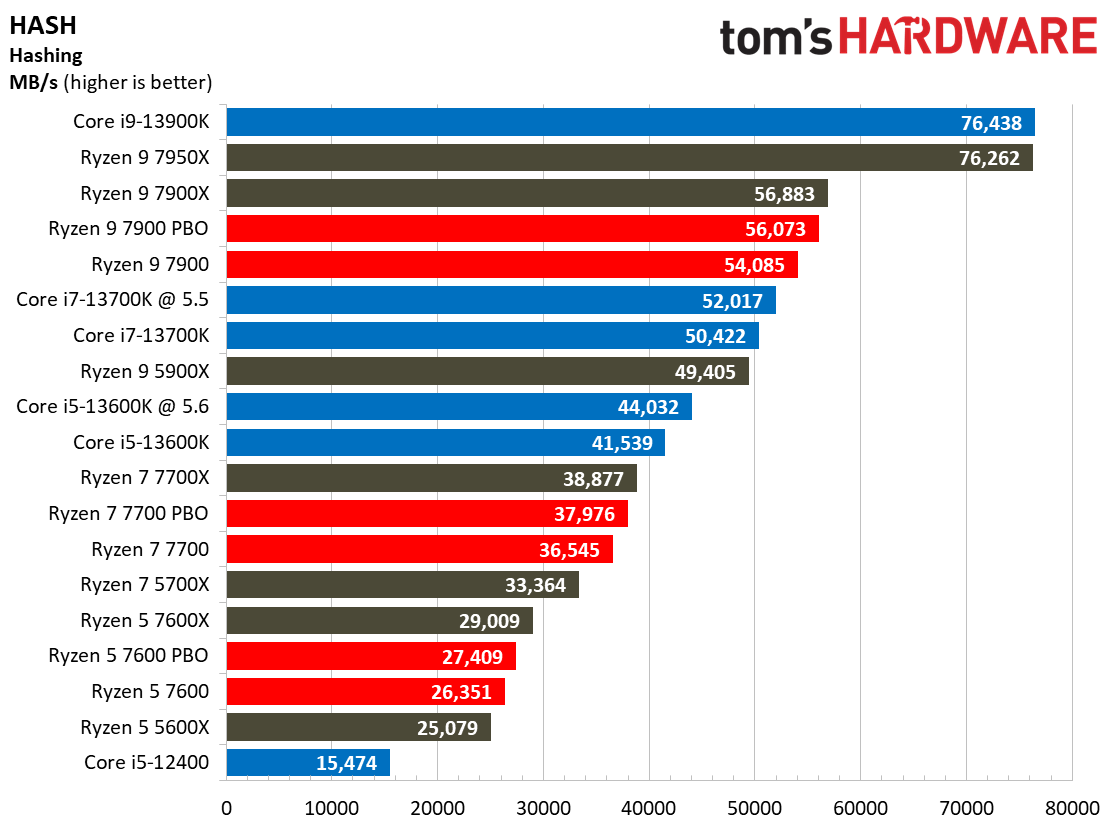
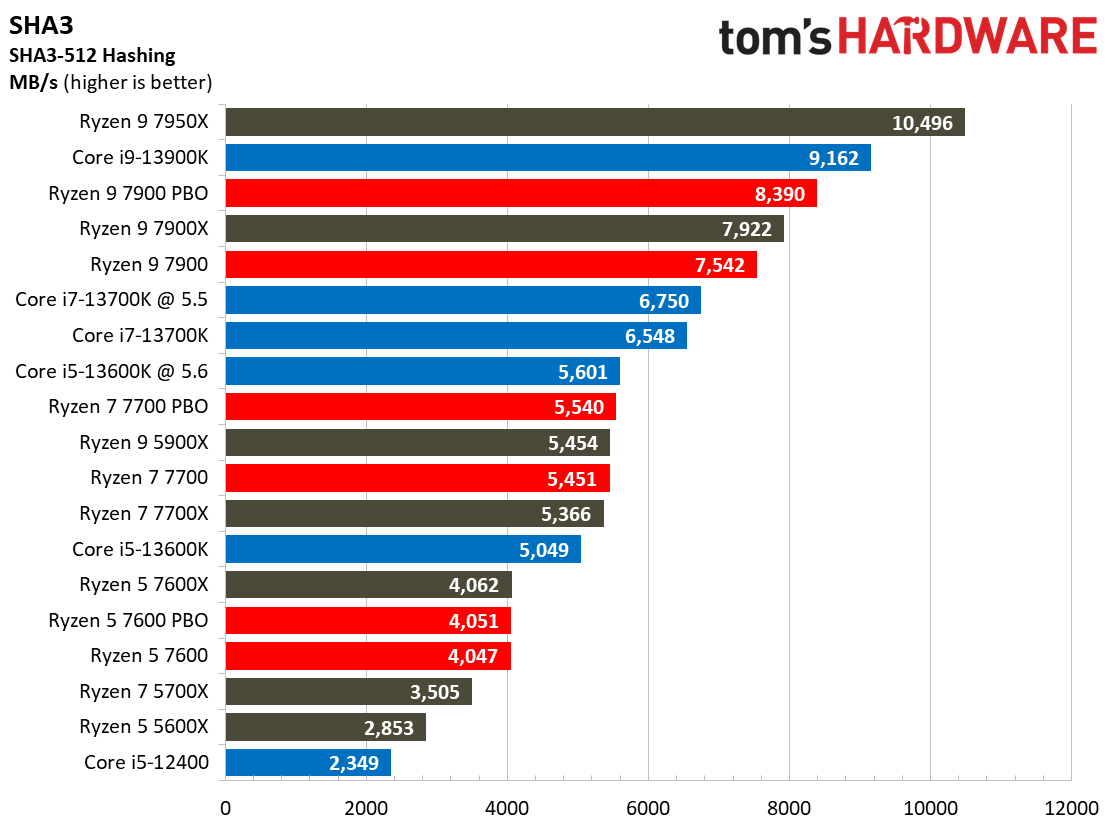

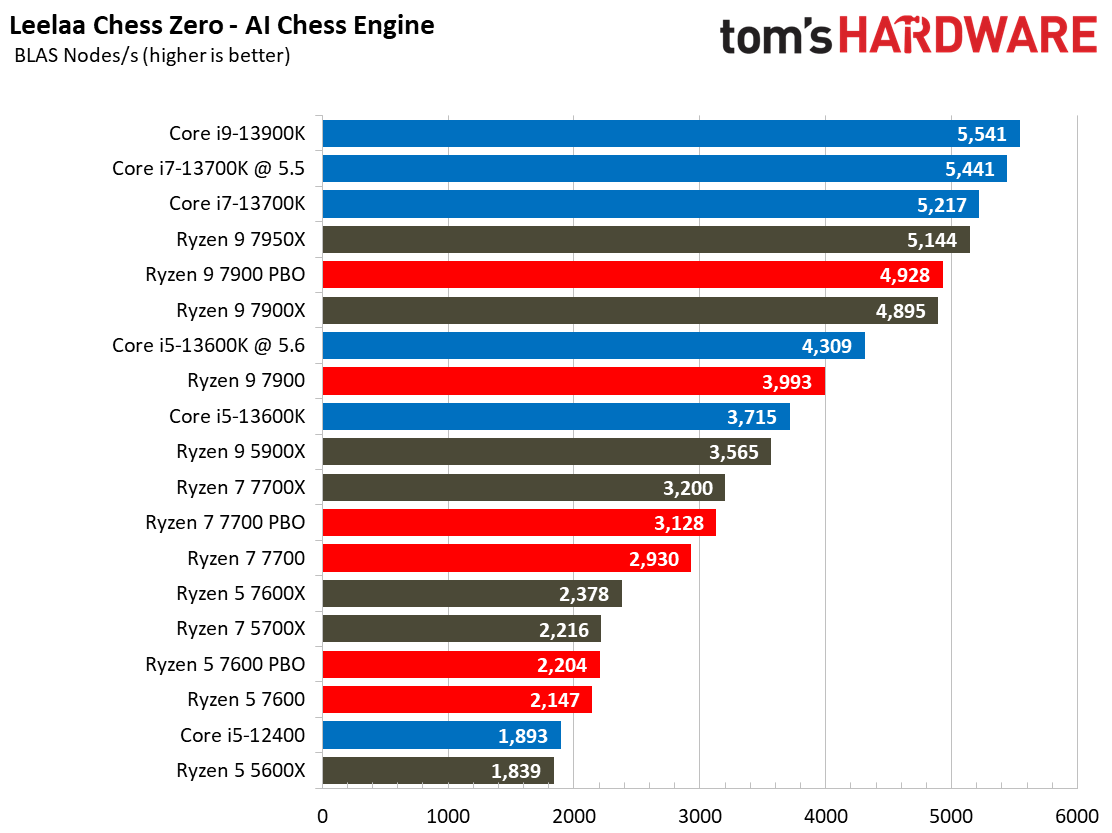
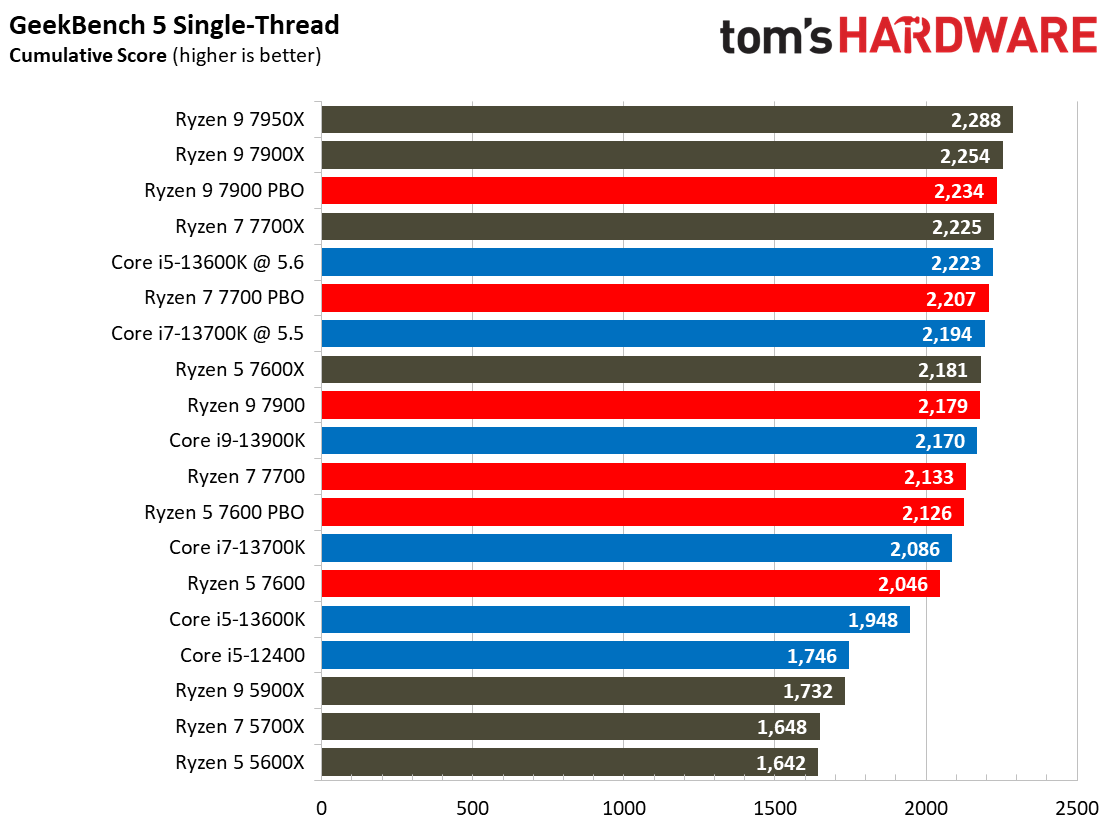
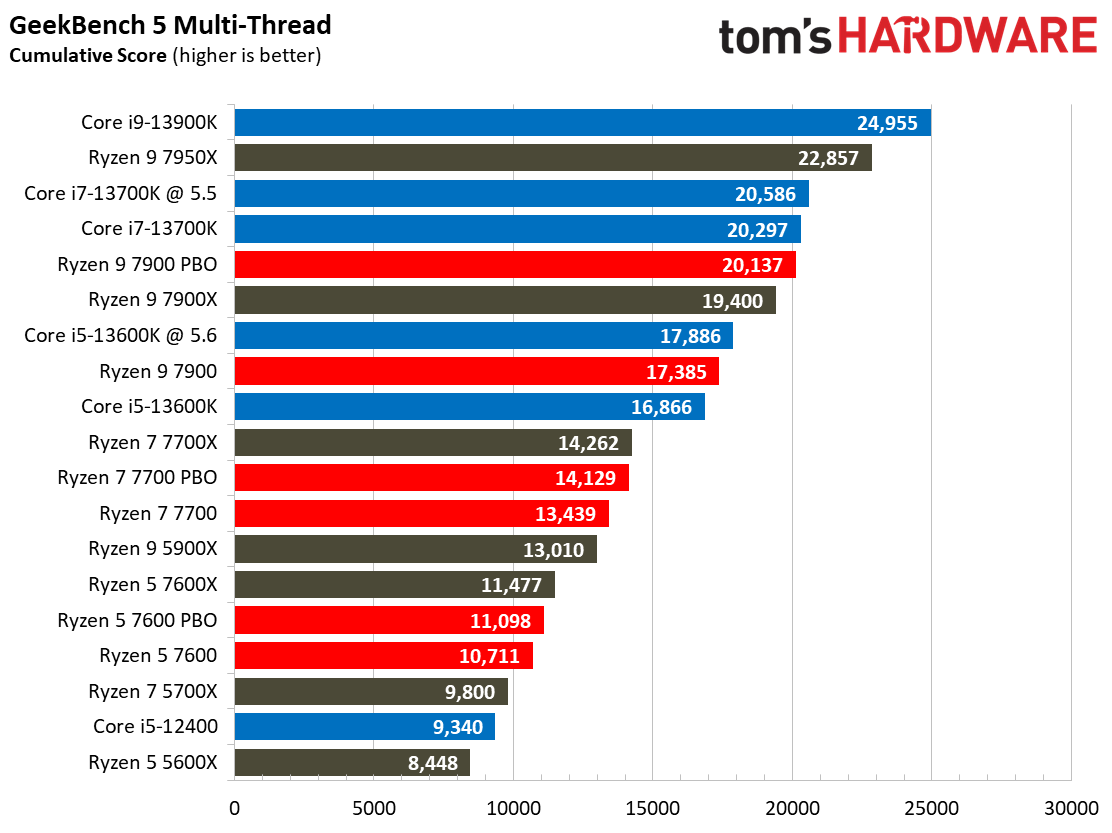
This selection of tests runs the gamut from the exceedingly branchy code in the LLVM compilation workload to the massively parallel molecular dynamics simulation code in NAMD to encryption and compression/decompression performance.
Y-cruncher computes Pi with the AVX instruction set, making for an exceedingly demanding benchmark. We employed the latest version of y-cruncher that has added support for Zen 4, and here the benefits of AVX-512 become apparent in the single-threaded benchmark as the Ryzen 7000 chips lead. Spreading the workload out among the cores in the threaded portion of the y-cruncher test results in lower performance for the Ryzen chips, likely due to memory bandwidth and fabric limitations.
Power Consumption on Ryzen 5 7600, Ryzen 7 7700, Ryzen 9 7900
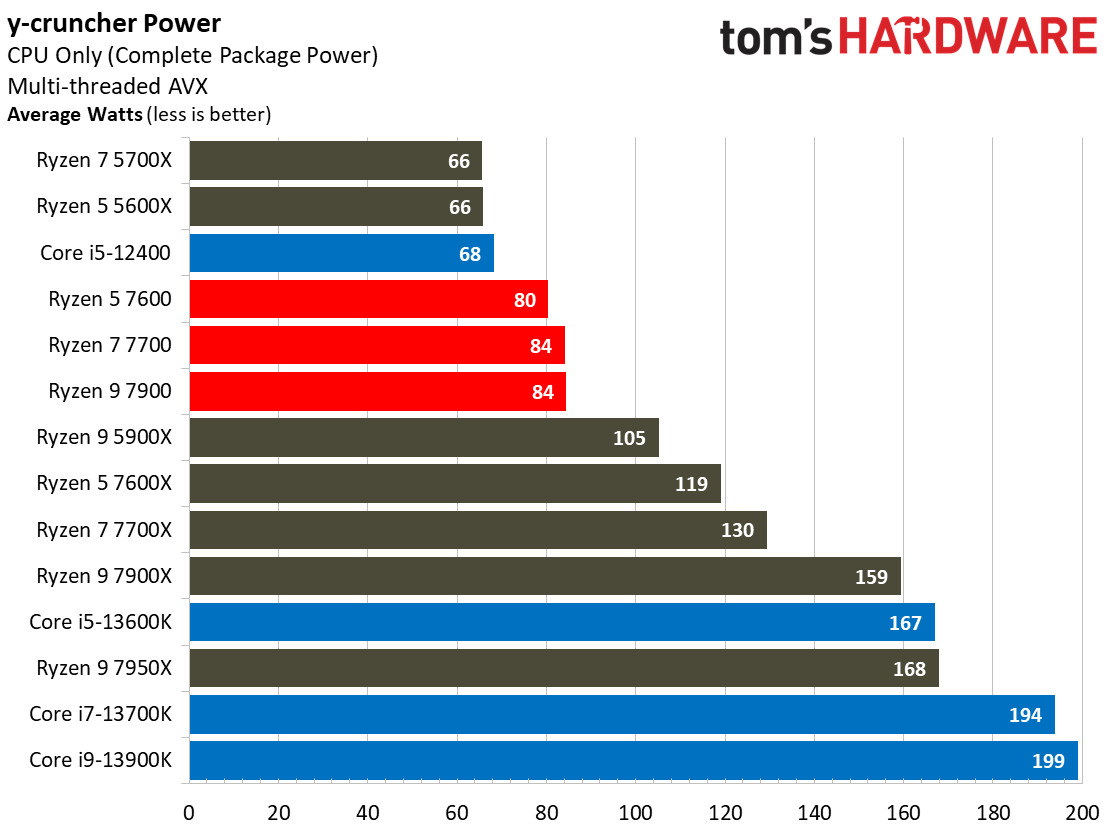
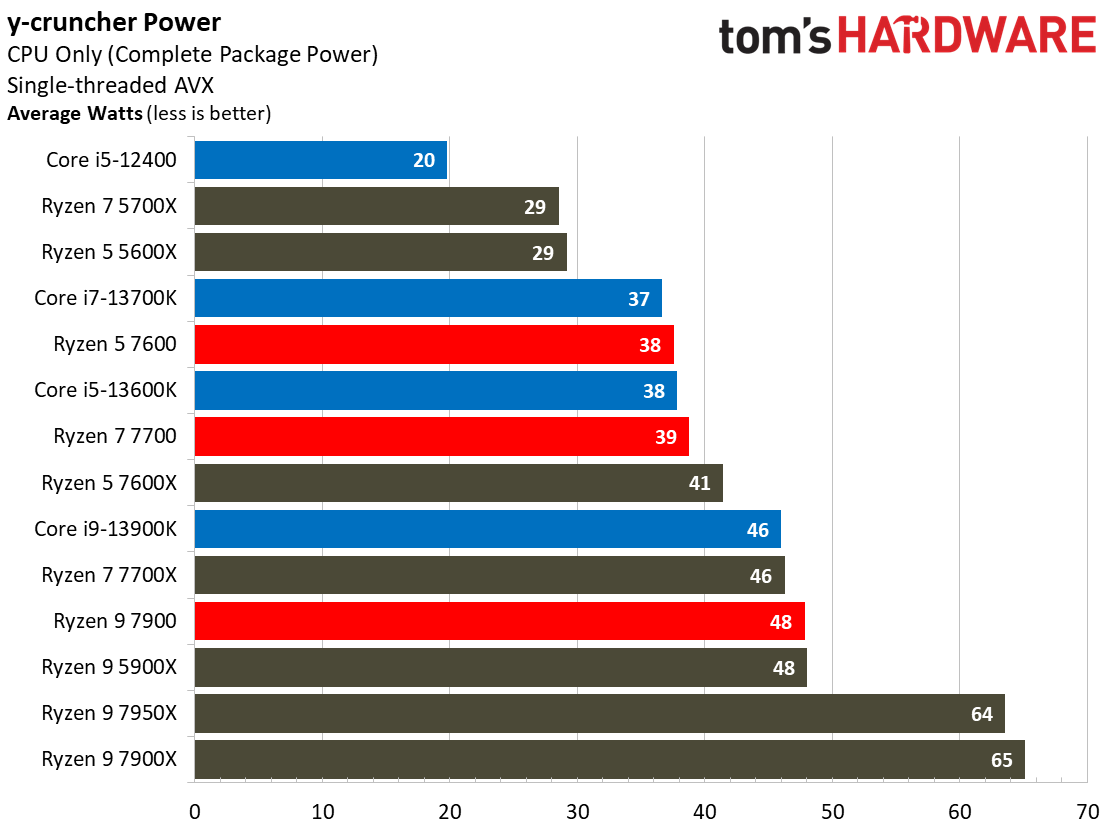
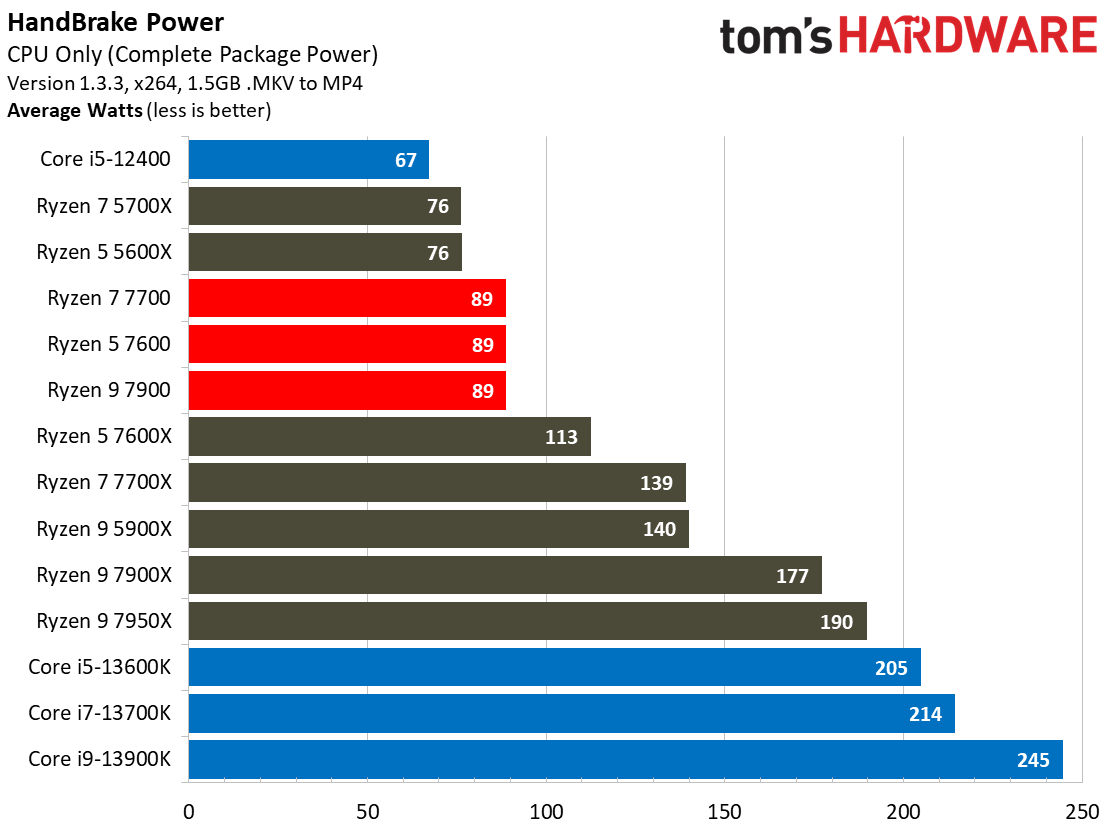
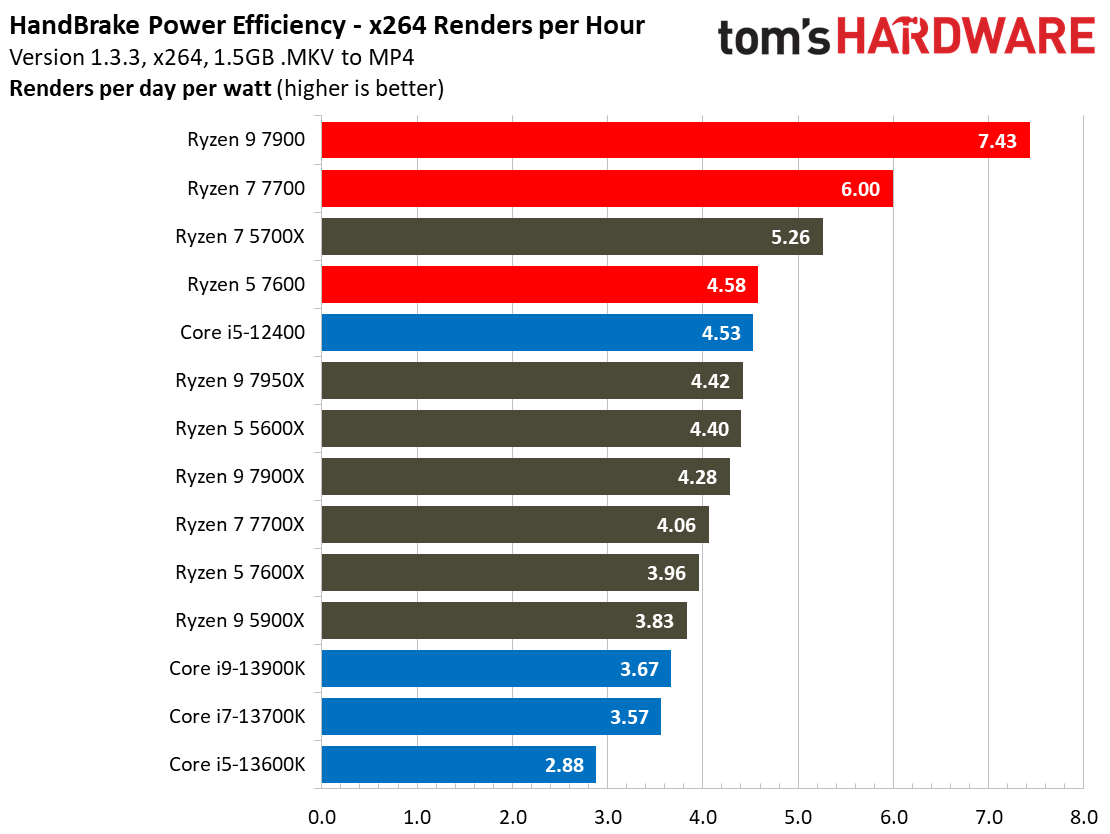
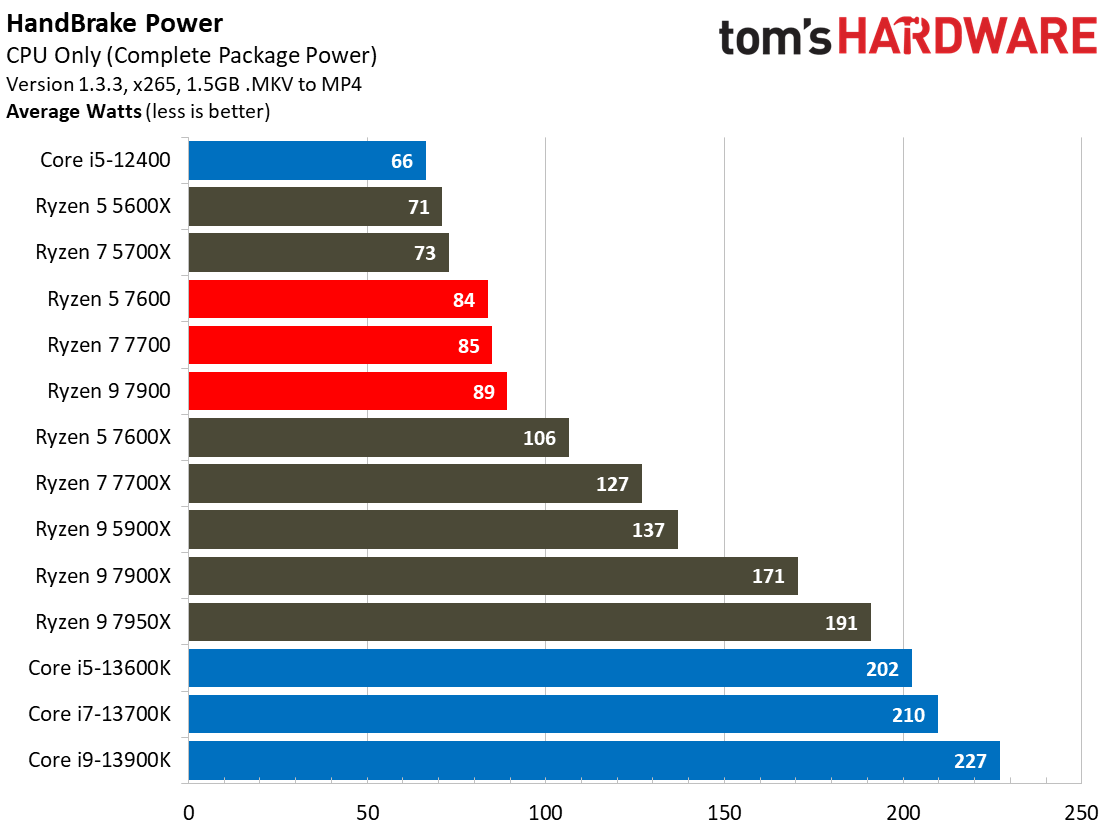
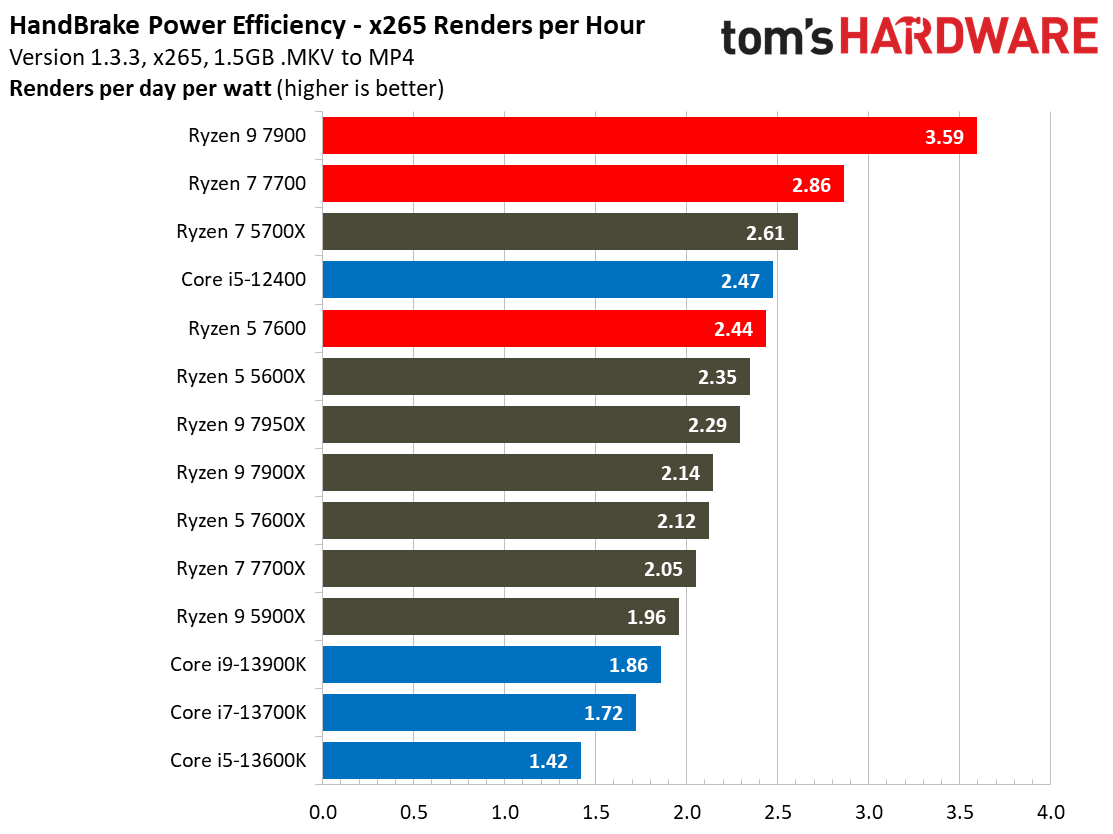
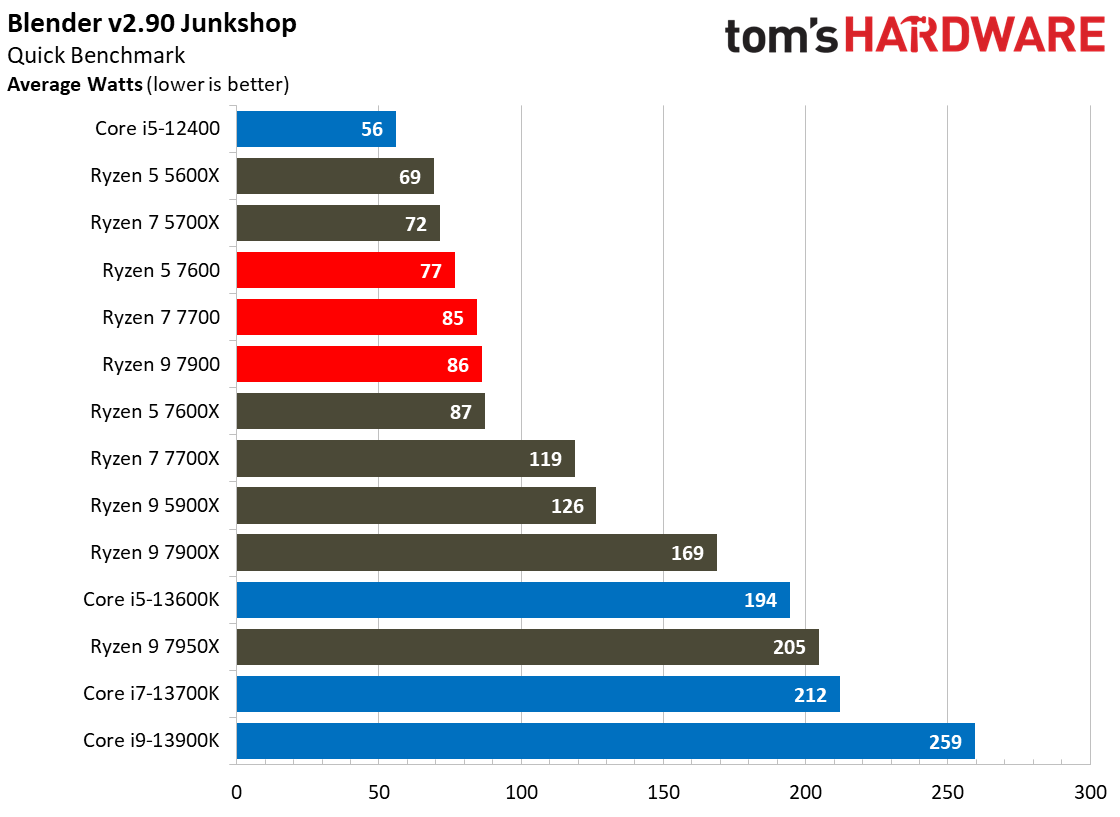
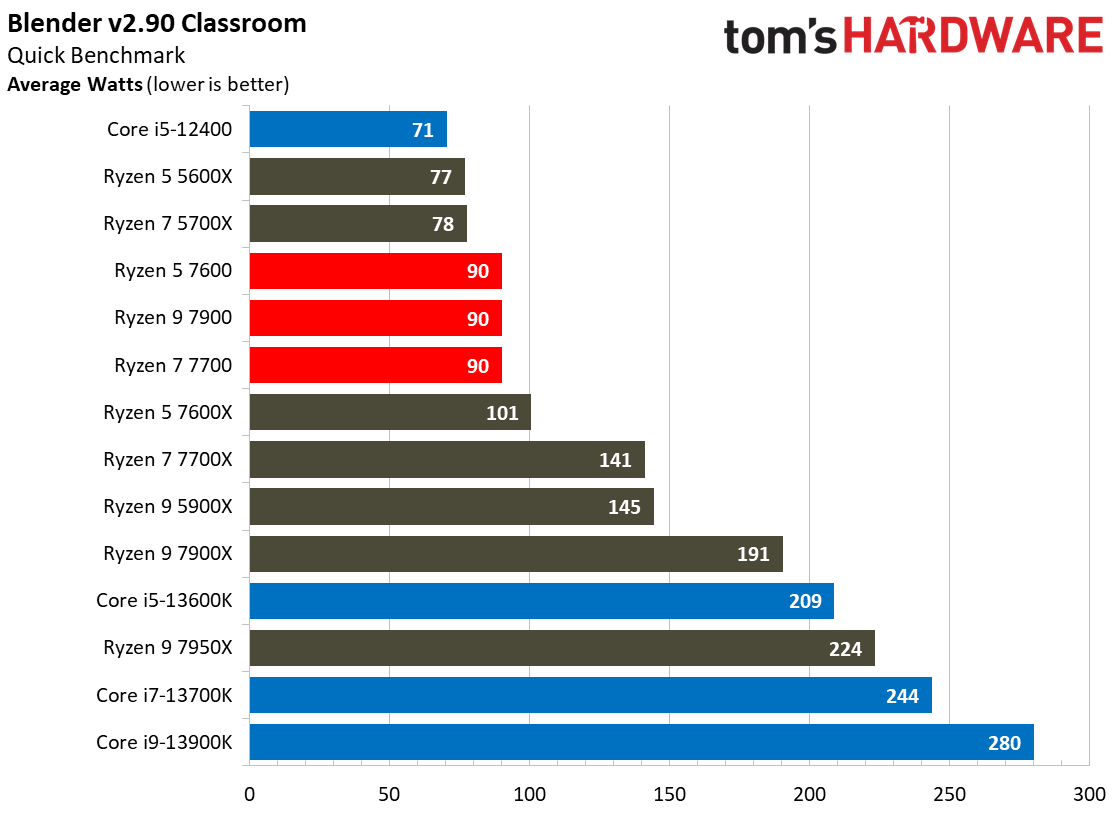
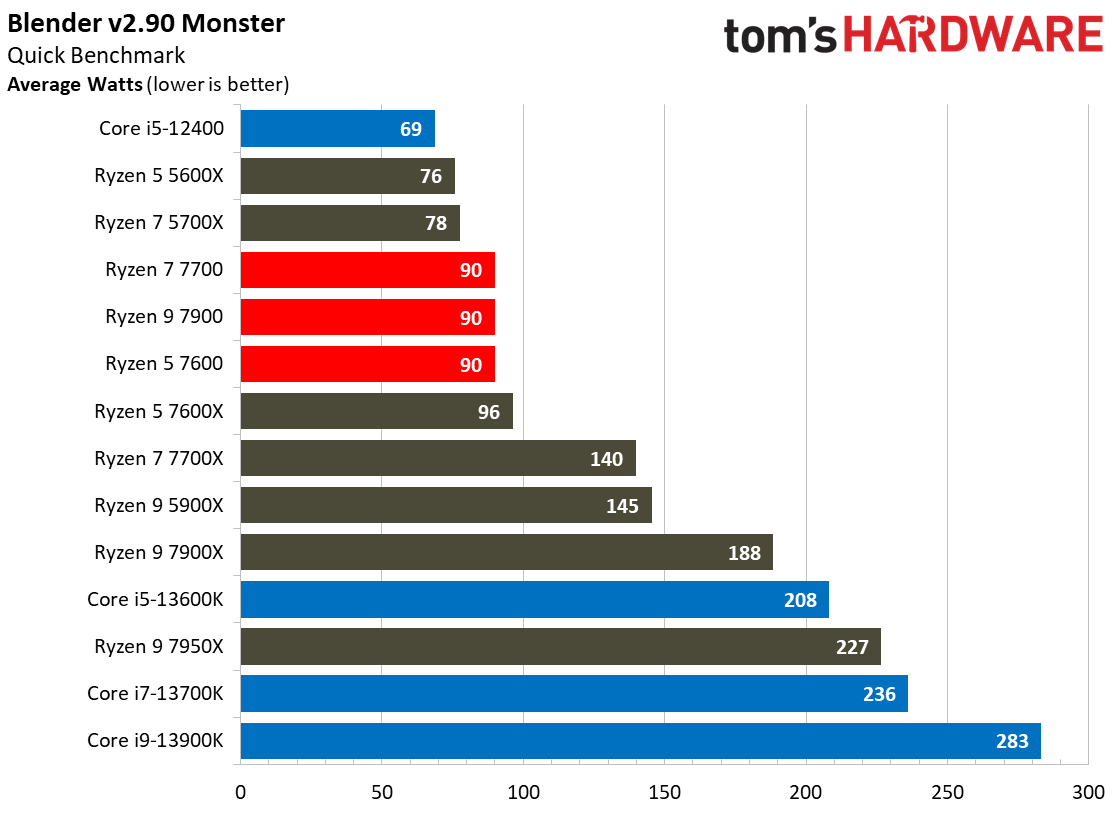




AMD has taken plenty of flak for dialing up the power limits for its X-series Ryzen 7000 models to compete with Intel's Raptor Lake, thus making the Zen 4 chips run hotter and consume more power than we've seen with previous-gen Ryzen chips. Dialing back the power limits to the 65W threshold contains the chip's power consumption, thus giving the Non-X models a more favorable spot on the voltage/frequency curve. That grants them the highest efficiency ratings in our test pool. The 12-core Ryzen 9 7900, in particular, has superb efficiency — nearly twice that of the nearly-identical 7900X — due to its lower power envelope.
Naturally, the 65W TDP and 88W limit of the Non-X Ryzen 7000 models help rein in heat. Even though they are designed to accommodate 95C temperatures just like the X-series chips, we didn't encounter ~95C temps with these models like we did with the 7950X.
Meanwhile, Intel's Raptor Lake has improved tremendously over the prior-gen Alder Lake, but they still suck more power, and thus generate more heat, than any of the Ryzen 7000 processors.
Overall, AMD has superior power consumption, efficiency, and thermal output, so you'll end up with a cooler and quieter system of you opt for Ryzen 7000.
Ryzen 5 7600, Ryzen 7 7700, Ryzen 9 7900 Overclocking, Benchmark Test Setup
We tested the Ryzen 7000 processors with an ASRock X670E Taichi motherboard. We used DDR5 memory with all Intel configurations, but you can find performance data for DDR4 configurations in our CPU Benchmark hierarchy. Notably, if you opt for DDR4 with the Raptor Lake processors, you'll lose a few percentage points of performance, on average (testing here).
Our overclocks were rather straightforward — we engaged two one-click overclocking features. First, we enabled the auto-overclocking Precision Boost Overdrive (PBO) feature with 'advanced motherboard' settings and adjusted the scalar setting to 10X. We then enabled the DDR5-6000 EXPO profile for the memory kit, which also automatically enables the AMD-recommended Auto setting for the fabric and a 1:1 ratio for the memory frequency and memory controller (Auto:1:1 is the recommended setting for memory overclocking with Ryzen 7000).
For our stock Intel tests, we're sticking with our standard policy of allowing the motherboard to exceed the recommended power limits, provided the chip remains within warrantied operating conditions. Almost all enthusiast-class motherboards come with similar settings, reflecting the out-of-box experience. So naturally, these lifted power limits equate to more power consumption and, thus, more heat.
Microsoft recently advised gamers to disable several security features to boost gaming performance. As such, we disabled secure boot, virtualization support, and fTPM/PTT for maximum performance. You can find further hardware details in the table at the end of the article.
Taking the Shine off Core i9
AMD's three new 65W 'Non-X' processors accomplish the goal of offering excellent efficiency within a lower power envelope. In keeping with tradition, these models also lower the pricing bar for entry to AMD's latest platform, while offering nearly the same performance as the more expensive X-series after engaging two single-click auto-overclocking mechanisms (PBO and EXPO).
Below, we have the geometric mean of our gaming test suite at 1080p and 1440p and a cumulative measure of performance in single- and multi-threaded applications. We conducted our gaming tests with an Nvidia RTX 4090, so performance deltas will shrink with lesser cards and higher resolution and fidelity settings.






The new Ryzen 7000 chips trade peak performance for exceptional efficiency in their stock configuration, but engaging the auto-overclocking features bought the Non-X models up to near-parity with the pricier X-series models in gaming, single- and multi-threaded benchmarks. That makes the chips great all-rounders — you can use the stock 65W power settings if you're building a low-power system like an HTPC or space-constrained SFF build, or dial up the power limits to use the chips in high-performance gaming and productivity rigs.
The new Non-X chips aren't a complete slam dunk, though. While these chips improve the price-to-performance ratio of the Ryzen 7000 series, they don't make any meaningful changes to the performance hierarchy relative to Intel's chips: Raptor Lake still leads in almost all performance metrics.
The new Ryzen chips are a natural pairing for lower-cost motherboards, but AMD's AM5 platform remains besieged by higher pricing than we'd expect for the traditionally value-focused B-series motherboards. Also, for the first time in years, you can't opt for a previous-gen AMD motherboard to save some cash — AM5 is still on its first generation of chipsets. You'll also need to purchase pricey DDR5 memory for the Ryzen 7000 processors, which isn't a great pairing with chips in this price range. This could be a dealbreaker if DDR5 pricing doesn't plummet in the coming months.
In contrast, you can opt for an Intel chip, a less expensive motherboard, and affordable DDR4 memory, yet still come out ahead on performance. That's a hard combination to beat. Raptor Lake is also compatible with previous-gen motherboards if they have the right BIOS, and performance will be the same between 600- and 700-series if the power delivery is identical. Intel is also rumored to have one more series of 'Raptor Lake Refresh' chips destined for its current platform, so you might have forward compatibility, too.
AMD's AM5 platform is young, but the company plans to support the socket until '2025+,' so you'll have the opportunity to upgrade to faster chips in the future (bear in mind there's no guarantee AMD will be in the lead then). AMD also includes a cooler with all three of the Non-X models, improving the value proposition. The 65W Ryzen 7000 chips also have exceptional power efficiency compared to Intel's K-series chips, but we have yet to compare them to Intel's new 65W models.
We think AMD's suggested pricing for a few of these chips won't survive long: There's only a $20 difference between the Ryzen 7 7700 and Ryzen 5 7600 and their X-series counterparts, so we expect the pricing of those two CPUs to quickly fall at retail.
If you're looking for higher-performance models, AMD has three 3D V-cache Ryzen 7000X3D chips slated for release next month, and they're widely expected to take the lead in gaming. Intel also has a 6 GHz special edition Raptor Lake waiting in the wings.
For now, Intel retains the performance and platform pricing advantage, but the company recently increased the pricing for its 12th-Gen processors by 10%. Those older processors are now more expensive than Intel's new 13th-Gen models, and the company has said it will raise chip pricing this year, so we can expect Raptor Lake to get a price increase over the coming months. That makes it hard to give firm purchasing advice, particularly since we haven't yet tested the competing 65W Intel processors. We'll update this review as soon as we have the chips in hand.
The 65W Ryzen 7000 chips go a long way to reducing the barriers to entry for the AM5 platform, and if the pricing is right, they could make a compelling alternative to Intel's faster chips. However, pricing is currently volatile, so make sure to check for updated pricing before pulling the trigger.
| Intel Socket 1700 DDR5 (Z790) | Core i9-13900K, i7-13700K, i5-13600K |
| Row 1 - Cell 0 | MSI MPG Z790 Carbon WiFi |
| Row 2 - Cell 0 | G.Skill Trident Z5 RGB DDR5-6800 - Stock: DDR5-5600 | OC: XMP DDR5-6800 |
| AMD Socket AM5 (X670E) | Ryzen 9 7900, Ryzen 7 7600, Ryzen 5 7600, Ryzen 9 7950X, Ryzen 9 7900X, Ryzen 5 7600X |
| Row 4 - Cell 0 | ASRock X670E Taichi |
| Row 5 - Cell 0 | G.Skill Trident Z5 Neo DDR5-6000 - Stock: DDR5-5200 | OC/PBO: DDR5-6000 |
| Intel Socket 1700 DDR5 (Z690) | Core i5-12400 |
| Row 7 - Cell 0 | MSI MEG Z690 Ace |
| Row 8 - Cell 0 | G.Skill Trident Z5 DDR5-6400 - Stock: DDR5-4400 | OC DDR5-6000 |
| AMD Socket AM4 (X570) | Ryzen 9 5950X, 5900X, 5700X, 5600X, 5800X3D |
| MSI MEG X570 Godlike | |
| Row 11 - Cell 0 | 2x 8GB Trident Z Royal DDR4-3600 - Stock: DDR4-3200 | OC/PBO: DDR4-3800 |
| All Systems | Asus RTX 4090 ROG Strix OC |
| Row 13 - Cell 0 | Gigabyte GeForce RTX 3090 Eagle - ProViz applications |
| Row 14 - Cell 0 | Nvidia GeForce RTX 2080 Ti FE - Application tests |
| 2TB Sabrent Rocket 4 Plus, Silverstone ST1100-TI, Open Benchtable, Arctic MX-4 TIM, Windows 11 Pro | |
| Cooling | Corsair H115i, Custom loop |
| Overclocking note | All configurations with overclocked memory also have tuned core frequencies and/or lifted power limits. |
- MORE: AMD vs Intel
- MORE: Zen 4 Ryzen 7000 All We Know
- MORE: Raptor Lake All We Know

Paul Alcorn is the Editor-in-Chief for Tom's Hardware US. He also writes news and reviews on CPUs, storage, and enterprise hardware.
-
zecoeco Aside from the performance, these chips are exceptionally power efficient.Reply
The reason for this performance gap in multi-threaded benchmarks is the lack of a hybrid architecture (more cores), and intel is in advantage for that
I expect Zen 5 to adapt the LITTLE.big architecture, yes, late but hopefully a much better implementation than intel's.
The combination of dense Zen4c cores and Zen5 cores will be exciting. -
baboma @Paul Alcorn: Did you test the non-X CPUs w/ the bundled coolers? What were their thermal numbers? TIA.Reply
Edit: I don't see a test bench configuration for AMD CPUs? Also, test bench for Intel is mislabeled as for 12th-gen. -
baboma I'm taking the Amazon pricing as a benchmark, as other vendors (read: NewEgg) tend to follow Amazon pricing.Reply
Apparently, 7900X and 7600X pricing are now raised back to original MSRP, while the 7700X remains at the $345 sale price. If this holds, the article's assumption, that the non-X CPUs' street pricing will drop from MSRP, will not likely happen.
7900X https://camelcamelcamel.com/product/B0BBJ59WJ4
7700X https://camelcamelcamel.com/product/B0BBHHT8LY
7600X https://camelcamelcamel.com/product/B0BBJDS62N
Also, no low-end Ryzen 3. -
-Fran- Thanks for the review!Reply
As per in other times: could you also offer DDR4 benches alongside whenever you claim "but Intel also supports DDR4" when talking prices. Or at least a reference to an article doing a deep dive in for the DDR5 and DDR4 differences with Intel 13th gen and 12th gen. Specially the i5 and i7 parts. I know you've done it for the i9, but the i9 has higher cache, so it can hide latency and bandwidth differences ever-so-slightly better.
Also, Intel, it seems, didn't sample the press their non-K parts and they've already released them. It also seems they've cut down cache in some models which may impact their performance (hence "value"). Will you bench some of them any time soon?
Regards. -
salgado18 Reply
AMD doesn't need big.LITTLE. Just look at the Ryzen 9 7900 vs the Core i7-13700. Both have a base TDP of 65W, but while the Ryzen can keep clock speeds of 3.7GHz, the Intel needs to lower down to 2.0/1.5GHz. If such a Ryzen lowers down to 2.0GHz, it could be below 40W. big.LITTLE is just Intel trying to keep up with their powerful OR efficient cores, against AMD's powerful AND efficient cores.zecoeco said:Aside from the performance, these chips are exceptionally power efficient.
The reason for this performance gap in multi-threaded benchmarks is the lack of a hybrid architecture (more cores), and intel is in advantage for that
I expect Zen 5 to adapt the LITTLE.big architecture, yes, late but hopefully a much better implementation than intel's.
The combination of dense Zen4c cores and Zen5 cores will be exciting.
Which makes me mad that there are so few mobile offerings using Ryzens. Is Intel offering their chips for free (again) or something? -
Elusive Ruse Reply
This is the only comparison I have found yet.-Fran- said:Thanks for the review!
As per in other times: could you also offer DDR4 benches alongside whenever you claim "but Intel also supports DDR4" when talking prices. Or at least a reference to an article doing a deep dive in for the DDR5 and DDR4 differences with Intel 13th gen and 12th gen. Specially the i5 and i7 parts. I know you've done it for the i9, but the i9 has higher cache, so it can hide latency and bandwidth differences ever-so-slightly better.
Also, Intel, it seems, didn't sample the press their non-K parts and they've already released them. It also seems they've cut down cache in some models which may impact their performance (hence "value"). Will you bench some of them any time soon?
Regards.
e5X0RuduRdUView: https://youtu.be/e5X0RuduRdU -
Coffee Fueled Curmudgeon Motherboard makers still going to make damn sure they cover the costs of AMD supporting a platform for longer than they'd like.Reply
The upfront sting to offset people holding on to the board for longer isn't going away, it pretty obviously a response to the sales impact of longevity.
Looking forward to seeing the comparisons for budget builds between the 13500 and 7600 given how strong the 13400 is in terms of trading blows with more expensive chips.
Even some £200 motherboards (that aren't gash) would be nice.... -
RodroX mmmmm, if zen 4 mobos goes down in price, and you are not in a hurry, will you still go and buy one of this new 7000 cpus?, knowing what the 7000 X3D may bring to table (specially gaming wise).....Reply
Perhaps only as a place holder till the new X3D comes out.
But I still don't see any reason to buy AM5 with the high platform price. And don't get me wrong, I would love to have a faster CPU than my beloved R5 3600 in a newer platform. I could use more performance in some tasks. I just don't feel like getting a new CPU for my end of the road AM4 system. And intel is a end of the road platform too. -
-Fran- Reply
Sorry to say, but that doesn't make much sense... If you're not in need for more I/O or need PCIe4/5 for something specific, slapping a 5800X3D will give you 2 gens worth of CPU performance for about half the cost of a platform upgrade (similar priced CPU+DDR5+MoBo).RodroX said:mmmmm, if zen 4 mobos goes down in price, and you are not in a hurry, will you still go and buy one of this new 7000 cpus?, knowing what the 7000 X3D may bring to table (specially gaming wise).....
Perhaps only as a place holder till the new X3D comes out.
But I still don't see any reason to buy AM5 with the high platform price. And don't get me wrong, I would love to have a faster CPU than my beloved R5 3600 in a newer platform. I could use more performance in some tasks. I just don't feel like getting a new CPU for my end of the road AM4 system. And intel is a end of the road platform too.
I don't disagree with waiting for the new VCache versions, but if you don't want to spend the extra money, I don't see why it's so bad to just get the 5800X3D now and skip 2 more gens.
Regards. -
RodroX Reply-Fran- said:Sorry to say, but that doesn't make much sense... If you're not in need for more I/O or need PCIe4/5 for something specific, slapping a 5800X3D will give you 2 gens worth of CPU performance for about half the cost of a platform upgrade (similar priced CPU+DDR5+MoBo).
I don't disagree with waiting for the new VCache versions, but if you don't want to spend the extra money, I don't see why it's so bad to just get the 5800X3D now and skip 2 more gens.
Regards.
I want, and I indeed need more connectivity. Sadly more than my current mobo can deliver. So the 5800X3D is not an option by itself.
If I had a 570/550 mobo, perhaps. Besides where I live the 5800X3D is almost imposible to get. And when available, way more expensinve than it should.